

400+ Words to Describe a Flower Garden: Best Writers Guide
How you describe a flower garden can capture a reader’s imagination. Choosing the right words can make your garden descriptions truly bloom.
Here is a quick summary of words to describe a flower garden:
Words to describe a flower garden include colorful terms like “vibrant,” “lush,” and “fragrant,” atmospheric words such as “tranquil” or “enchanting,” and specific descriptors related to time, size, culture, and types of flora. Examples include “dawn-lit,” “sprawling,” “exotic,” and “rose-filled.”
This article presents 400+ words to describe flower gardens, categorized into distinct categories to make them easy to find and use.
Words to Describe the Colors in a Flower Garden

Table of Contents
The colors in a garden make it a feast for the eyes.
Here are some color words that can help you show your reader a flower garden in a really clear, bright way:
- Azure : It’s like the bright, awesome blue you see in the sky on a perfect summer day.
- Crimson : Deep, vibrant red.
- Ebony : Dark black, often used to describe shadows or dark soil.
- Emerald : Bright, rich green typical of healthy leaves or grass.
- Ivory : Off-white color, often used to describe pale flowers or light reflecting off petals.
- Mauve : A pale purple color.
- Scarlet : A bright, intense red.
- Sepia : A reddish-brown color, like dried leaves.
- Amber : A warm, golden color.
- Cerulean : A deep, sky-blue color.
- Lavender : A soft, pale violet.
- Tangerine : A bright, orange color.
- Teal : A medium to dark greenish-blue.
- Coral : A pink-orange color.
- Onyx : A shiny black.
- Sapphire : A deep blue.
- Canary : A bright yellow.
- Ochre : A light, earthy brown.
- Fuchsia : A vibrant pink-purple color.
- Pewter : A bluish-gray color.
- Jade : A rich, green color.
- Umber : A natural brown or reddish-brown.
- Auburn : A reddish-brown color.
- Vermilion : A bright red or scarlet.
- Periwinkle : A soft, purplish-blue color.
Words to Describe the Textures in a Flower Garden
Describing the various textures in a garden can make it feel more tangible and real to the reader.
Some texture-related words include:
- Velvety : Smooth and soft, like the petals of certain flowers.
- Prickly : Sharp and rough, like a thorny stem.
- Gossamer : Delicate and thin, like a spider’s web or fine petals.
- Gritty : Rough and grainy, like the feel of soil.
- Waxy : Smooth and glossy, like the surface of some leaves.
- Feathery : Soft and airy, like a feather.
- Leathery : Tough and durable, like an old leaf.
- Silky : Smooth and glossy, like silk.
- Grainy : Coarse, like sand.
- Spongy : Soft and porous, like a mushroom.
- Bristly : Rough, covered with short stiff hairs.
- Rough : Not smooth or even.
- Furry : Covered with a coat of soft hair.
- Slick : Having a smooth, glossy surface.
- Papery : Thin and dry, like paper.
- Crumbly : Breaking apart easily, like dry soil.
- Dewy : Wet with dew or moisture.
- Flaky : Coming off in thin pieces or layers.
- Gummy : Sticky and viscous.
- Netted : Covered with a network of raised lines.
- Satiny : Smooth, glossy, and silky.
- Threadbare : Thin and worn.
- Downy : Covered with fine soft hairs or feathers.
- Bumpy : Covered with high spots or lumps.
- Smooth : Having an even and regular surface.
Words to Describe the Scents in a Flower Garden
Scents are an integral part of a garden’s allure. They can trigger powerful memories and emotions in readers.
Here are some words that describe scents:
- Fragrant : A pleasant, sweet smell.
- Musky : A heavy, earthy smell.
- Citrusy : Fresh and tangy, like lemons or oranges.
- Spicy : Pungent and warming, like cloves or cinnamon.
- Herbaceous : Fresh and green, like newly cut grass or crushed leaves.
- Woody : Like the smell of fresh cut wood or bark.
- Earthy : Smelling of damp soil or wet earth.
- Floral : Having the smell of fresh flowers.
- Pungent : Having a strong, sharp smell.
- Sweet : Similar to the smell of sugar or honey.
- Minty : Fresh and crisp, like mint.
- Fruity : Smelling like fresh fruit.
- Piney : Resinous, like a pine tree.
- Musky : A strong, heavy smell, often considered sensual.
- Fresh : A clean, cool smell.
- Acrid : Sharp or biting to the taste or smell.
- Moldy : Smelling of dampness and decay.
- Smokey : Like the smell of smoke.
- Vanilla : Sweet and creamy, like vanilla.
- Cinnamon : Spicy, sweet, and warm.
- Salty : Reminiscent of sea air.
- Peppery : Sharp or spicy, like pepper.
- Nutty : Resembling the smell of fresh nuts.
- Grassy : Smelling of fresh-cut grass.
- Balmy : Mild and refreshing.
Words to Describe the Sounds in a Flower Garden
The sounds in a garden can provide a sense of peace and tranquility.
The following words can help you describe these sounds:
- Buzzing : A busy, humming sound, like bees or insects.
- Rustling : A soft, whispering sound, like leaves in the wind.
- Trilling : A high, quivering sound, like a bird’s song.
- Babbling : A gentle, flowing sound, like a small garden stream.
- Crunching : A crisp, breaking sound, like footsteps on gravel.
- Swooshing : A sound of rushing or sweeping.
- Humming : A low, continuous, droning sound.
- Singing : Melodious or harmonic sound.
- Squeaking : A short, high-pitched sound.
- Murmuring : A soft, low sound.
- Creaking : A high-pitched, scraping sound.
- Whooshing : A swift, rushing sound.
- Peeping : A short, high-pitched sound, like a small bird.
- Whispering : A soft, hushed sound.
- Gurgling : A bubbling, liquid sound.
- Tinkling : A light, clear, ringing sound.
- Rustle : A soft, fluttering sound.
- Splashing : The sound of water being disturbed.
- Chirping : A short, sharp, high-pitched sound.
- Hissing : A sharp, sibilant sound.
- Purring : A low, vibrating sound.
- Warbling : A melodious, fluid series of sounds.
- Droning : A continuous, low humming sound.
- Fluttering : A rapid, vibrating sound.
- Rumbling : A deep, heavy, continuous sound.
Words to Describe the Mood of a Flower Garden
The overall mood or atmosphere of a garden can be a powerful element in your story.
Here are a few words that can help set the mood:
- Serene : Peaceful and calm.
- Mystical : Full of mystery and magic.
- Lush : Abundantly green and healthy.
- Rustic : Simple and rural, often charmingly so.
- Decadent : Luxurious and indulgent, often to excess.
- Whimsical : Playfully quaint or fanciful.
- Ethereal : Extremely delicate and light, almost otherworldly.
- Melancholic : A deep, pensive sadness.
- Romantic : Marked by expressions of love or affection.
- Euphoric : Intense excitement and happiness.
- Nostalgic : A wistful desire to return to a past time.
- Tranquil : Free from disturbance, calm.
- Gloomy : Partially or totally dark, especially dismal and depressing.
- Exuberant : Filled with lively energy and excitement.
- Meditative : Absorbed in deep thought.
- Foreboding : A feeling that something bad will happen.
- Radiant : Sending out light, shining, or glowing brightly.
- Dreary : Dull, bleak, and lifeless.
- Joyful : Feeling, expressing, or causing great pleasure and happiness.
- Reverent : Feeling or showing deep and solemn respect.
- Optimistic : Hopeful and confident about the future.
- Pensive : Engaged in, involving, or reflecting deep serious thought.
- Inspiring : Having the effect of inspiring someone.
- Relaxed : Free from tension and anxiety.
- Invigorating : Making one feel strong, healthy, and full of energy.
Describing Flower Gardens by Time of Day
The time of day can dramatically alter the garden’s atmosphere.
Sunrise, midday, sunset, and night each offer a different perspective, with varying lighting and activity levels in the garden.
- Dawn : When you first start seeing light in the sky before the sun comes up.
- Sunrise : When the sun first peeks out in the morning.
- Morning : The period of time from sunrise to noon.
- Midday : The middle part of the day; noon.
- Afternoon : The period of time between noon and evening.
- Twilight : The soft, diffused light from the sky when the sun is below the horizon.
- Dusk : The darker part of twilight.
- Sunset : The time in the evening when the sun disappears.
- Evening : The chill-out time from around 6 p.m. until you hit the sack.
- Nightfall : When it gets dark and the day officially calls it quits.
- Midnight : The middle of the night; twelve o’clock at night.
- Moonlit : Lit by the light of the moon.
- Starlit : Lit by the light of the stars.
- Golden Hour : That time just after the sun comes up or before it sets when the light is super soft and glowy.
- Crepuscular : Relating to twilight.
- Nocturnal : Active during the night.
- Matutinal : Of or occurring in the morning.
- Vespertine : Relating to, occurring, or active in the evening.
- Glimmering : Shining faintly with a wavering light.
- Illuminated : Provided with light; lit up.
- Shadowy : Full of or characterized by shadows.
- Silhouetted : Shown as a dark shape or outline against a lighter background.
- Radiant : Sending out light; shining brightly.
- Gleaming : Shining brightly.
- Luminescent : Emitting light not caused by heat.
Describing Flower Gardens by Size
The scale of the garden could be an essential factor in description.
Tiny, personal gardens may feel intimate and cozy, whereas vast, sprawling gardens can evoke a sense of grandeur or even bewilderment.
- Sprawling : Spread out over a large area in an untidy or irregular way.
- Expansive : Covering a wide area in terms of space.
- Vast : Of very great extent; enormous.
- Miniature : Much smaller than normal.
- Compact : Closely and neatly packed together; dense.
- Petite : Attractively small and delicate.
- Broad : Having a distance or expanse from side to side.
- Narrow : Small in breadth relative to length.
- Boundless : Unlimited or immense.
- Confined : Small and restricted.
- Spacious : Having ample space.
- Cramped : Feeling or causing someone to feel uncomfortably confined.
- Infinite : Limitless or endless.
- Restricted : Limited in extent, number, or scope.
- Massive : Large and heavy or solid.
- Tiny : Very small.
- Cozy : Makes you feel all snug and comfy, like you’re wrapped up in a warm blanket.
- Grand : Large and impressive in size.
- Minute : Extremely small.
- Rambling : Spreading or winding irregularly in various directions.
- Generous : Larger or more than usual in size.
- Diminutive : Extremely or unusually small.
- Extensive : Covering or affecting a large area.
- Secluded : (of a place) not seen or disturbed by others.
- Labyrinthine : (of a network) like a labyrinth; irregular and twisting.
Describing Flower Gardens in Different Cultures
Flower gardens look different across the globe due to cultural influences and local flora.
Japanese Zen gardens, English cottage gardens, or Arabian geometric gardens each have a distinct feel and appearance.
- Zen : A state of calm attentiveness (Japanese Zen Garden).
- Cottage : A cute little house, usually found close to a lake or beach (English Cottage Garden).
- Geometric : Characterized by or decorated with regular lines and shapes (Arabian Geometric Garden).
- Formal : Doing things by the book or really proper, like a garden a big-deal event.
- Tropical : It’s like the tropics – think hot, sticky, and humid.
- Mediterranean : Of or characteristic of the Mediterranean Sea, its climate, or the cultures bordering it.
- Exotic : Originating in or characteristic of a distant foreign country.
- Rustic : Having a simplicity and charm that is considered typical of the countryside.
- Oriental : Of, from, or characteristic of East Asia.
- Native : Belonging to a particular place by birth.
- Victorian : Of, relating to, or typical of the reign of Queen Victoria.
- Colonial : Of, relating to, or characteristic of a colony or colonies.
- Wildflower : A flower that just does its own thing, growing wherever it likes without any help from people.
- Indigenous : Born and bred in a certain place.
- French : About France, French people, or the French language (like in a French Formal Garden).
- Italian : Of or relating to Italy, its people, or their language (Italian Renaissance Garden).
- English : Of or relating to England or its people or language (English Landscape Garden).
- Japanese : Of or relating to Japan or its people or their language.
- Dutch : It’s all about things from the Netherlands, like the people, language, or even their famous tulip gardens.
- Desert : A landscape or region that receives an extremely low amount of precipitation.
- Rainforest : A lush, thick jungle with lots of different plants and animals, usually found in hot places where it rains a lot.
- Botanical : Of or relating to plants.
- Alpine : Of or relating to high mountains.
- American : Of or relating to the United States of America or its people or their language.
- Caribbean : Pertaining to the Caribbean Sea, its islands, or the surrounding lands.
Describing Flower Gardens by Type of Flora
A garden could be filled with a single type of flower, such as roses, or have a variety of different species.
Knowing how to describe different types of plants could help add authenticity to the story.
Consider these descriptive flower garden words:
- Rose : A spiky bush that usually has nice-smelling flowers in red, pink, yellow, or white.
- Orchid : A plant with fancy or weirdly shaped flowers.
- Lily : A plant with big, fragrant, trumpet-like flowers on a skinny stem.
- Carnation : A showy plant with double flowers, green-gray leaves, and pink, white, or red flowers.
- Daisy: A small plant that lives in grasslands and has yellow and white flowers.
- Sunflower : A tall plant with big, yellow flowers. It’s related to daisies.
- Tulip : A plant that has bright, cup-shaped flowers in the spring.
- Hydrangea : A bush or climber with round or flat groups of small flowers.
- Fern : A plant with no flowers, but feathery or leafy fronds.
- Ivy : A climbing plant that keeps its leaves all year round.
- Peony : A plant with large double flowers, native to Asia, North America, and southern Europe.
- Iris : A plant with sword-like leaves and showy flowers, typically purple or yellow.
- Marigold : A plant, related to daisies, usually with yellow, orange, or brownish flowers.
- Jasmine : A climbing plant, with fragrant flowers which are used to make perfume.
- Daffodil : A plant with bright yellow flowers that have a long, trumpet-like middle.
- Azalea : A shrub that loses its leaves but has brightly colored, sometimes fragrant flowers.
- Dahlia : A bushy plant with tubers, from Mexico and Central America.
- Lavender : A small shrub that smells nice and has narrow leaves and blue-purple flowers.
- Magnolia : A tree or shrub with big, usually pinkish, waxy flowers.
- Hibiscus : A plant with big, bright flowers, usually found in warm climates.
- Begonia : An ornamental plant with showy flowers of various hues, typically white, pink, or yellow.
- Geranium : A widely cultivated plant with brightly colored flowers.
- Wisteria : A climbing shrub with clusters of sweet-smelling flowers.
- Camellia : A shrub with glossy evergreen leaves and waxy, typically red flowers.
- Zinnia : A brightly colored flowering plant, with heads of large long-lasting petals.
Describing Flower Gardens in Mystery
Here are some words to describe a flower garden in your cozy, procedural, or gritty mystery:
- Conspiratorial
Describing Flower Gardens in Horror
Evoke feelings of unease and terror with these chilling descriptors.
Even the prettiest flower garden can become a setting for horror with the right choice of words.
- Frightening
Describing Flower Gardens in Fantasy
Use these words to create flower gardens that are as enchanting and extraordinary as your fantasy world:
- Fantastical
- Spellbinding
- Supernatural
- Transcendent
- Otherworldly
- Imaginative
- Mesmerizing
Describing Flower Gardens in Historical Fiction
Travel back in time with these descriptors that capture the essence of past eras.
These words will help you portray flower gardens that mirror the richness of history:
- Traditional
Describing Flower Gardens in Romance
Ignite passion and evoke emotions with these romantic words.
Perfect for setting a scene of love and desire in the midst of blooming flowers.
- Affectionate
- Captivating
Describing Flower Gardens in Science Fiction
Use these words for creating unusual and fascinating flower gardens in your sci-fi narrative:
- Technological
- Extraterrestrial
- Interstellar
- Holographic
- Biotechnological
- Astrological
- Time-travel
Describing Flower Gardens in Adventure
These words will help you illustrate a flower garden that’s as lively and adventurous as your plot:
- Exhilarating
- Unpredictable
- Exploratory
- Adventurous
Describing Flower Gardens in Thriller
Infuse spine-tingling tension into your flower garden descriptions with these thrilling words:
- Suspenseful
Here is a good video about words to describe a flower garden:
Examples of Words and Phrases to Describe a Flower Garden
Now, let’s see how we can use these words and phrases to describe a flower garden in fiction:
- “The flower garden was a lush tapestry of colors, from azure petals that mirrored the summer sky to emerald leaves that gleamed in the sunlight.”
- “A serene ambiance filled the air, aided by the babbling of a small stream and the trilling of birds hidden amongst the foliage.”
- “I bent down to breathe in the citrusy scent of the yellow blooms, their velvety texture brushing against my nose.”
- “Walking through the garden was an exercise in decadence, each step crunching on the gritty path, and every breath filled with the spicy aroma of exotic blooms.”
- “In the evening light, the garden took on a mystical quality, shadows playing on the prickly roses and the last rays of the sun turning the ivory petals into gossamer shapes.”
- “The vermilion tulips stood tall among the jade leaves, a beautiful contrast against the cerulean sky.”
- “Each petal was a feathery masterpiece, the sepia hues almost glowing under the soft light of dawn.”
- “The garden was a sensory delight, filled with the musky scent of damp leaves.”
- “Nestled between two stone walls, the rustic garden hummed with life, bees buzzing busily amongst the crimson poppies and butterflies alighting on velvety rose petals.”
- “The fragrant wisteria draped over the garden gate, their lush, emerald leaves contrasting beautifully against the dark, ebony wood.”
- “Shades of azure, crimson, and the deepest purple blended into an intoxicating display of color, while the soft rustling of leaves whispered tales of the garden’s past.”
- “Strolling along the garden path, the crunch of gravel beneath my boots and the rustling of petals in the cool wind felt strangely comforting.”
- “The flowers themselves were a study in texture: the waxy camellias, the prickly thistles, and the gossamer delicacy of the baby’s breath.”
- “Beneath the bright sun, the emerald leaves glowed, casting dappled shadows on the velvety petals of blooming roses and the gritty path that wound through the garden.”
- “The air was filled with the herbaceous scent of lavender and thyme, mingled with the spicy notes of the towering carnations.”
- “Every new day, the garden presented a different tableau of colors and scents, from the musky roses to the sweet-smelling lilies, against a backdrop of emerald and ivory.”
- “A sense of serene calm washed over me as I sat on the worn bench, surrounded by the gentle buzzing of insects, the soft rustling of leaves, and the melodic trilling of a distant bird.”
- “The mystical twilight turned the flowers into shadowy shapes, their colors muted but their fragrant scents growing stronger, filling the garden with a haunting, earthy perfume.”
- “Beneath the azure sky, the garden pulsed with a vitality that was at once captivating and calming.”
- “A stroll through the lush, fragrant pathways was akin to a journey into a watercolor painting, every flower brushed with hues from a vibrant palette.”
- “Every touch, from the velvety roses to the prickly thorns, added depth to the symphony of textures that the garden proudly boasted.”
- “As I sat amidst the decadent surroundings, I couldn’t help but marvel at the myriad of scents that wafted through the air—citrusy here, spicy there.”
- “As dusk approached, the garden transformed into a mystical, half-lit world where every flower seemed to hold an age-old secret.”
- “The garden had always been a sanctuary, the rustling of the leaves and the gentle trilling of the birds creating a serene soundtrack to my thoughts.”
- “Awash in the soft glow of the setting sun, the emerald canopy above and the ebony shadows beneath danced a slow, quiet waltz.”
- “The fragrance was a heady mix, full of herbaceous notes underlined with a soft musk, as though the earth itself was whispering its secrets.”
- “Every corner of the garden told a different story, from the rustic charm of the gnarled apple tree to the decadent luxury of the orchid bed.”
- “Petals of crimson, ivory, and azure spread out in a fragrant carpet, bringing to life a painting more exquisite than anything a human hand could create.”
- “Bathed in the golden glow of sunrise, the garden sparkled like a jewel, the dew-kissed flowers gently stirring to the melody of a new day.”
- “As night fell, the garden transformed into a serene paradise, the moonlight casting an ethereal glow on the emerald foliage and ivory blooms.”
Final Thoughts: Words to Describe a Flower Garden in Fiction
No matter how you describe flower gardens in your fiction, the words you choose can make or break a scene.
Choose wisely.
Related Posts:
- How to Describe a Sunset in Writing: 100 Best Words & Phrases
- 55 Best Demonic Words for Fiction (Meanings & Examples)
- 30 Words To Use In Gothic Fiction (Gothic Word Guide)
- How to Describe Pain in Writing: 45 Best Tips with Examples

Writer’s Guide: Words to Vividly Describe a Flower Garden

Affiliate Disclaimer
As an affiliate, we may earn a commission from qualifying purchases. We get commissions for purchases made through links on this website from Amazon and other third parties.
A flower garden can be a source of inspiration, relaxation, and beauty. Whether you’re a writer looking to add more descriptive language to your work or simply someone who appreciates the natural world, learning how to vividly describe a flower garden can help you capture its essence. In this writer’s guide, you’ll find over 400 words and phrases to help you paint a picture of a flower garden with words.
From the vibrant colors of blooming flowers to the delicate textures of petals and leaves, a flower garden is a sensory experience that can be difficult to capture in words. This guide aims to provide you with the tools to do just that.
Whether you’re writing a novel, a poem, or simply a descriptive paragraph, the words and phrases in this guide can help you bring a flower garden to life on the page. So, whether you’re a seasoned writer or just starting, read on to learn how to describe a flower garden in all its beauty and complexity.
Understanding Descriptive Writing
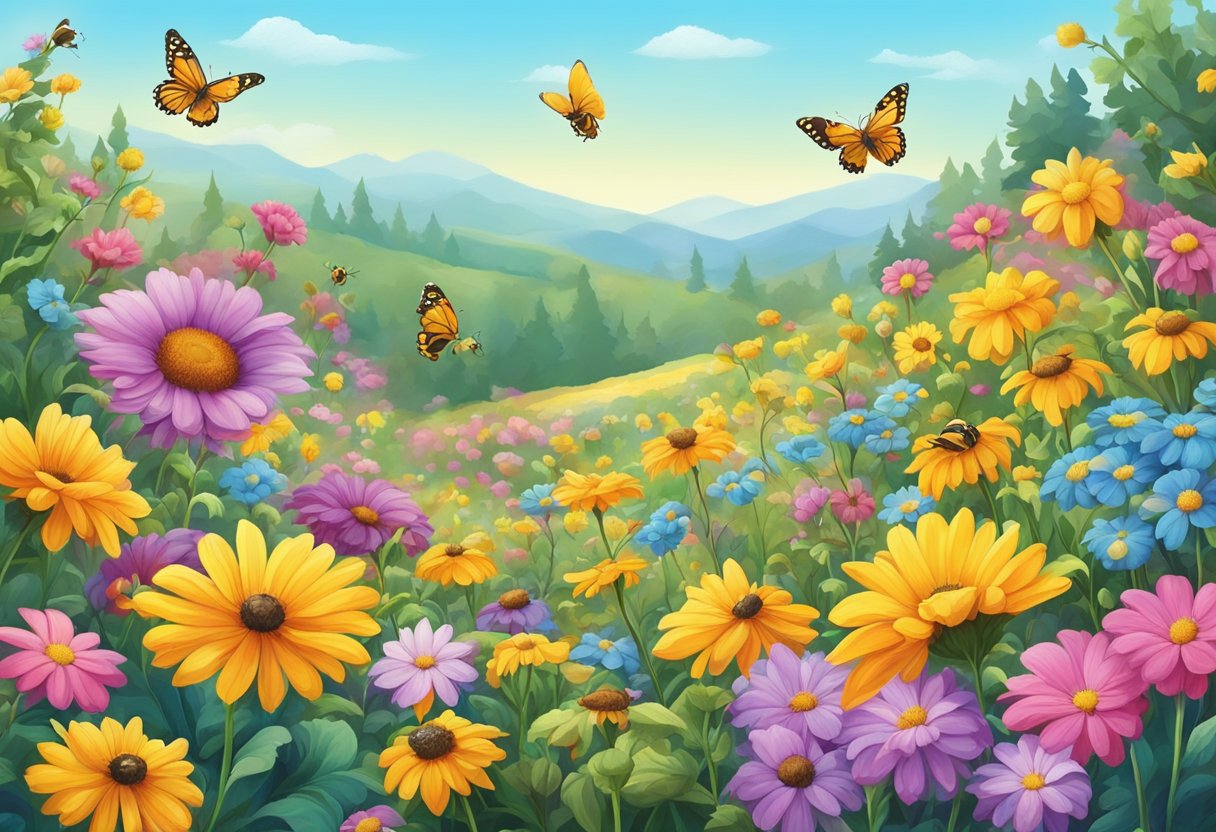
Descriptive writing is a form of writing that aims to create a vivid image of a person, place, thing, or event in the reader’s mind. It is a powerful tool that writers use to engage their readers and make their stories come to life . In this section, we will discuss the role of descriptive writing in storytelling, the elements of descriptive writing, and the importance of sensory details.
The Role of Descriptive Writing in Storytelling
Descriptive writing plays a crucial role in storytelling. It helps to create a detailed and immersive world that readers can visualize and connect with. A well-written description can transport readers to another place and time, allowing them to experience the story in a more meaningful way. It also helps to establish the tone and mood of the story and to build suspense and anticipation.
Elements of Descriptive Writing
Effective descriptive writing requires attention to detail and a careful selection of words. The following elements are essential to creating a vivid and engaging description:
- Word choice: The words chosen should be specific and detailed, helping to create a clear mental image in the reader’s mind.
- Imagery: The use of descriptive language and sensory details helps to create a visual image of the scene.
- Structure: The description should be well-organized and easy to follow, with a logical flow of ideas.
- Action: Descriptions should not be static, but should convey movement and activity.
- Narrative: The description should be integrated into the narrative, rather than feeling like a separate entity.
The Importance of Sensory Details
Sensory details are an essential component of descriptive writing . They help to engage the reader’s senses, making the description more immersive and memorable. By including details about what the scene looks, sounds, feels, and smells like, the writer can create a more complete and vivid picture in the reader’s mind. This helps to draw the reader into the story and create a deeper emotional connection.
In conclusion, descriptive writing is a powerful tool that writers can use to create a vivid and engaging story. By paying attention to word choice, imagery, structure, action, and sensory details, writers can transport their readers to another world and make their stories come to life.
Crafting Vivid Descriptions
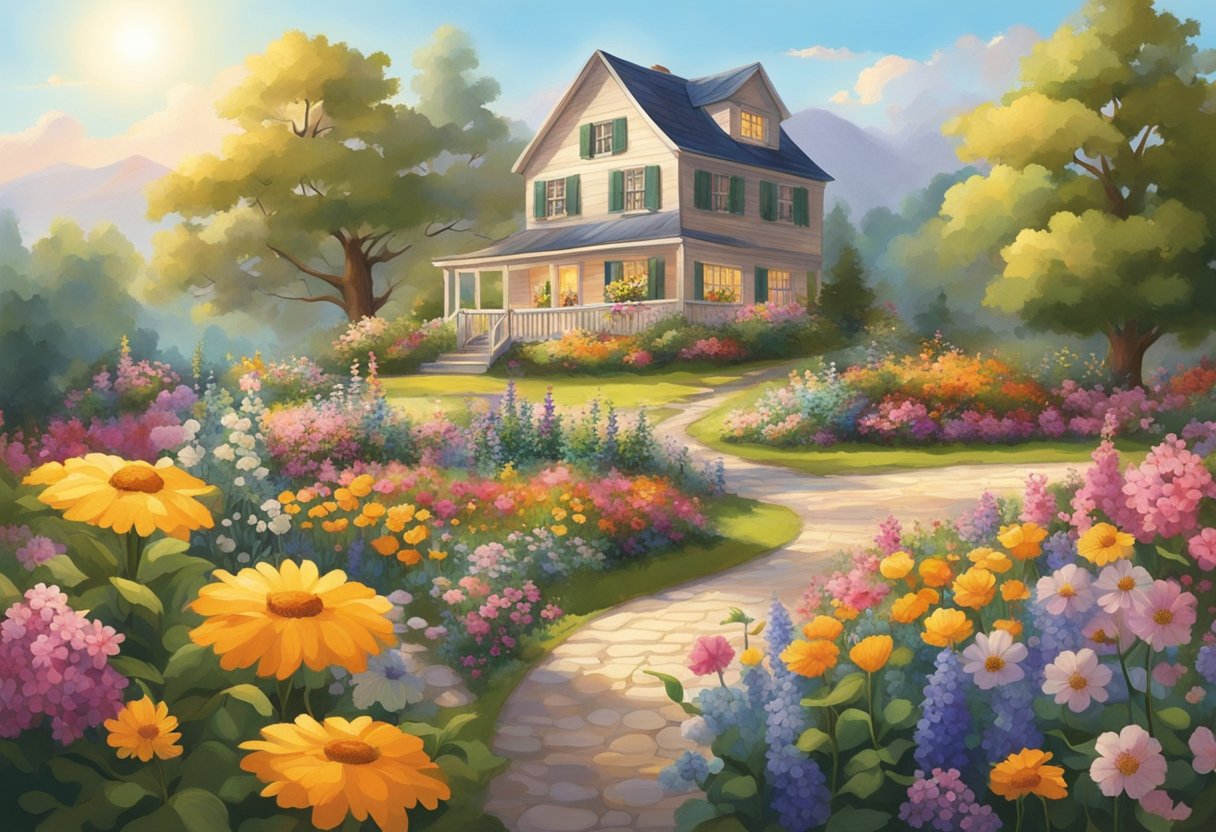
Crafting vivid descriptions of a flower garden requires the use of descriptive language and figurative language to paint a detailed mental picture for the reader. Here are some tips on how to create vivid descriptions:
Utilizing Strong Adjectives and Verbs
One of the keys to crafting vivid descriptions is to utilize strong adjectives and verbs. Using adjectives like “vibrant,” “lush,” “fragrant,” and “colorful” can help create a more vivid picture in the reader’s mind. Verbs like “sway,” “dance,” “bloom,” and “flutter” can also help create a more dynamic and engaging description.
Incorporating Similes and Metaphors
Similes and metaphors are powerful tools in creating vivid descriptions. Comparing the flower garden to something else can help the reader better understand and visualize the scene. For example, “the flowers swayed in the breeze like dancers on a stage” or “the garden was a kaleidoscope of colors, like a painting come to life.”
Building Detailed Mental Pictures
To create a truly vivid description, it is important to build a detailed mental picture for the reader. This can be achieved by describing the garden in a way that engages all the senses. For example, “the scent of the roses wafted through the air, mingling with the sweet fragrance of the lilies” or “the sound of bees buzzing around the blooming flowers filled the garden with life.”
By utilizing strong adjectives and verbs, incorporating similes and metaphors, and building detailed mental pictures, writers can create vivid descriptions of a flower garden that transport the reader to the scene.
Describing a Flower Garden
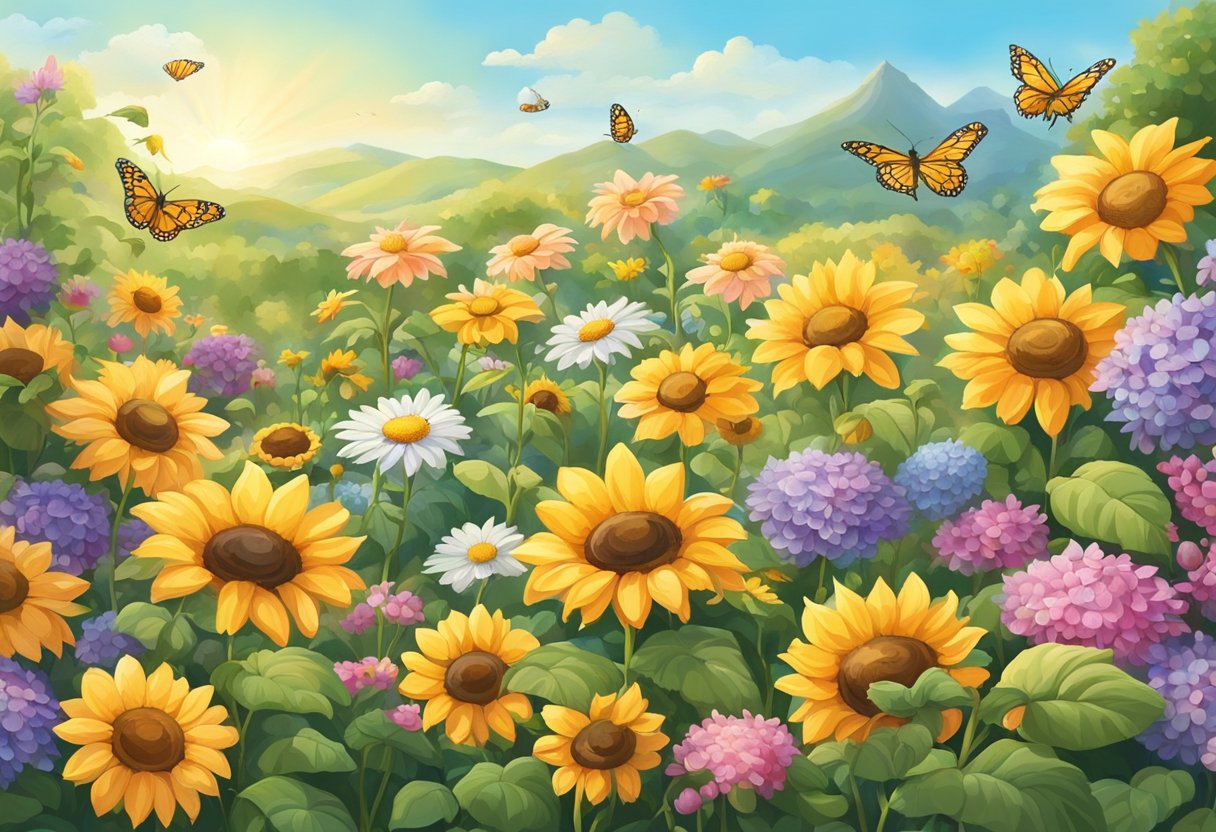
A flower garden is a visual feast for the eyes, a place where nature’s beauty is on full display. To vividly describe a flower garden, one must use specific language and sensory details that bring the garden to life. Here are some tips on how to convey the visual splendor, evoke scents and textures, and capture the essence of a flower garden.
Conveying the Visual Splendor
To convey the visual splendor of a flower garden, one must use descriptive language that captures the colors, shapes, and patterns of the flowers. Words like vibrant, bold, and delicate can be used to describe the different hues of the flowers. One can also use similes and metaphors to compare the flowers to other objects, such as “the tulips were like bright red flames dancing in the wind.”
Evoking Scents and Textures
A flower garden is not just a visual experience, but a sensory one as well. To evoke the scents and textures of a flower garden, one must use sensory language that appeals to the sense of smell and touch. Words like fragrant, sweet, and spicy can be used to describe the different scents of the flowers. One can also use tactile language to describe the textures of the petals, such as “the velvety softness of the rose petals.”
Capturing the Essence of the Garden
Finally, to capture the essence of a flower garden, one must use language that conveys the mood and atmosphere of the garden. Words like peaceful, serene, and joyful can be used to describe the overall feeling of the garden. One can also use descriptive language to bring the garden to life, such as “the gentle swaying of the daisies in the breeze.”
In conclusion, describing a flower garden requires the use of specific language and sensory details that bring the garden to life. By using descriptive language to capture the visual splendor, evoke scents and textures, and capture the essence of the garden, one can create a vivid and engaging description that transports the reader to the heart of the garden.
Enhancing Narrative with Descriptive Techniques
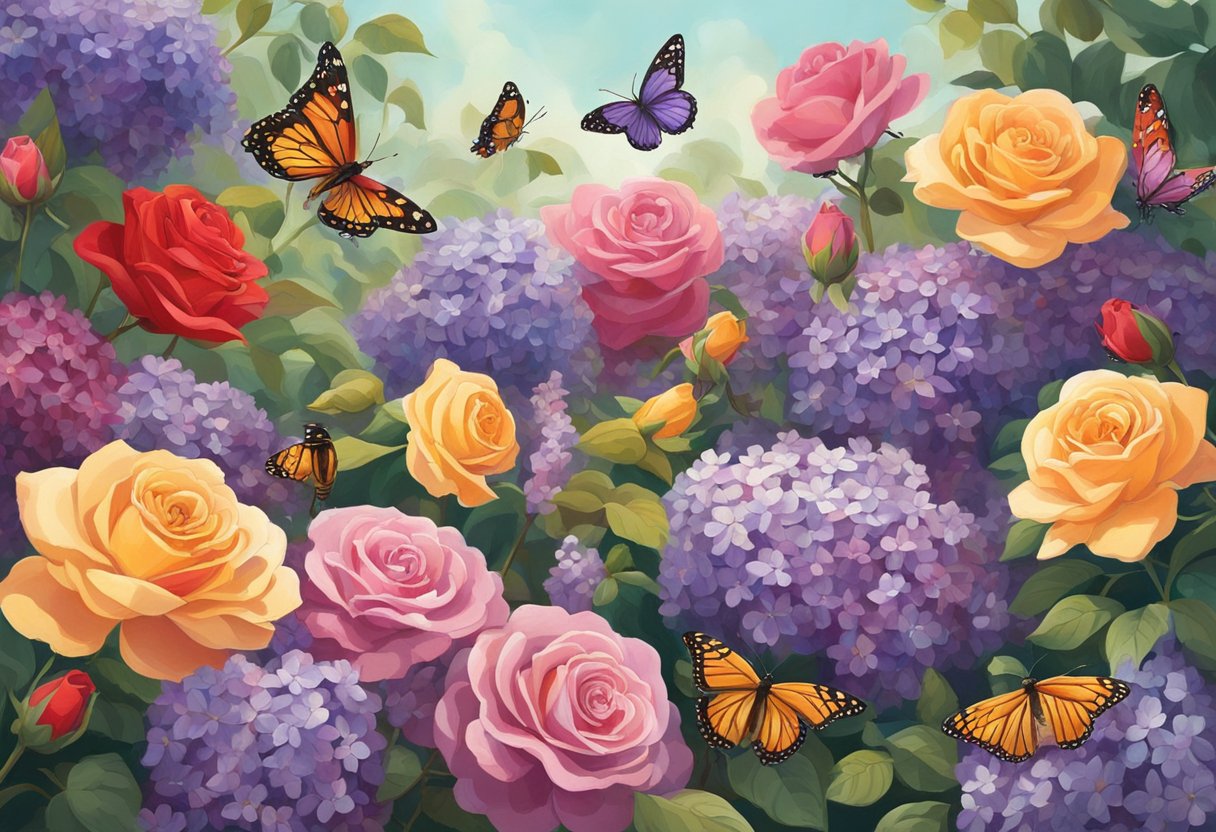
Descriptive writing is a powerful tool for enhancing the narrative of a novel or fictional story. It allows the reader to visualize the characters, settings, and actions in their mind’s eye, creating a more immersive reading experience. In this section, we will explore how to use descriptive techniques to create vivid character and setting descriptions, bring action scenes to life, and integrate descriptive writing into dialogue.
Character and Setting Descriptions
When introducing characters and settings, it’s important to use descriptive language that is both memorable and accurate. By painting a vivid picture of the characters and their surroundings, the reader is more likely to become emotionally invested in the story.
One effective technique is to use sensory details such as sight, sound, touch, taste, and smell. For example, instead of simply stating that a character has blue eyes, the writer could describe them as “piercing blue eyes that sparkle like sapphires in the sunlight.” Similarly, instead of saying a garden is beautiful, the writer could describe “the lush, fragrant garden bursting with colorful blooms and the sweet scent of fresh herbs.”
Using Descriptive Language in Action
Action scenes are a crucial part of any narrative, and descriptive writing can help bring them to life. By using vivid language that conveys the intensity and emotion of the scene, the reader can feel as if they are right there with the characters.
One effective technique is to use short, punchy sentences that convey a sense of urgency and excitement. For example, instead of saying “The hero fought bravely,” the writer could describe “The hero’s heart pounded as he swung his sword, each blow striking with the force of a thunderbolt.”
Integrating Descriptive Writing in Dialogue
Dialogue is an important part of any narrative, and descriptive writing can be used to enhance it as well. By using descriptive language to convey the emotions and body language of the characters, the reader can better understand their motivations and reactions.
One effective technique is to use action tags that describe the character’s movements and expressions. For example, instead of saying “she said angrily,” the writer could describe “she clenched her fists and glared at him, her voice rising with each word.”
In conclusion, descriptive writing is a powerful tool for enhancing the narrative of a novel or fictional story. By using descriptive techniques to create vivid character and setting descriptions, bring action scenes to life, and integrate descriptive writing into dialogue, the writer can create a more immersive and memorable reading experience for the reader.
The Power of Specificity in Writing
When it comes to describing a flower garden, the power of specificity cannot be overstated. By using precise and engaging language, a writer can transport their readers to the garden and make them feel as though they are experiencing it firsthand. The following subsections will explore the significance of nouns and verbs, as well as choosing the right adjectives and adverbs to create a detailed and vivid description.
The Significance of Nouns and Verbs
In writing, nouns and verbs are the backbone of any sentence. They provide the necessary information for readers to understand what is happening and what objects are being referred to. When it comes to describing a flower garden, it’s important to choose nouns and verbs that are as precise as possible. Instead of saying “There are many flowers in the garden,” a writer could say “the garden is overflowing with vibrant tulips, daffodils, and roses.” This not only paints a more detailed picture for the reader but also creates a more engaging and active sentence.
Choosing the Right Adjectives and Adverbs
While nouns and verbs provide the foundation for a sentence, adjectives, and adverbs add color and depth to the description. However, it’s important to choose these words carefully to avoid overusing them or using them incorrectly. For example, instead of saying “The garden is beautiful,” a writer could say “The garden is a stunning display of vibrant colors and delicate fragrances.” This not only provides a more detailed and engaging description but also avoids using a generic and overused adjective.
In conclusion, the power of specificity in writing cannot be understated, especially when it comes to describing a flower garden. By using precise and engaging language, a writer can transport their readers to the garden and make them feel as though they are experiencing it firsthand. By choosing the right nouns, verbs, adjectives, and adverbs, a writer can create a detailed and vivid description that will captivate their readers.
Writing Exercises and Practice
Developing your descriptive writing skills.
One of the best ways to improve your descriptive writing skills is through practice. Writing exercises can help you develop a keen eye for detail and improve your ability to vividly describe a flower garden. Here are a few exercises to get you started:
Observation Exercise: Go to a flower garden and observe the different types of flowers, their colors, shapes, and textures. Take notes on what you see and try to capture the essence of the garden in your writing.
Sensory Exercise: Close your eyes and imagine yourself in a flower garden. Use your senses to describe what you see, hear, smell, taste, and feel. Write down your observations and try to make them as vivid as possible.
Word Choice Exercise: Choose a few flowers from a garden and write a descriptive essay about each one. Focus on using interesting and unique words to describe the flowers, such as “velvety” or “fragrant.”
Masterclass and Workshops
Attending a masterclass or workshop can be a great way to learn new techniques and improve your descriptive writing skills. Here are a few tips to help you choose the right masterclass or workshop:
Research: Do your research and find a masterclass or workshop that is focused on descriptive writing or creative writing in general.
Instructor: Look for an instructor who is experienced and knowledgeable in the field of descriptive writing. Read reviews and ask for recommendations from other writers.
Format: Consider the format of the masterclass or workshop. Some may be online, while others may be in-person. Choose a format that works best for you and your schedule.
By practicing your descriptive writing skills and attending masterclasses or workshops, you can improve your ability to describe a flower garden in a vivid and interesting way.
Applying Descriptive Writing in Various Genres
Descriptive writing is an essential skill for any writer. It helps the reader to visualize and connect with the story, and it is crucial in creating a vivid and immersive experience for the audience. This section explores how descriptive writing can be applied in various genres.
Fiction vs. Nonfiction
Descriptive writing is equally important in both fiction and nonfiction. In fiction, it helps to create a setting and mood, and it can also help to develop characters and their emotions. In nonfiction, descriptive writing can help to explain a concept or idea, and it can also help to create a sense of place.
Short Stories and Novels
In short stories and novels, descriptive writing is crucial in creating a vivid and immersive experience for the reader. It can help to set the scene, establish the mood, and create a sense of place. Descriptive writing can also help to develop characters and their emotions, making them more relatable to the reader.
Journalism and Media Writing
In journalism and media writing, descriptive writing is used to create a sense of place and to help the reader understand the story. It can also be used to create a sense of urgency or to convey a particular emotion. Descriptive writing is particularly important in travel writing, where it helps to create a sense of the destination and its culture.
Overall, descriptive writing is a valuable tool for any writer, regardless of the genre. It helps to create a vivid and immersive experience for the reader, and it can also help to develop characters, explain concepts, and create a sense of place. By mastering descriptive writing, writers can create stories that are engaging, emotional, and memorable.
Recap of Descriptive Writing Techniques
In this guide, the writer has covered over 400 words to vividly describe a flower garden. Descriptive writing is an essential aspect of storytelling and essay writing. It helps the reader to visualize the scene and connect with the story emotionally. Some of the techniques covered in this guide include the use of sensory details, figurative language, and vivid verbs.
By using sensory details, the writer can appeal to the reader’s senses, making the scene more realistic. Figurative language, on the other hand, helps to create a vivid image in the reader’s mind. Vivid verbs, in combination with sensory details and figurative language, help to bring the scene to life.
Encouragement to Continue Practicing
Writing is a skill that requires practice to perfect. The more a writer practices, the better they become. The techniques covered in this guide are just a starting point. The writer should continue to experiment with different words and phrases to create unique and vivid descriptions.
It is also essential to keep the reader in mind when writing. The reader should be able to connect with the story emotionally and visualize the scene. To achieve this, the writer should use descriptive writing techniques to create a vivid image in the reader’s mind.
In conclusion, descriptive writing is an essential aspect of storytelling and essay writing. By using sensory details, figurative language, and vivid verbs, the writer can create a vivid image in the reader’s mind. With practice, the writer can perfect their skills and create unique and captivating descriptions that will engage readers.
Latest posts

Achieving Your Word Count Goals with Daily Sprints: A Guide
Many writers struggle with meeting their word count goals, whether it’s for a school assignment, a blog post, or a novel. It can be frustrating to stare at a blank page or screen and feel like you’re not making progress. However, there is a technique that can help you achieve your word count goals and…

Beat Burnout: Setting Reasonable Writing Expectations
Writing can be a fulfilling and rewarding experience, but it can also be exhausting and draining. Writing burnout is a real phenomenon that can affect anyone, from professional writers to students. When writers push themselves too hard, they can experience stress, lack of motivation, and even physical symptoms like headaches and fatigue. To avoid burnout,…

Dealing with Criticism and Rejection as an Author: Tips and Strategies
As an author, receiving criticism and rejection is an inevitable part of the writing process. It can be difficult to navigate the emotions that come with having your work scrutinized, but it’s important to remember that criticism and rejection are not personal attacks. Instead, they are opportunities for growth and improvement. One way to deal…

Describing a Garden: Tips and Tricks for Creating a Vivid Picture
Learn how to effectively describe a garden by paying attention to its size, types of plants present, layout, and overall aesthetic appeal. Discover tips and tricks for incorporating your observations into a vivid and engaging description.
Posted: 2022-07-10
Content Outline
- A. Definition of a Garden
- B. Importance of Describing a Garden
- A. Taking Note of the Landscape
- B. Identifying the Flora and Fauna
- C. Noting the Colors and Textures
- A. Using Sight to Describe a Garden
- B. Using Sound to Describe a Garden
- C. Using Smell to Describe a Garden
- D. Using Touch to Describe a Garden
- E. Using Taste to Describe a Garden
- A. Adjectives to Use
- B. Metaphors and Similes to Use
- C. Using Personification
Introduction
A garden is a beautiful and serene place that can be enjoyed by anyone. Whether you are a nature lover or just looking for a peaceful retreat, a garden can provide you with the perfect escape. In this post, we will explore the art of describing a garden and provide you with some tips and tricks to help you do it effectively.
When it comes to describing a garden, there are a few key factors to keep in mind. These include the size of the garden, the types of plants that are present, the layout of the garden, and the overall aesthetic appeal. By paying attention to these factors and incorporating them into your description, you can create a vivid and engaging picture of the garden in question.
Firstly, it is important to note that the size of the garden can greatly impact how it is described. A small garden may be described as cozy and intimate, while a larger garden may be described as sprawling and expansive. Additionally, the types of plants that are present can also influence the description. For example, a garden filled with colorful flowers may be described as vibrant and lively, while a garden filled with lush greenery may be described as peaceful and tranquil.
The layout of the garden is also an important factor to consider. A well-organized garden with clearly defined paths and sections may be described as structured and orderly, while a more freeform garden may be described as natural and organic.
Finally, the overall aesthetic appeal of the garden is crucial in any description. When describing a garden, it is important to mention the colors, textures, and scents that are present. This can help to create a sensory experience for the reader and make the description more engaging.
Overall, when describing a garden, it is important to pay attention to the size, types of plants, layout, and aesthetic appeal. By incorporating these factors into your description and using descriptive language, you can create a vivid and engaging picture of the garden for your readers. For more information on how to describe a garden, check out this source .
Introduction - A. Definition of a Garden
A garden is a piece of land that is cultivated and maintained for the purpose of growing plants, flowers, or vegetables. It can be a small plot in your backyard or a large area in a public park. Gardens can serve many purposes, from providing a source of fresh produce to creating a peaceful retreat.
When describing a garden, it's important to consider its size, location, and layout. Different types of gardens include vegetable gardens, flower gardens, and container gardens. Each type of garden requires different levels of maintenance and care.
Defining a Garden
The Oxford Dictionary defines a garden as "a piece of ground, often near a house, used for growing flowers, fruit, or vegetables." However, the definition of a garden can vary depending on who you ask. Some people may consider a collection of potted plants on a balcony to be a garden, while others may only consider a large, landscaped area to be a true garden.
Regardless of how you define a garden, it's important to understand the benefits that come with cultivating plants. Gardens can improve air quality, promote relaxation, and provide a source of fresh produce. In fact, according to a study by the National Gardening Association, homegrown vegetables can save a family of four up to $600 per year on grocery bills.
In conclusion, a garden is a cultivated piece of land that can serve many purposes. Whether you're growing vegetables, flowers, or simply enjoying the beauty of nature, gardens offer a wide range of benefits. Understanding the different types of gardens and their unique characteristics is key to describing and appreciating these wonderful spaces. So get out there and start gardening!
Source: Oxford Dictionary
Source: National Gardening Association
🧑🌾 Save time, money, and grow a thriving garden effortlessly.
Introduction - b. importance of describing a garden.
A garden can be a source of relaxation, inspiration, and joy. However, describing a garden can be a challenging task for many people. In this post, we will discuss the importance of describing a garden and provide tips on how to do it effectively.
Why is it important to describe a garden?
- Helps others envision the garden: Describing a garden can help others who have not seen the garden to visualize it in their minds. This can be particularly useful for those who are looking to buy a property with a garden or for those who are planning to redesign their own garden.
- Encourages appreciation of nature: Describing a garden can help people appreciate the beauty of nature. It can also encourage people to spend more time outdoors and connect with nature.
- Preserves memories: Describing a garden can help preserve memories of the garden. Whether it's a personal garden or a public one, describing it can help keep its history alive.
How to describe a garden effectively
- Use sensory language: Use descriptive words that appeal to the senses, such as colors, textures, and scents. For example, "The garden is filled with vibrant red and yellow flowers, and the scent of lavender fills the air."
- Focus on key features: Identify the key features of the garden, such as the layout, plants, and decorations. Describe each feature in detail and explain why it is important.
- Use comparisons: Comparing the garden to other things can help readers better understand its beauty and uniqueness. For example, "The garden's winding pathways are like a maze, leading you on a journey through a sea of colors."
By describing a garden effectively, you can help others appreciate its beauty and connect with nature. Remember, the key to describing a garden is to use descriptive language, focus on key features, and use comparisons where appropriate. Hopefully, these tips will help you in your quest to learn how to describe a garden.
The Importance of Observation
Observation is a crucial skill for anyone who wants to describe a garden accurately. By taking the time to observe carefully, you can notice details that might otherwise be overlooked. Here are some key reasons why observation is so important:
- It helps you to notice details: When you observe a garden carefully, you can see things that you might not have noticed otherwise. For example, you might notice the way the light falls on a particular flower, or the way that the leaves of a certain plant move in the breeze.
- It helps you to understand the garden better: By observing a garden, you can get a sense of how different elements of the garden interact with each other. For example, you might notice how the placement of a certain plant affects the way that the rest of the garden looks.
- It helps you to describe the garden more accurately: When you've observed a garden carefully, you can describe it in more detail. This can be especially helpful if you're trying to write a description of the garden for someone who hasn't seen it. By describing the garden in detail, you can help the reader to visualize it more clearly.
Overall, observation is a key skill for anyone who wants to describe a garden accurately. By taking the time to observe carefully, you can notice details that might otherwise be overlooked, understand the garden better, and describe it more accurately.
If you're interested in learning more about how to describe a garden, be sure to check out this article from HGTV, which offers some great tips and advice.
The Importance of Observation - A. Taking Note of the Landscape
Observation is a crucial skill when it comes to describing a garden. In order to accurately depict the characteristics of a garden, it is important to take note of the landscape. By observing the garden, you can identify the key features that make it unique and interesting.
- Start by looking at the overall layout of the garden. Note any unique shapes or patterns that catch your eye.
- Pay attention to the colors of the plants and flowers. Are they bright and bold, or soft and muted?
- Take note of the textures in the garden. Are there smooth surfaces, rough edges, or prickly leaves?
- Observe the way the light falls on the garden. Are there areas of shade and sun? Does the light highlight certain features?
By taking note of these landscape features, you can create a vivid description of the garden that captures its essence. Additionally, observing the garden can also provide valuable insight into the care and upkeep of the space. For example, if you notice that certain plants are thriving in specific areas, you can infer that those plants are well-suited for those conditions.
According to a study by the University of Illinois, observation can also have mental health benefits. The study found that spending time in nature and observing the natural environment can reduce stress and improve overall well-being.
Therefore, taking the time to observe and appreciate the landscape of a garden not only enhances your ability to describe it, but also has positive effects on your mental health. So, the next time you find yourself in a garden, take a moment to observe and appreciate the beauty around you.
- University of Illinois Study on Nature and Stress Reduction
The Importance of Observation - B. Identifying the Flora and Fauna
Observation is a crucial part of accurately describing a garden. Identifying the flora and fauna that inhabit a garden can provide insight into the overall health and biodiversity of the ecosystem. By identifying different species, you can also gain a deeper understanding of the relationships between different elements of the garden.
Identifying Flora
- Start by observing the overall form and structure of different plants. Take note of the size, shape, and color of leaves, flowers, and fruit.
- Use a field guide or online resource to help identify different species. The Gardenia website is a great resource for identifying different types of plants.
- Pay attention to the location and growing conditions of different plants. Some species may only thrive in certain environments, while others can tolerate a wide range of conditions.
Identifying Fauna
- Look for signs of animal activity, such as tracks, droppings, and webs.
- Observe the behavior and movement patterns of different animals. This can help you identify different species and understand their roles within the ecosystem.
- Use a field guide or online resource to help identify different species. The All About Birds website is a great resource for identifying different types of birds.
Overall, identifying the flora and fauna within a garden is a critical step in accurately describing the space. By understanding the different species that inhabit the space, you can gain insight into the overall health and diversity of the ecosystem. Additionally, understanding the relationships between different elements can help you make informed decisions regarding garden management and maintenance.
The Importance of Observation - C. Noting the Colors and Textures
When describing a garden, it is important to pay attention to the colors and textures present. Noting these details can help bring your description to life and make it more engaging for the reader.
According to a study conducted by the University of Minnesota, colors can have a significant impact on our emotions and can even affect our physical state. For example, warm colors like red and yellow can increase energy levels and stimulate the senses, while cool colors like blue and green can have a calming effect and promote relaxation.
When describing a garden, using sensory words to describe the colors can help the reader visualize the scene. For example, instead of simply saying "the flowers were red," try using words like "vibrant," "bold," or "fiery."
Textures are also an important element to note when describing a garden. The different textures can add depth and dimension to the scene. For instance, the rough bark of a tree can contrast with the smooth petals of a flower, creating an interesting visual and tactile experience.
When describing textures, it is important to use descriptive words that convey the feel of the object. For example, instead of saying "the leaves were bumpy," try using words like "wrinkled," "ridged," or "crinkled."
Overall, taking note of the colors and textures in a garden is essential when describing it. It can help create a vivid picture in the reader's mind and make the description more engaging. So, the next time you visit a garden, be sure to take note of the colors and textures and incorporate them into your description.
Source: University of Minnesota
The Role of the Senses in Describing a Garden
When it comes to describing a garden, the senses play an important role in bringing its beauty and essence to life. Each sense offers a unique perspective that collectively contributes to a complete and accurate portrayal of the garden. Here are some ways in which each sense can be used to describe a garden:
- Sight: The colors, textures, and shapes of plants, flowers, and other garden elements are key visual components to describe a garden. The way the sun shines on the garden, casting shadows and creating highlights, can also be noteworthy. According to a survey, 83% of people believe that visual appearance is the most important aspect of a garden. [source]
- Hearing: The sounds of nature, such as birds chirping and water flowing, can add to the ambiance of a garden. In fact, studies have shown that the sound of water has a calming effect on people and can reduce stress levels. [source]
- Smell: The fragrances of flowers, herbs, and other plants can be an essential part of describing a garden. The sense of smell can evoke memories and emotions, making it a powerful tool in creating a sensory experience. It is estimated that over 75% of emotions are triggered by smell. [source]
- Taste: In a garden full of edible plants, taste can be an important sense to consider. Describing the flavors of herbs, fruits, and vegetables can add an extra dimension to the garden's description. It's worth noting that gardening and growing your own produce has become increasingly popular, with 35% of households in the US growing their own food. [source]
- Touch: The feel of soil, petals, leaves, and other garden elements can be a tactile way to describe a garden. The texture and density of plants can also be important to note. Additionally, studies suggest that gardening can have therapeutic benefits and improve mental health. [source]
By using all five senses, a fuller and more accurate description of a garden can be achieved, providing a complete sensory experience for the reader. Ultimately, the goal is to capture the essence of the garden and inspire readers to explore their own senses when describing their own garden.
For more tips on how to describe a garden, check out our comprehensive guide on how to describe a garden.
The Role of the Senses in Describing a Garden - A. Using Sight to Describe a Garden
When it comes to describing a garden, the sense of sight is perhaps the most important. The visual appeal of a garden is what draws people in and creates a lasting impression. Utilizing descriptive language to convey the beauty of a garden can help to create a vivid image in the reader's mind. Here are some tips on how to use sight to describe a garden:
- Begin by identifying the colors present in the garden. For example, you might describe a garden as being a riot of colors, with bright reds, pinks, and oranges intermingled with soft pastels.
- Take note of the different textures within the garden. This might include the rough bark of a tree, the soft petals of a flower, or the smooth surface of a pond.
- Consider the shapes present in the garden. Are there any geometric shapes, such as squares or circles, or more organic shapes, such as the curves of a winding path?
- Pay attention to the use of space within the garden. Is it densely packed with plants, or are there open areas that allow for movement and exploration?
Using descriptive language to convey these visual elements can help to create a vivid and engaging picture of the garden in the reader's mind. For example, you might describe a garden as:
"A vibrant tapestry of colors, with jewel-toned flowers nestled among verdant green foliage. The textures within the garden are equally varied, from the rough bark of the towering oak tree to the soft, velvety petals of the roses. The garden's winding path leads the eye on a journey of discovery, revealing new delights around every corner."
By incorporating these elements into your description, you can help the reader to visualize the garden in a way that is both engaging and informative.
According to a study, about 85% of the people in the US have a garden, and gardening is becoming increasingly popular in urban areas as well. Therefore, it is important to learn how to describe a garden effectively, especially if you are planning to share your love of gardening with others.
The Role of the Senses in Describing a Garden - B. Using Sound to Describe a Garden
When it comes to describing a garden, most people tend to focus on the visual aspects such as the colors of the flowers, the texture of the foliage, and the overall layout. However, the role of sound in describing a garden is often overlooked. In this section, we will explore how sound can be used to enhance the description of a garden.
1. The Sounds of Nature
The first thing that comes to mind when we think of the sounds of a garden is the chirping of birds, buzzing of bees, and rustling of leaves in the wind. Incorporating these sounds into your description can help transport the reader to the garden and give them a sense of the atmosphere. According to a study by the University of Surrey, the sound of birds singing can have a positive effect on our mood and mental wellbeing.
2. Water Features
Another way to describe the sound of a garden is by focusing on any water features such as a fountain or a stream. The sound of trickling water can be calming and peaceful, and can add a new dimension to the garden experience. In fact, a study by the University of Exeter found that the sound of water can help to reduce stress and improve cognitive performance.
3. Human Sounds
Finally, it's important to consider the human sounds that may be present in a garden. This could include the sound of children playing, the hum of conversation, or even the sound of a lawnmower. These sounds can help to create a sense of activity and liveliness in the garden.
In conclusion, sound plays an important role in describing a garden and should not be overlooked. By incorporating the sounds of nature, water features, and human activity, you can create a more vivid and engaging description of the garden. So, the next time you're trying to describe a garden, don't forget to use sound to your advantage!
For more information on how to describe a garden, check out this article from Better Homes & Gardens.
The Role of the Senses in Describing a Garden - C. Using Smell to Describe a Garden
When it comes to describing a garden, one of the most important senses to tap into is smell. The scent of a garden can evoke strong emotions and memories, making it a powerful tool for creating a vivid and memorable description.
- Identify the dominant scents: Take a moment to focus on the smells around you and identify the dominant scents in the garden. Is it the sweet fragrance of flowers, the earthy scent of soil, or the fresh scent of herbs? By identifying the dominant scents, you can create a more accurate and detailed description of the garden.
- Describe the intensity of the smells: Not all scents are created equal. Some may be subtle and delicate, while others are strong and overpowering. Use words like "subtle," "mild," "strong," and "intense" to describe the intensity of the smells in the garden.
- Use descriptive language: When describing the smells of a garden, use descriptive language that evokes the senses. For example, instead of saying "the garden smells nice," describe the scent as "the sweet fragrance of roses and lavender." This type of description creates a more vivid and memorable image for the reader.
By using smell to describe a garden, you can create a more engaging and memorable description that truly captures the essence of the space. So next time you're describing a garden, be sure to tap into the power of scent.
For more tips on how to describe a garden, check out this article from Better Homes & Gardens.
The Role of the Senses in Describing a Garden - D. Using Touch to Describe a Garden
When it comes to describing a garden, touch can be a powerful sense to utilize to convey the experience. By using descriptive language that evokes tactile sensations, readers can better understand the textures and physical qualities of a garden. Here are some tips on using touch to describe a garden:
- Begin with the ground: Start by describing the texture and feel of the ground beneath your feet. Is it soft and spongy or hard and rocky? Are there any uneven areas or debris?
- Describe the foliage: Use words that convey the texture of the plants, such as velvety, prickly, or smooth. Mention the size and shape of the leaves, and any other unique characteristics that can be felt upon touch.
- Include the flowers: Flowers are often the main attraction in a garden, and their texture can vary widely. Use words like silky, waxy, or bumpy to describe their surfaces. Mention any fragrances that can be detected through touch, such as the soft fuzziness of a rose petal or the sticky residue left by a blooming lily.
- Highlight the structures: Gardens may contain structures such as benches, fountains, or statues. Describe their surfaces and materials. Is the bench smooth or rough? Is the fountain made of cool stone or warm metal?
By incorporating touch into your garden descriptions, you can create a more vivid and engaging experience for your audience. For more tips on how to describe a garden, check out this article on Garden Design.
The Role of the Senses in Describing a Garden - E. Using Taste to Describe a Garden
Describing a garden using taste can be a unique and interesting way to engage with your audience. Gardens are not just a visual delight, they can also stimulate one's sense of taste. Here are some ways to use taste to describe a garden:
- Herbs: Herbs are a great way to describe the taste of a garden. Mint, for instance, can give a garden a cool and refreshing taste. Basil, on the other hand, can add a sweet and spicy flavor. Using herbs can also highlight the different scents in a garden, which adds to the overall sensory experience.
- Fruits and Vegetables: Fruits and vegetables are an obvious choice when it comes to describing the taste of a garden. These can range from tart berries to sweet melons, and from bitter greens to savory root vegetables. Not only do they add to the taste experience, but they can also showcase the variety and health benefits of a garden.
- Edible Flowers: Edible flowers are a unique way to describe the taste of a garden. Flowers like pansies, roses, and violets can add a floral and sweet taste to a garden. Other flowers like nasturtiums can add a peppery and spicy flavor to a garden. Edible flowers can also add a pop of color to a garden, which adds to the visual experience.
Using taste to describe a garden can be a great way to engage with your audience and make your garden stand out. According to a study by the National Gardening Association, 35% of households in the US grow food either at home or in a community garden, which shows the growing interest in gardening. So, whether you are a seasoned gardener or just starting out, using taste to describe your garden can be a creative and effective way to showcase your hard work and love for gardening.
Descriptive Language to Use When Describing a Garden
If you're wondering how to describe a garden, there are a few key strategies you can use to paint a vivid picture for your readers or listeners.
- Use sensory language: To make your description come alive, engage all of the senses. Describe the scent of blooming flowers, the feel of soft grass underfoot, and the sound of leaves rustling in the breeze.
- Choose vivid adjectives: Don't settle for basic descriptions like "pretty" or "nice." Instead, opt for more descriptive words like "lush," "vibrant," "bustling," or "serene."
- Highlight specific features: Whether you're describing a public park or a private backyard, hone in on specific features that make the garden unique. This could be a striking sculpture, a babbling brook, or a riot of colorful wildflowers.
- Emphasize the natural beauty: Gardens are a celebration of nature, so make sure your description reflects this. Talk about the way the sunlight filters through the leaves, or the way the bees buzz from flower to flower.
Remember, the goal of describing a garden is to transport your audience to that space and help them experience it for themselves. By using descriptive language and highlighting the unique features that make the garden special, you can create a vivid and engaging description that will bring your readers or listeners along for the ride. For more tips on how to describe a garden, check out Better Homes and Gardens.
Descriptive Language to Use When Describing a Garden - A. Adjectives to Use
When it comes to describing a garden, using the right adjectives can make all the difference in creating a vivid and engaging picture for your reader. Here are some adjectives to consider when describing a garden:
- Lush: Use this to describe a garden that is full of healthy, green plants and foliage.
- Vibrant: Use this to describe a garden that is full of bright, bold colors.
- Fragrant: Use this to describe a garden that has a pleasant, sweet smell.
- Tranquil: Use this to describe a garden that is peaceful and calming.
- Enchanting: Use this to describe a garden that is magical or captivating in some way.
- Wild: Use this to describe a garden that has a more natural, unkempt look.
- Tidy: Use this to describe a garden that is well-organized and neatly maintained.
Of course, these adjectives are just a starting point. The key is to choose words that accurately convey the feeling and atmosphere of the garden you are describing. Remember to also use sensory language to engage your reader's sense of sight, smell, touch, and sound.
If you're interested in learning more about how to describe a garden, check out this article from Better Homes & Gardens. And if you're looking for some inspiration, take a look at the beautiful gardens featured on Country Living.
Overall, using descriptive language to paint a vivid picture of a garden can be a powerful way to engage your reader and help them to better appreciate the beauty of the natural world. So don't be afraid to get creative!
Descriptive Language to Use When Describing a Garden - B. Metaphors and Similes to Use
When it comes to describing a garden, using descriptive language can help paint a vivid picture in the reader's mind. One technique to achieve this is through the use of metaphors and similes.
- A garden is a canvas in which nature paints its own picture.
- A garden is a symphony of colors and scents.
- A garden is a sanctuary for the soul.
- A garden is a tapestry woven by the hands of nature.
By using metaphors such as these, the reader can envision the garden as something more than just a collection of plants and flowers. Instead, it becomes a work of art, a sensory experience, or a place of refuge.
- The flowers in the garden are like a rainbow after a storm.
- The leaves rustle like a symphony played by the wind.
- The sunlight filters through the trees like a golden veil.
- The garden is as fragrant as a bouquet of flowers.
Similes can also add depth and texture to a garden's description. By comparing the garden to other familiar objects or experiences, the reader can better understand the garden's unique qualities.
Overall, using metaphors and similes can help create a more engaging and descriptive portrayal of a garden. By incorporating these techniques into your writing, you can transport your reader into the garden's world and make them feel as though they are experiencing it for themselves. So, the next time you're wondering how to describe a garden, consider using metaphors and similes to bring the garden to life.
For more tips on how to describe a garden, check out this Better Homes & Gardens article.
Descriptive Language to Use When Describing a Garden - C. Using Personification
When it comes to describing a garden, using personification can add a whole new level of depth and emotion to your writing. Personification is a literary device where non-human objects are given human-like qualities, such as emotions or actions.
For example, instead of saying "the flowers were swaying in the wind," you could say "the flowers danced gracefully in the breeze."
Personification can also be used to describe the garden as a whole. Instead of saying "the garden was beautiful," you could say "the garden came alive with vibrant colors and playful aromas."
Using personification allows you to paint a vivid picture for your readers, helping them to better visualize and connect with your description of the garden.
When using personification to describe a garden, it's important to choose words and phrases that are appropriate and accurate. Avoid over-exaggeration or using unrealistic descriptions that could confuse or mislead your audience.
Overall, using personification is just one of the many techniques you can use when describing a garden. When combined with other descriptive language techniques, such as sensory language and figurative language, you can create a truly immersive and engaging description of a beautiful garden.
For more tips on how to describe a garden, check out this Better Homes & Gardens article on how to describe a garden using all five senses.
In conclusion, describing a garden can be a challenging task, but with the right approach, it can be a rewarding experience. By using sensory language and descriptive adjectives, you can paint a vivid picture of the garden and transport your readers to a serene and beautiful environment. It is important to note that the key to describing a garden is to be specific and detailed, while also using figurative language to enhance the overall experience.
Furthermore, it is important to remember that gardens can have different meanings and purposes, depending on the context. For example, a community garden might represent a place of social interaction and sustainability, while a botanical garden might represent a place of scientific research and education. Therefore, when describing a garden, it is important to consider its purpose and meaning.
It is also worth noting that gardens can have a significant impact on our health and well-being. Research has shown that exposure to green spaces can reduce stress levels, improve mood, and enhance cognitive function. Therefore, describing a garden can also be a way to promote its benefits and encourage people to spend more time in nature.
Overall, the process of describing a garden can be a creative and fulfilling experience. By using the right techniques and considering the context and purpose of the garden, you can capture its essence and convey its beauty to your readers. So why not give it a try and see where your words can take you?
For more information on the benefits of gardens and green spaces, check out this study by the National Academy of Sciences.
Unlock your garden's potential with AIGardenPlanner ! Get personalized, data-driven planting recommendations tailored to your location and preferences. Save time, money, and grow a thriving garden effortlessly. Try create a garden plan now!
- Gardening Tips
- Home & Garden
- Home and Garden
- Home Improvement
- Entertainment Venues
- Health and Wellness
- Entertainment
- Pets & Animals
- Gardening Technology
- Sports & Entertainment
- Music History
- Religious Studies
- Technology & Innovation
- Entertainment & Events
- February 2023
- January 2023
- December 2022
- November 2022
- October 2022
- September 2022
- August 2022
- February 2022
- January 2022
- December 2021
- November 2021
- October 2021
- September 2021
- August 2021

Describing The Garden
Sharing is caring!
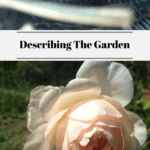
Although I truly love sharing with you what my senses perceive when I am in the garden, describing the garden is not easy because descriptive writing is not my forte.
Bringing the smells, the sights and the sounds alive on paper is – in fact – very difficult.
How do you accurately describe the wonderful, translucent way a rose looks and the changes in color that take effect when the sun is shining through the petals in a way that makes them glow?
In this article, I hope to share with you how to describe a garden using a combination of senses such as sight, sound and smell as well as words often used to accurately describe a garden.

Table of Contents
How To Describe A Garden
The best way to learn how to describe a garden is to think about what your words convey to the person reading them.
A good description needs to convey what something looks like, what sounds you hear, smells you notice, things you taste if applicable, as well as what things you touch actually feel like.
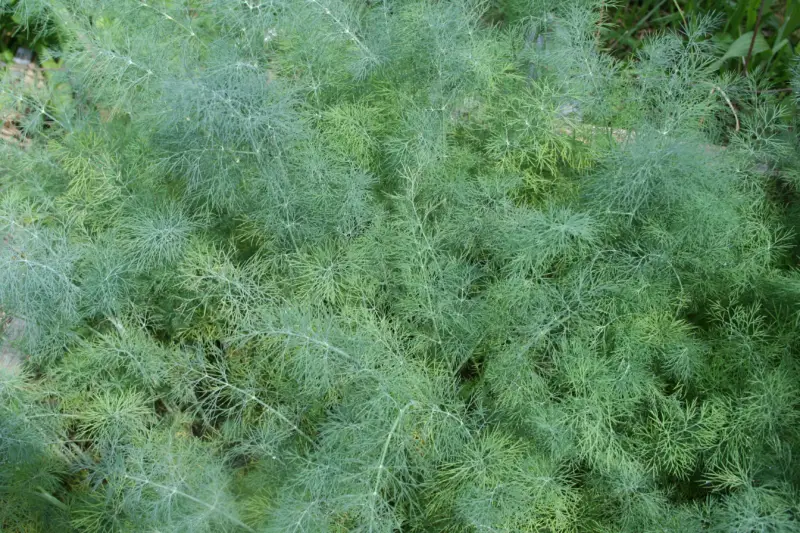
When it comes to describing a garden, it is possible to describe the taste of certain plants or even what they feel like.
For example, the photo above is dill weed.
Dill weed has a slightly tangy taste often associated with pickles and the plant itself is very soft to the touch sort of like a feather, but you will notice the hardness of the stem running through the center of the plant.
The more common descriptions however are going to be how the garden looks, what sounds you hear while you are in the garden as well as any scents you notice.
The key is to show your reader through the details of sight, smell, taste, texture and sound exactly what you are experiencing, instead of simply telling them about your experience.

Ways To Describe A Garden
There are many ways to describe a garden using a combination of vivid adjectives, metaphors and similes.
Describing a garden requires more of the writer than just these things though.
Sharing your thoughts and emotions help give the reader a real sense of what the garden is actually like and this is not necessarily easy.
Often we are taught to stick to the facts, be concise and objective, however when it comes to descriptive writing, these rules must be bent.
While it is important to be observe and report the details in a concise manner, adding in vivid adjectives, metaphors and similes are an important part of descriptive writing.
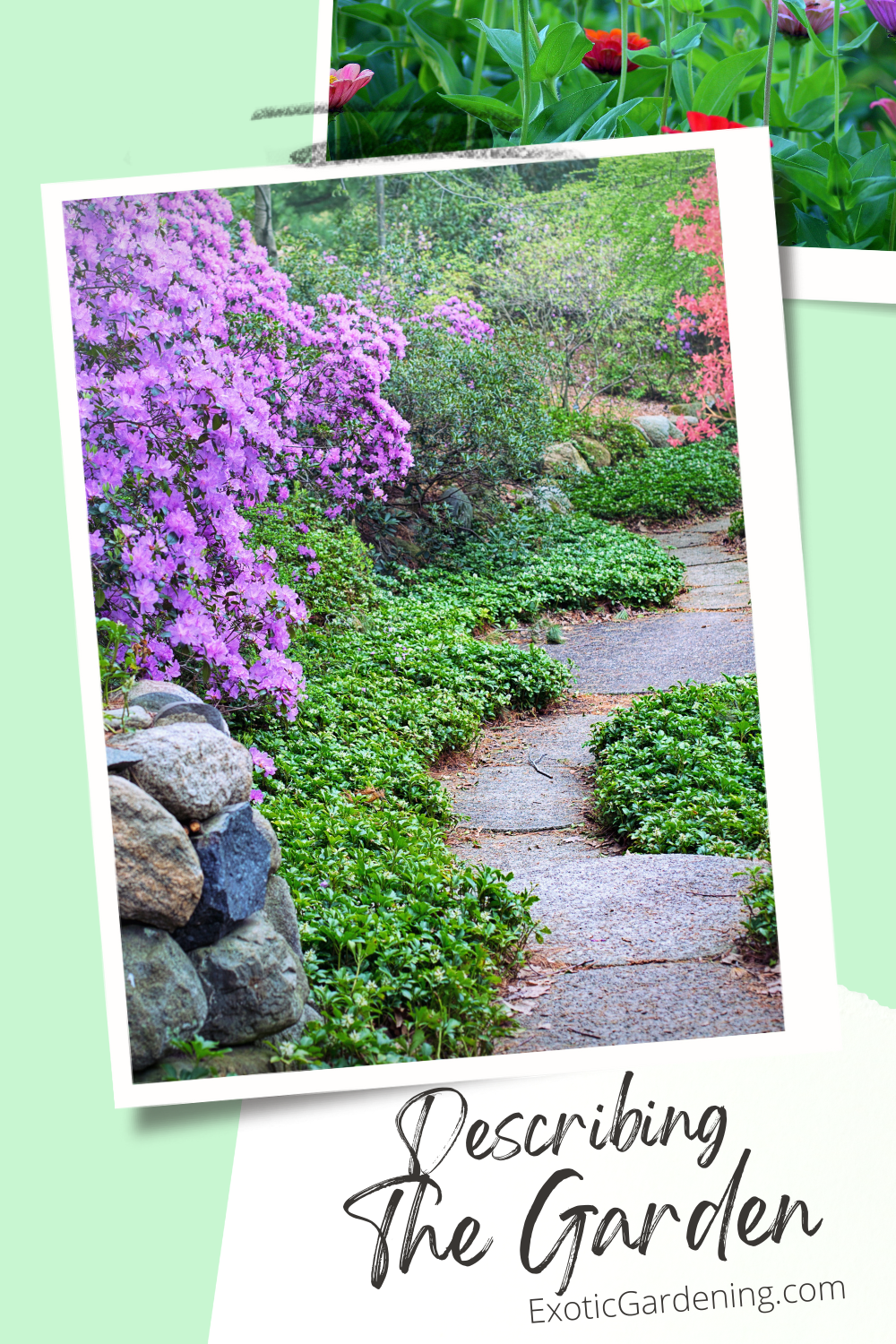
Words To Describe A Garden
There are so many words to describe a garden that honestly that could be a post all of its own.
However, here is a short list of some popular words to describe a garden.
- magnificent
Descriptive Writing On A Garden
Sensory details are essential to descriptive writing on a garden.
The reader must get a vivd sense of what you are describing.
Ideally the words you use should paint a picture in their mind of what you see and possibly even invoke feelings of what it is like to be in the garden, as if they were standing right beside you.
This is why it is important to select the right details to share.
You want your reader to see what you see, feel what you feel and experience exactly what you are experiencing as you walk through the garden.
Using precise language is important because if the words you choose are too vague the description of the garden will not be clear enough to the reader and that will impact their ability to fully immerse themselves in the article or essay.

Description Of A Garden
Below is my attempt at describing my garden.
I can see it with my eyes when I am gardening or even walking through the garden, but I can’t quite capture the effect with a photo – then again, I am not a photographer.
These days, even though I have a Canon EOS Rebel T3i digital camera, it is my iPhone that I take most pictures with, after all, it is always with me and you can’t get more convienent than that.
Add in the delightful smells that waft through the summer air , the sound of birds and the tinkling of wind chimes and you will begin to understand that my garden is truly a delightful mix of fragrance that is brought alive by the sounds of nature and enhanced with colors that only Mother Nature herself can create.
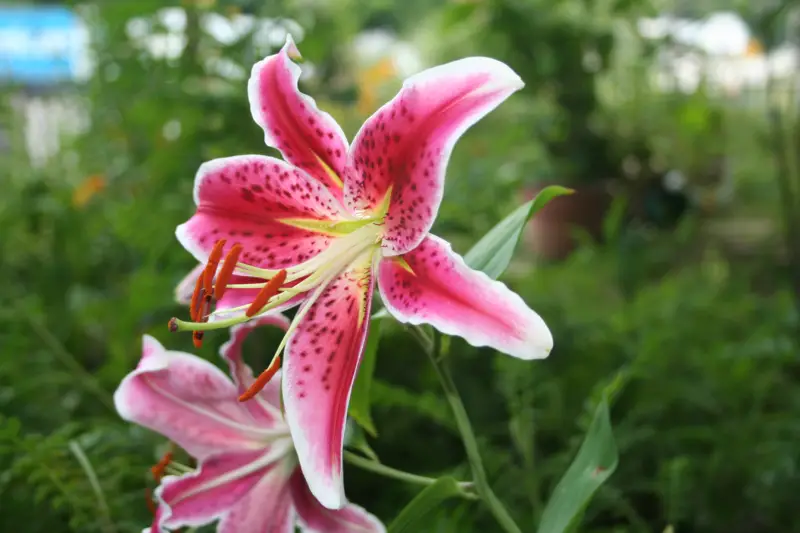
What My Garden Smells Like
From the beginning I knew I wanted a highly fragrant garden .
It’s been nine years in the making, but I can say this year has made it all worth it.
This year is a time when I wish there was a scratch and sniff button on my website so you could smell the flowers as I begin describing the garden scents.
The fragrance from the garden gently drifts through the open doors and windows creating an array of heady, floral scents in my house that changes as often as the wind does.
The smell of honeysuckle rules most of the time – it’s heavy, overpowering fragrance conquers all the other scents in the garden – except the old fashion mock orange whose citrus notes compete and at times, overpower or combine so well with the honeysuckle that it’s hard to tell which is which.
Roses abound in my garden , as those of you who look at the photos know.
Each one of the roses has a different scent – and this was a deliberate choice.
Some smell like pure old fashion roses , some have citrus notes, some are not scented at all and to confuse the nose even more, the sweet briar rose has apple scented leaves that adds its own dimension of fragrance to the garden.
Combine these fragrances with the dame’s rocket, peonies, sweet shrub, lilies plus some of the other scented plants that are flowering at this time (the plants change from day to day) and you truly have the makings of a highly fragrant floral perfume.

What My Garden Sounds Like
I love the sound of tinkling wind chimes, birds, burbling waterfalls and plants gently rustling in the wind.
When these sounds combine, it’s really amazing.
Throughout the garden there are wind chimes of different sizes and shapes.
Every one makes a different tinkling sound.
Some are barely noticeable, others are very loud with more of a noisy clanging than a gentle tinkling – but it generally takes a pretty strong wind to get the larger chimes to move.
Sometimes a chipmunk or squirrel set them off, but not very often.
When the squirrels come across them, you hear a chirping sound followed by a high pitched barking before they scramble up a tree.
I add new windchimes every year.
I tend to choose cheaper ones because they don’t last.
I don’t bring them in when summer is over.
They are bought for the garden and that is where they remain until the fall apart.
I then collect the pieces of the wind chimes and hope someday to put them back together.
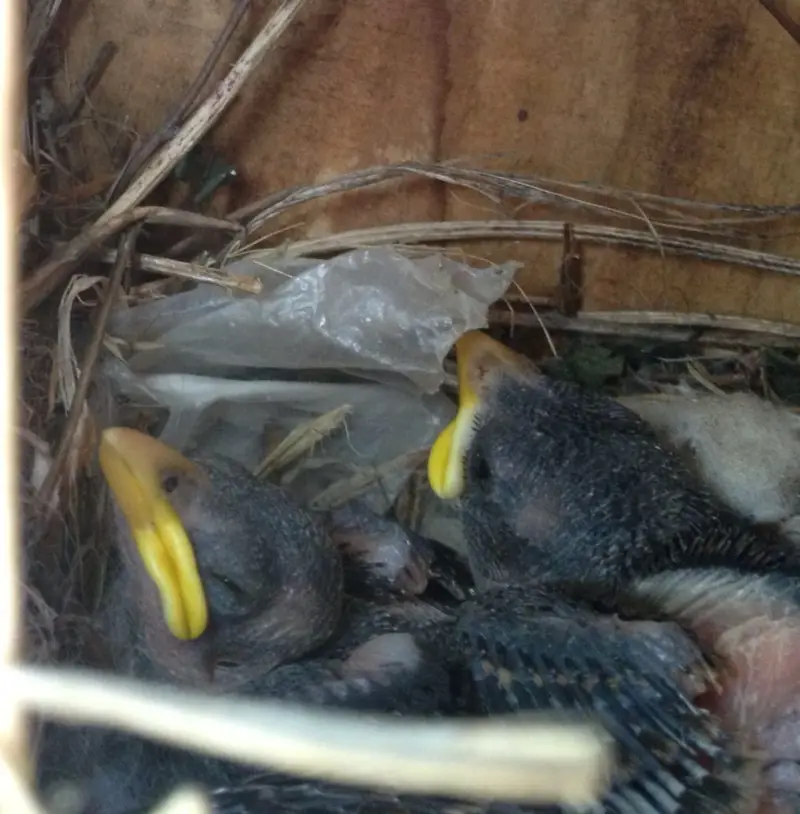
This year my garden is filled with the sounds of birds chirping.
It wasn’t always like this.
In fact, in the beginning, the bird feeders would sit for days untouched.
Sometimes I would have to toss the bird seed because it rained and ruint it.
Those days are long gone.
This year there are bird nests – filled with baby birds – all over the property.
I have lots of bird houses, but some birds choose to build their nests in trees, shrubs or among the plants.
All types of birds are welcome here and I absolutely love the sound of birds chirping.
Nothing says good morning quite like the cheery sound of happy birds.
The other thing that I am noticing for the first time this year is the gentle rustle of the plants – specifically some of the ornamental grasses .
The sounds of the plants rustling are not prominent, but when you walk past an area – or are sitting in an area – where the wind is gently moving the plants, you do notice.
The rustling is soothing in a way – not harsh or irritating.
In fact, were it not for the occassional vehicle driving by or sound of voices, I could easily forget I was right at the edge of the city.
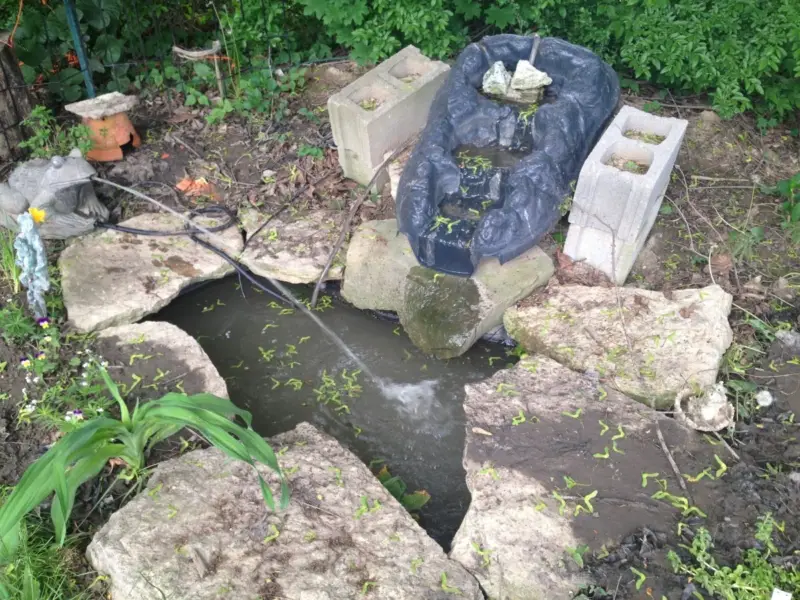
My other love is the sound of moving water – which may seem strange given the fact that I am afraid of water.
I have always been afraid of water since I was a young child, but when my ex-husband tried to drown me in the bathtub, that fear became greater.
There are three ponds currently on the property and there are plans to add a fourth one.
The new pond is going to be large enough to raise catfish in – the other three are strictly ornamental ponds that goldfish and water lilies thrive in.
I have an array of fountains, waterfalls, colored lights and even a fogger in the ponds.
I truly find the burbling sound of falling water soothing.
The birds, butterflies, bees and other small animals are also attracted to the sounds of water and every year there are numerous frogs and toads that come here to live.
I love seeing tiny frogs and toads in and around the pond areas.
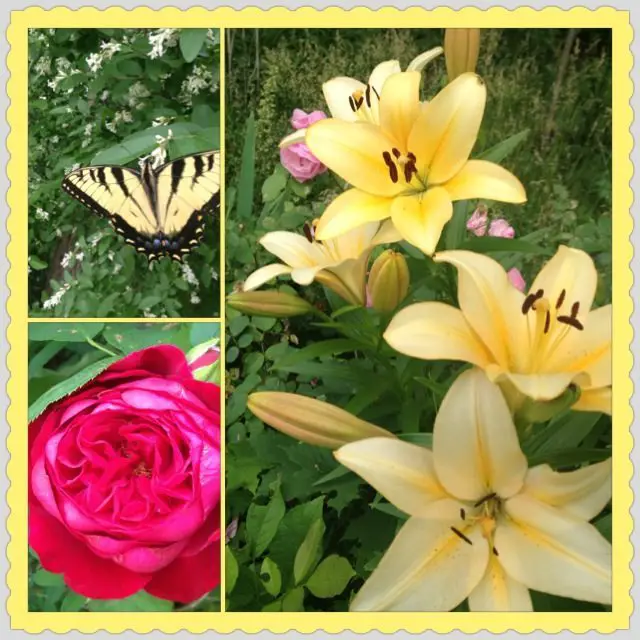
What My Garden Looks Like
Oh – the lovely sights of the garden – are truly a sight to behold.
There is color everywhere – bright color, subtle color – pinks, reds, yellows, oranges, purples, greens – you name it.
I have contrasting colors and harmonizing colors side by side.
Red and purple.
Green and red.
Pink and red.
Grey and yellow-green.
Orange and purple.
The garden is simply a riot of color – and the colors change on a regular basis as some flowers on certain plants fade and new plants with different colored flowers burst into bloom.
The grouping that spoke to me today was a mix of a ground cover with yellow-green flowers that was planted in between a vibrant red rose and a patch of soft, grey lamb’s ears.
The three colors together look really good.
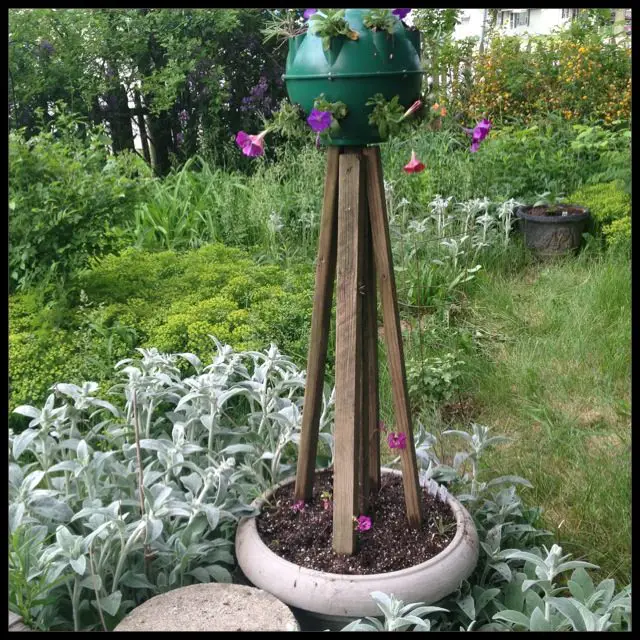
The lamb’s ears beckoned to me to gently caress them.
Their leaves are so soft – they remind me of petting a small kitten.
The red rose towered above the yellow-green flowers of the groundcover really brought the other two plants together and made the red of the roses stand out even more.
There are numerous groupings like this all along the garden path.
Some just seem to stand out more than others on different days possibly because of how the sunlight plays off the petals and leaves of the plants at different times of the day.
So, I hope you have enjoyed my attempt at describing the garden.
It has not been an easy task.
The good news is there are lots of videos on my YouTube Channel of the garden if you wish to see parts of the garden for yourself.
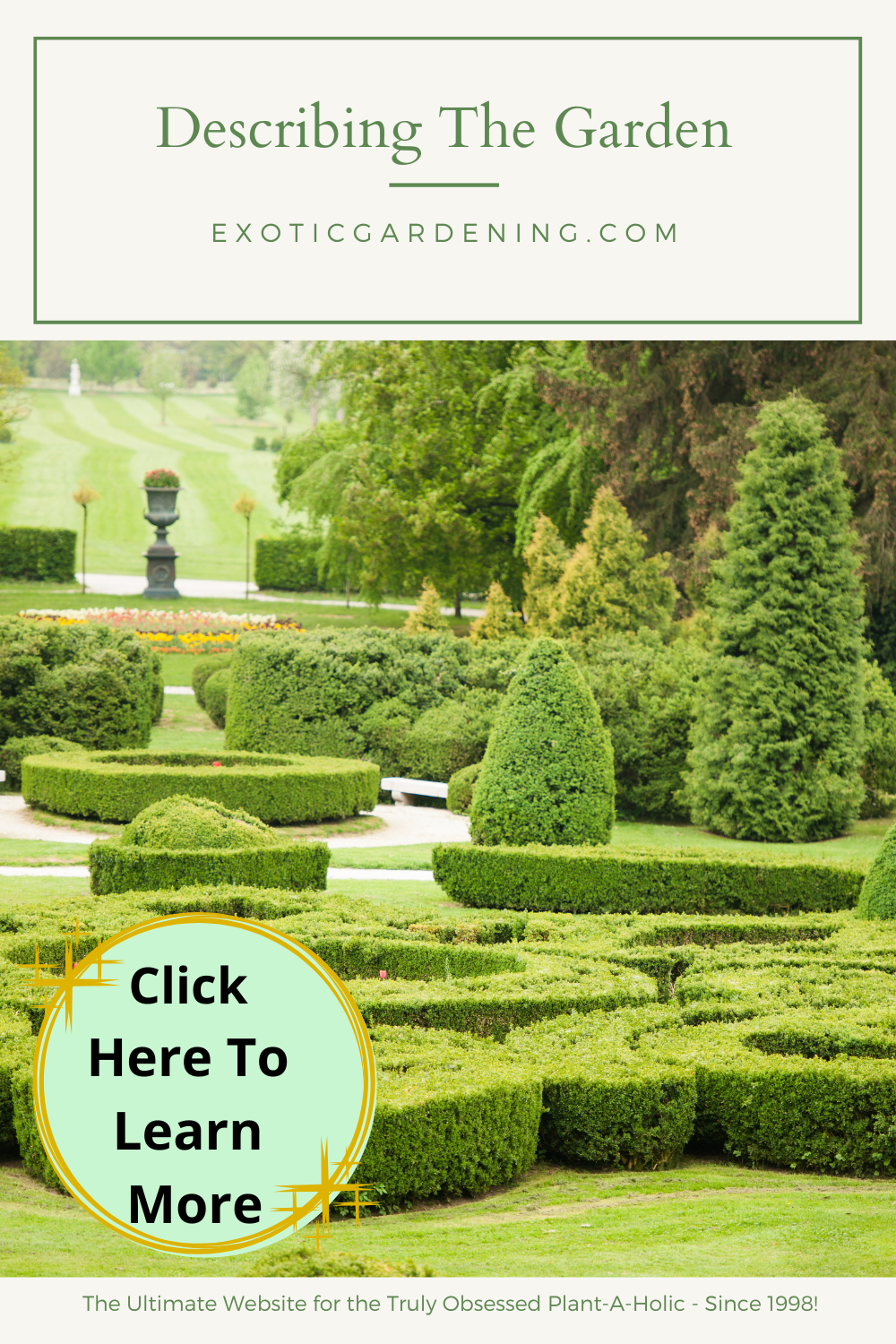
Perennial Plants
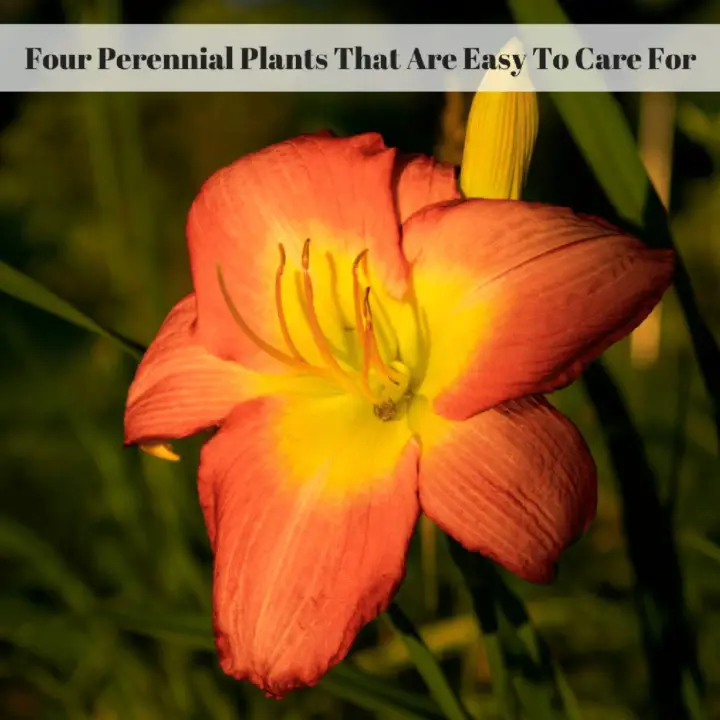
Four Perennial Plants That Are Easy To Care For
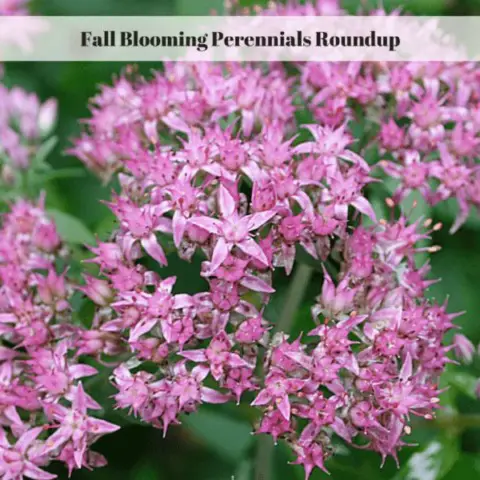
Fall Blooming Perennials Roundup
Awesome colorful plant combinations: reliable daylily and geranium.
If you're looking for a colorful, easy to care for perennial plant combination, try the daylily and geranium.
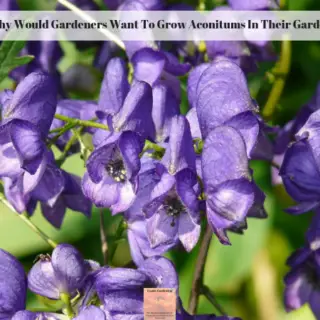
Why Would Gardeners Want To Grow Aconitums In Their Garden
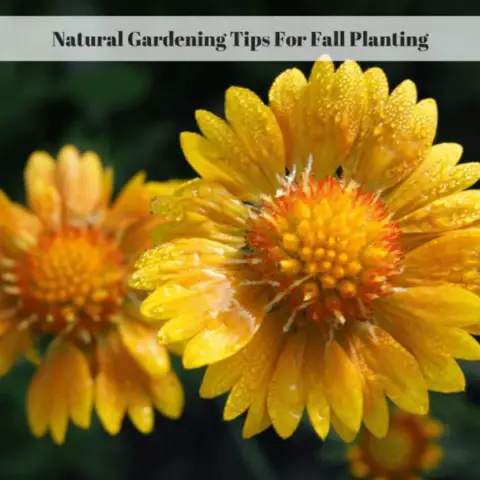
Natural Gardening Tips For Fall Planting
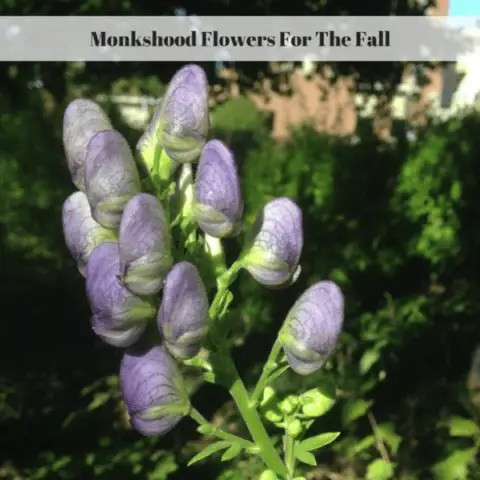
Monkshood Flowers For The Fall
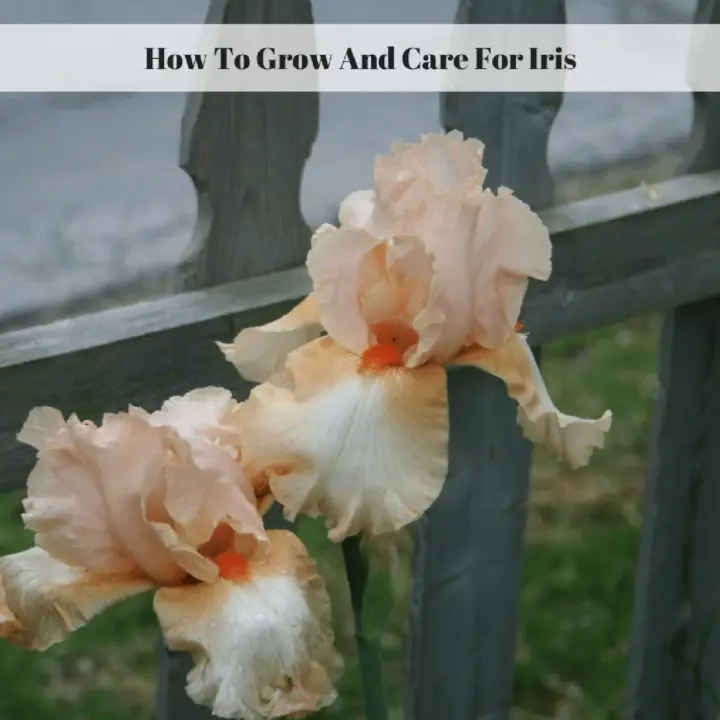
How To Grow And Care For Iris
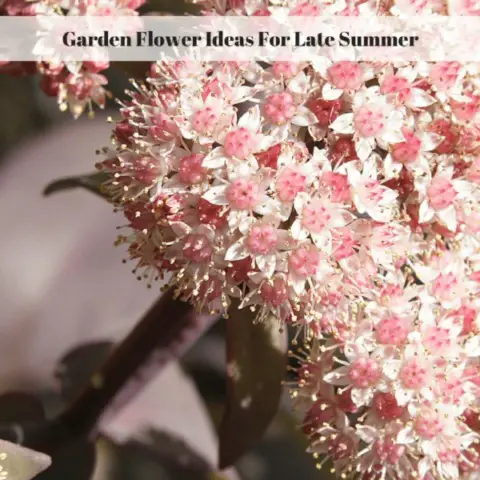
Garden Flower Ideas For Late Summer
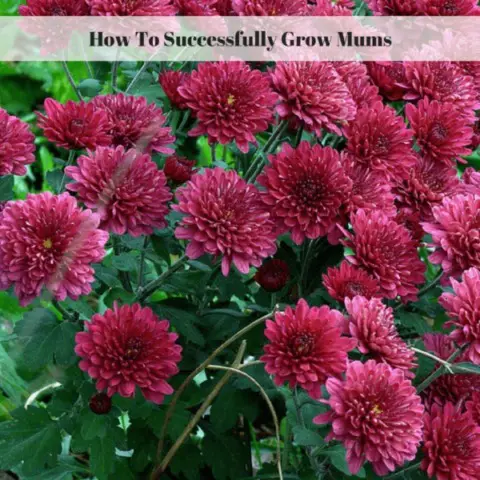
How To Successfully Grow Mums
Chrysanthemums, commonly referred to as mums are a beautiful fall blooming plant. Check out these tips to successfully grow mums!
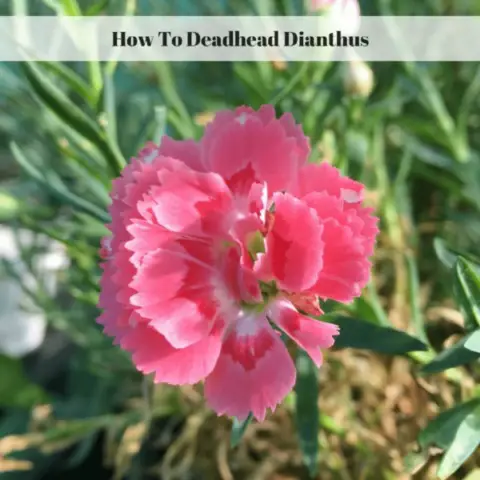
How To Deadhead Dianthus
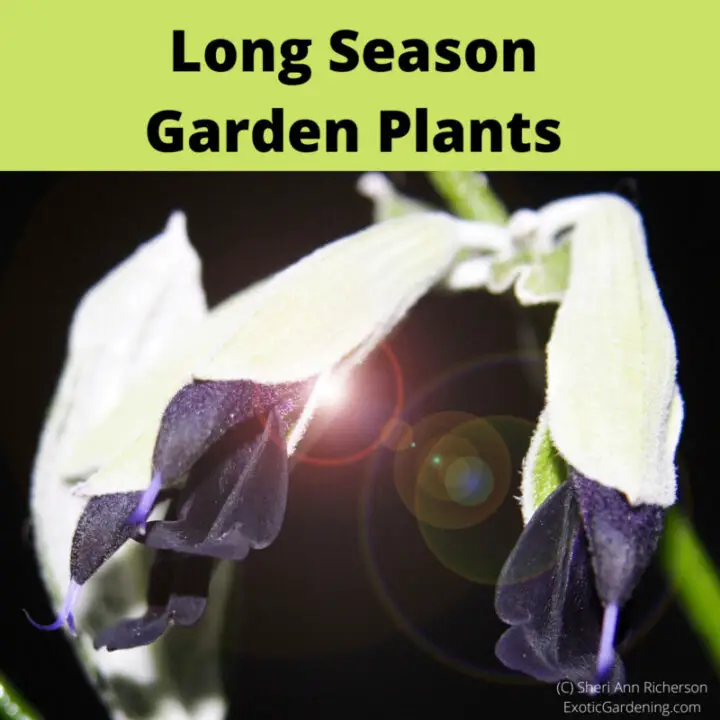
Long Season Garden Plants
Plant Life Cycles: Understanding Plant Life Cycles Leads to Botanical Success
#monrovia has the best bee, butterfly and bird attracting plants for sale, how to care for bare root stock.
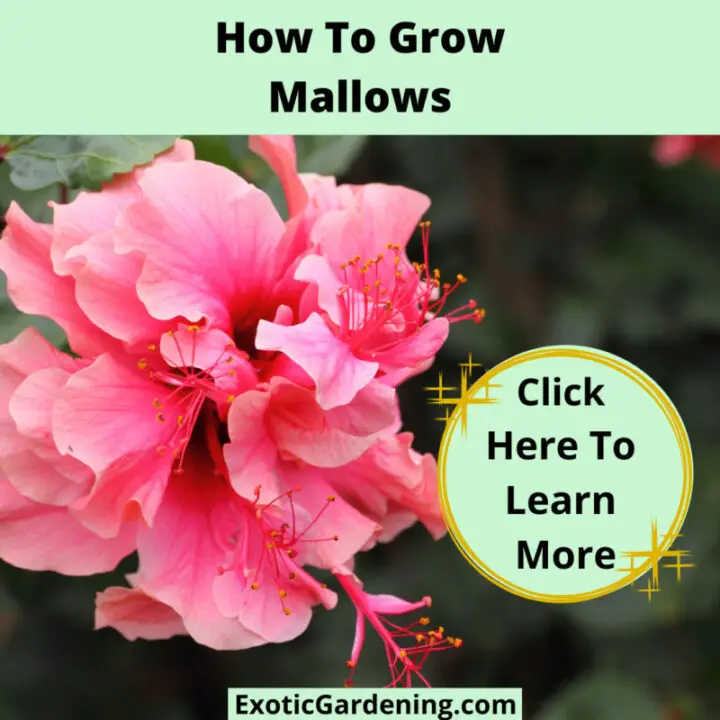
How To Grow Mallows
Learn how to grow mallows, a Malvaceae family which includes some of the most popular plants for the home garden, Hibiscus.
Daylilies: Attractive, Colorful, Easy To Grow Garden Gems
Try scented grass for natural fragrances like vanilla, rose or lemon.
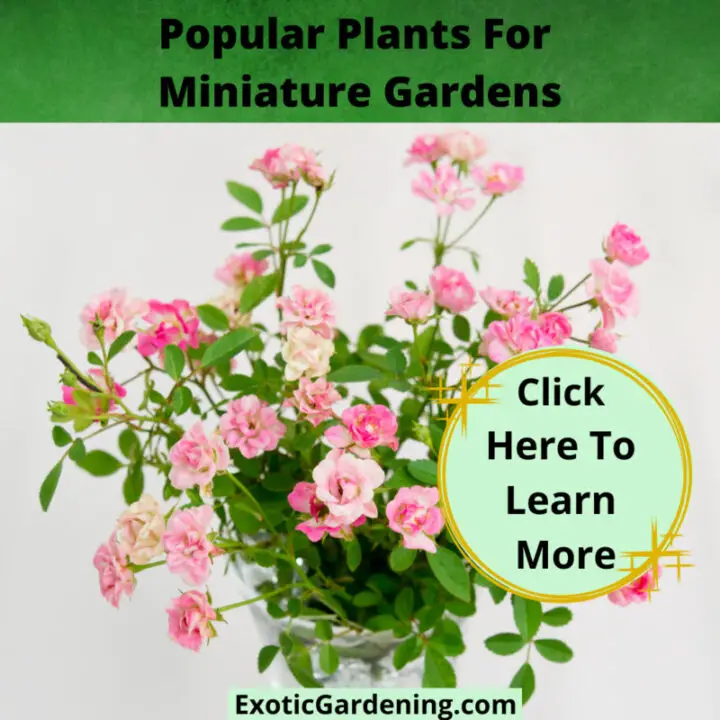
Popular Plants For Miniature Gardens
There are a number of popular miniature plants that are ideal to use to create miniature gardens inside or outside your home or office.
Sweet Autumn Clematis: A Garden Treasure
Discover the enchantment of Sweet Autumn Clematis: rapid growth, fragrant blooms, and versatile garden beauty await!
This site uses Akismet to reduce spam. Learn how your comment data is processed .
Tuesday 22nd of June 2021
it helped for my creative writing bye
Kathleen Anderson
Tuesday 15th of December 2020
This is just wonderful. And you do have an interesting and beautiful talent for descrdiption.
Sheri Ann Richerson
Thursday 31st of December 2020
Thank you very much!
Jenny Coffman
Tuesday 30th of April 2019
Hi Sheri, Your use of the English ;language to write the feelings, thoughts and sounds of your garden are very inspiring. One of my collections is of flowers, so when creating my website, I found yours to describe flowers. I was so inspired by you, that I even linked my clients to your page in my description. I hope you are ok with me using your words. Feel free to take a peek at how I used them here: https://artskiandhush.com/collections/flower-collection And if your quote was not represented well, please let me know! Thanks! Jenny Coffman Digital Illustrator Artski & Hush ArtskiandHush.com
Saturday 31st of March 2018
Nice I loved it it helped me for my English assignment
Sunday 13th of May 2018
Really nice descriptions! Your garden sounds truly beautiful.
Tuesday 8th of May 2018
Copyright (C) Sheri Ann Richerson, ExoticGardening.com 1998 - 2021

Privacy Overview

How to Describe a Garden?

When it comes to gardens, everyone has their own opinion on what makes a great one. Some people love sprawling gardens with a variety of plants and flowers, while others prefer something more minimalist with just a few choice plants. No matter what your preference is, there are some tips that can help you when writing about your garden. In this blog post, we will discuss how to describe your garden in a way that captures its essence and makes readers want to visit!
What is a garden?
A garden is a place where plants are grown, typically for ornamental purposes. Gardens may be designed by professional landscapers, hobbyists, or amateurs. There are many different types of gardens, including public parks, private yards, and community gardens. [1]
What does a garden symbolize?
A garden is often seen as a symbol of life, growth, and abundance . In many cultures, gardens are also seen as a place of refuge and relaxation.
What is a description and example?
There are many reasons why someone might want to write about a garden. Maybe they have fond memories of spending time in their own backyard garden as a child.
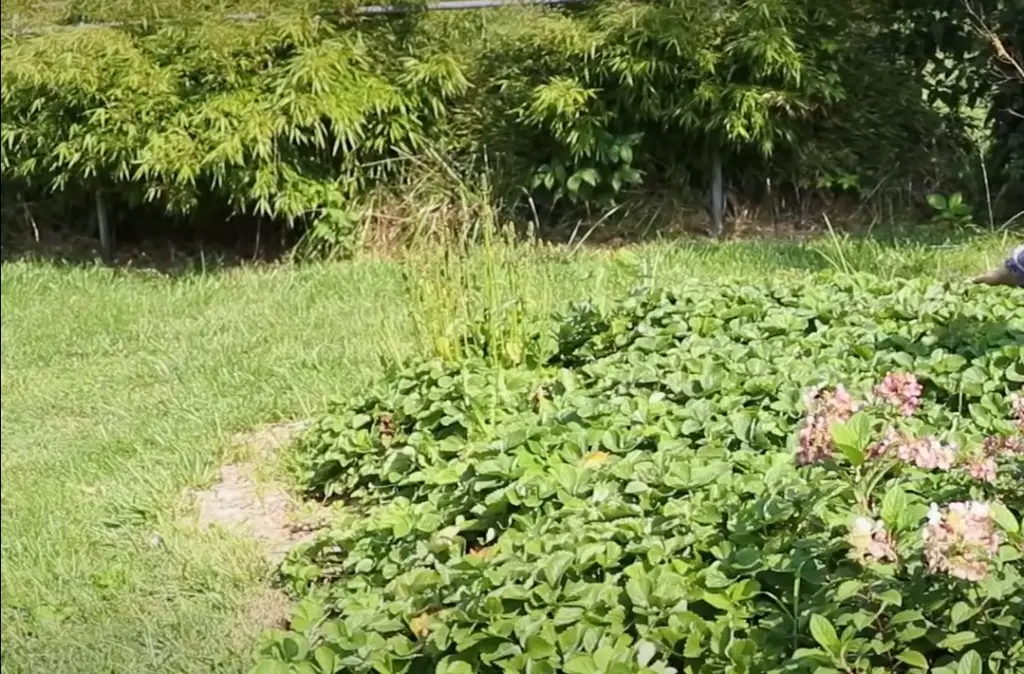
Or maybe they find the process of gardening therapeutic and calming. Whatever the reason, writing about a garden can be a fun and rewarding experience. [2]
A description is a word or phrase that describes someone or something. An example of a description is the word “blue” which describes the color of the sky. When writing about a garden, it is important to choose descriptive words that will help paint a picture for the reader. Here are some tips for writing about your favorite outdoor space :
Think about what makes your garden special and unique. Is it the plants you have chosen? The layout? The way the sun hits it at different times of day?
- Make a list of all the things you love about your garden.
- Look at your list and choose the three most important aspects of your garden. These will be the focus of your description.
- Now, it’s time to start writing! Begin by describing the overall feeling or atmosphere of your garden. Is it peaceful? Relaxing? Inviting?
- Next, describe the three elements you chose as the focus of your description. Be sure to use plenty of adjectives and sensory details. For example, if you are describing the flowers in your garden, you might say: “The brightly colored flowers are arranged in neat rows and they smell sweet.”
- Finally, wrap up your description by giving a general overview of the rest of the garden. What else can be found there? A pond? A fountain? A gazebo?
By following these tips, you will be able to write a garden description that will transport your readers to your outdoor oasis!
What’s the quickest way to summarize your description in a few words?
One way to do this is to focus on the five senses : what can you see, smell, hear, taste, and feel in the garden? This will give your reader a well-rounded picture of the space. For example, if you’re describing a rose garden, you might say that it’s full of beautiful blooms in shades of pink and red. You might also describe the sweet fragrance in the air, or how the petals feel soft to the touch.
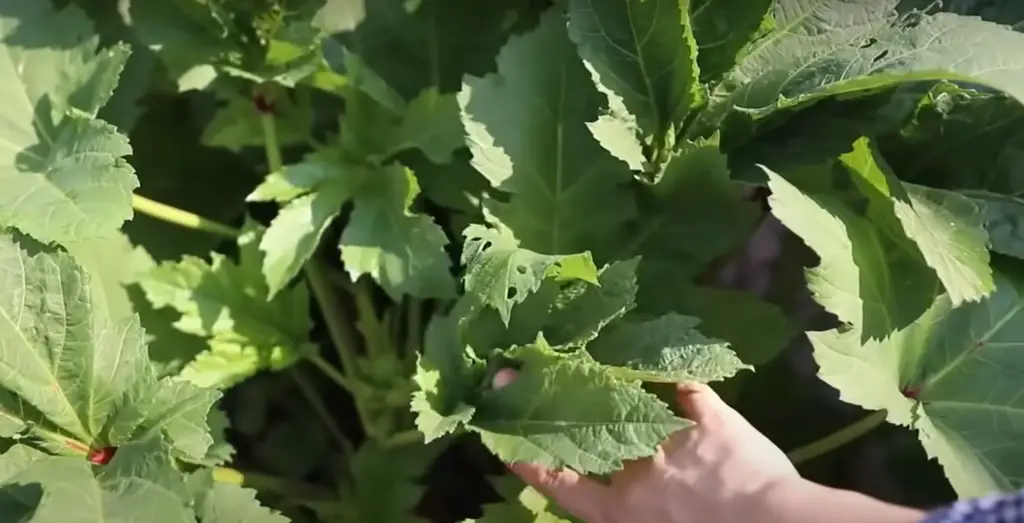
Another tip is to use strong adjectives to really bring your descriptions to life. Instead of simply saying that there are flowers in the garden, try using words like “abundant,” “lush,” or “colorful.” This will help paint a vivid picture for your reader.
Finally, don’t forget to describe the overall mood or feeling of the garde n . Is it peaceful and serene? Playful and whimsical? Romantic and enchanting? Use your words to transport your reader into this special place.
What are creative words?
Assuming you want tips for writing about your favorite outdoor space:
When describing a garden, try to evoke as many senses as possible. What does it look like? Is the grass green or brown? Are there flowers or trees? What type of flowers and trees? How tall are they? What does it smell like? Is there a particular fragrance that reminds you of the garden? What does it sound like? Is there a waterfall or fountain? Birds chirping? Kids laughing? What does it feel like? Soft grass beneath your feet or prickly stones underfoot? Warm sun on your skin or cool shade from the trees overhead. The more senses you can engage, the more real the garden will feel to your readers. [3]
What is a juicy sentence?
A juicy sentence is one that is full of sensory details and concrete images.
When you’re describing your garden, try to use as many juicy sentences as possible. Describe the way the sun feels on your skin, the smell of the flowers in the air, and the sound of the bees buzzing around you. The more vivid your descriptions, the more likely it is that your readers will be able to imagine themselves in your garden.
Here are a few tips to help you write juicier sentences:
- Use lots of adjectives . Adjectives are words that describe, and the more adjectives you use, the more detailed your description will be.
- Use concrete images . Instead of saying “I feel so peaceful in my garden,” say “I feel like I’m in a different world when I’m in my garden.”
- Use all five senses . In addition to using adjectives to describe what you see, also use adjectives to describe what you hear, smell, taste, and feel.
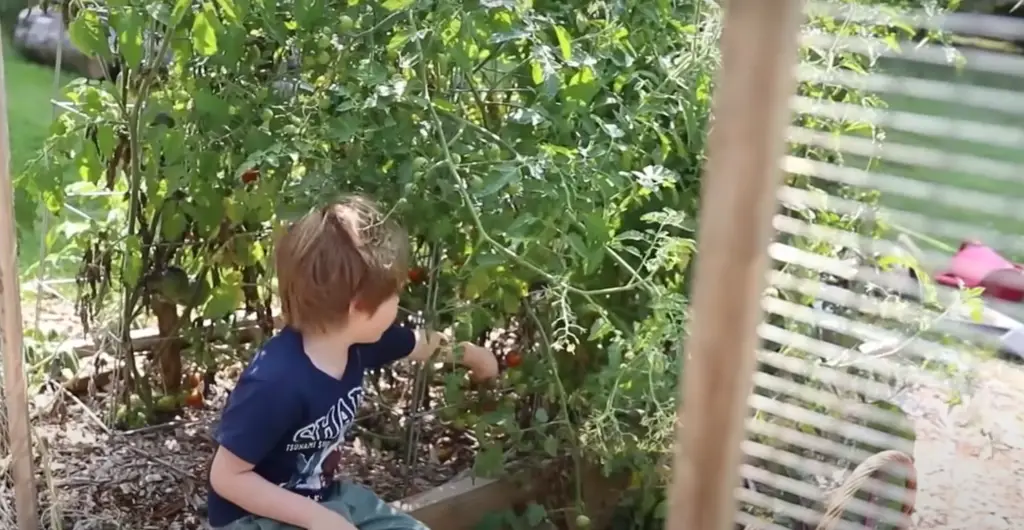
By following these tips, you’ll be well on your way to writing juicier sentences that will make your readers feel as if they’re right there in your garden with you. [4]
Memorable Words to Describe Your Garden:
When you’re writing about your garden, you want to choose words that will create a lasting impression on your reader. Here are a few tips to get you started:
- Think about the five senses : What do you see, smell, hear, taste, and feel in your garden? Describing these sensory details will help create a vivid picture for your reader.
- Choose colorful words : A garden is a great opportunity to use some of those more unusual words you’ve been wanting to try out. Go ahead and unleash your inner poet!
- Be specific : Rather than saying “the flowers were beautiful,” try describing exactly what you saw: “The tulips were a deep red, with delicate petals that looked like they had been painted by a master artist.”
The more specific you are, the easier it will be for your reader to imagine being in your garden. [5]
Writing About Flowers In A Descriptive Style
When it comes to describing a garden, there are endless ways to do so. You can go the scientific route and describe the types of flowers present. Or, you can take a more creative approach and use adjectives to paint a picture with your words. No matter which route you choose, there are some tips that will help you write about your favorite outdoor space in a way that does justice to its beauty.
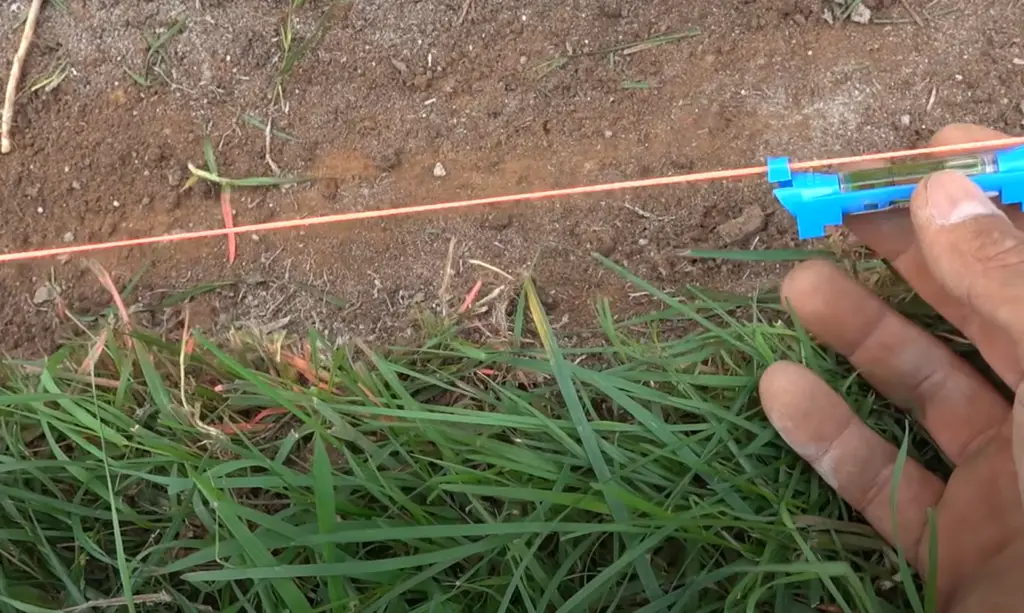
If you’re going for a scientific description, start by researching the different types of flowers that are in your garden. Make note of their Latin names as well as any common names that they might have. Once you have all of this information gathered, you can start writing your description. Start by listing the different types of flowers and then move on to describe their appearance.
If you’re going for a more creative description, start by brainstorming a list of adjectives that you feel accurately describe your garden. Once you have your list, start writing sentences that incorporate these words.
Use words that describe both the physical appearance of the garden as well as its smell, sound, and feel.
What Your Garden Smells Like
One of the most important ways to describe your garden is through its smell . This can be tricky, as different smells evoke different memories and feelings in different people. However, if you can find the right words to describe the scent of your garden, you’ll be able to transport your readers into your outdoor space and give them a true sense of what it’s like.
To get started, close your eyes and take a deep breath in through your nose. What do you smell? Is it fresh or earthy? Sweet or spicy? Take note of the different smells that make up the overall scent of your garden, and then try to find words that describe each individual aroma. Once you’ve done that, you can start putting together a description of the overall smell of your garden.

For example, you might say that your garden smells “like a freshly mowed lawn with a hint of roses.” Or, “The air is thick with the scent of jasmine and lavender.” Whatever it is that you smell, try to be as specific as possible so that your readers can imagine it for themselves. [6]
What Your Garden Sounds Like
In addition to smells, sounds are also an important part of the garden experience . Whether it’s the sound of birds chirping, leaves rustling in the breeze, or water trickling down a fountain, the noises in your garden can transport you to another world and make you feel calm and relaxed.
When you’re trying to describe the soundscape of your garden, again, be as specific as possible . Rather than saying “it’s peaceful,” try to describe exactly what you’re hearing. For example, “The only sound is the gentle trickle of water from the fountain.” Or, “I can hear the wind rustling through the trees and the birds singing in the distance.” By painting a detailed picture with your words, you’ll be able to give your readers a true sense of what it’s like to experience your garden. When writing about your garden, be sure to describe any sounds that contribute to its peaceful atmosphere.
What Your Garden Looks Like
Of course, the visual appearance of your garden is also important. When describing what your garden looks like, start by thinking about the overall feel of the space. Is it formal or informal? Colorful or subdued? Then, take note of any specific features that contribute to that feeling.
For example, if your garden is formal, you might describe “the perfectly manicured hedges and symmetrical flower beds.” Or, if it’s informal, you might say “the wildflowers that grow along the fence line.” No matter what kind of garden you have, there are sure to be some unique features that make it special. Be sure to include those in your description so that your readers can get a sense of what makes your garden so special to you.

When you’re finished, your description of your garden should give readers a clear sense of what it smells like, sounds like, and looks like.
Comparison Table: Indicators of Different Gardens
Describing a garden is a delightful task that involves capturing its essence through various indicators. In this comparative analysis, we explore different aspects of gardens and compare them across four categories: Size, Biodiversity, Aesthetics, and Maintenance. The data in the table provides insights into the diversity and beauty of gardens.
Explanation:
- Size: Gardens are classified based on their area into small (100-500 sq. ft.), medium (501-1500 sq. ft.), and large (above 1500 sq. ft.) categories.
- Biodiversity: The number of plant species in a garden varies, and it can be low (20-50), moderate (51-100), or high (above 100).
- Aesthetics: Gardens are rated on their beauty, with small gardens typically scoring 5-7, medium gardens scoring 7.5-9, and large gardens achieving a near-perfect rating of 9.5-10.
- Maintenance: The time spent on garden upkeep varies; small gardens require 2-5 hours of maintenance per week, medium gardens demand 6-10 hours, while large gardens need more than 10 hours.
Gardens come in various sizes, have diverse flora, and are subject to different levels of maintenance. The aesthetics of a garden often align with its size and maintenance effort, making each type unique and charming in its way. Whether you have a small, medium, or large garden, they all have their distinctive appeal and beauty to be celebrated.
What do I say about my yard?
To describe your garden, start by thinking about what kind of mood you want to create. Do you want it to be inviting and cheerful? Serene and calming? Romantic and whimsical? Once you have a general feel for the atmosphere you’re going for, begin brainstorming adjectives that fit that theme.
Some other things to consider when describing your garden:
- The type of plants and flowers you have
- The layout or design
- Any unique features like fountains, bird baths, etc.
- The time of day or year (is it sunny or shaded? Is the grass green or brown?)
- How well maintained it is
With all of these elements in mind, start writing! A few sentences is all you need to set the scene and give your readers a sense of what your garden looks and feels like.
What would you say a flourishing garden is?
Is it a place where colorful flowers bloom and bees buzz? Is it a neat row of vegetables, or a wild tangle of roses?
Gardens are as diverse as the people who tend them. But whether you have a green thumb or not, everyone can appreciate a beautiful garden.
First, think about what kind of garden you have. This will help determine the style of your description. A formal garden with straight lines and clipped hedges will be described differently than an English cottage garden with winding paths and overgrown flowers.
Next, consider the senses. What does the garden look like? What does it smell like? Are there any sounds?
Is it a peaceful oasis or a riot of color and activity? How does it make you feel?
All of these details will help create a vivid picture for your reader.
Finally, don’t forget to describe the gardener! A well-tended garden is a reflection of the person who tends it.
Include some details about their personality and what they’ve created.
What do you term an English garden?
It is a mix of the wild and the cultivated, with an underlying orderliness. That might be one way to describe it. But every gardener will have his or her own take on what defines an English garden.
In Jane Austen’s “Pride and Prejudice,” Mr. Darcy describes his estate, Pemberley, as follows: “It was a large, handsome, stone building standing well on rising ground, and backed by a hill… .” If you were to ask Elizabeth Bennet what she thought of Mr. Darcy’s home after visiting it for the first time, she would probably say something quite different than he does. And that is as it should be.
The same can be said of any garden, large or small. It is the gardener’s perspective that counts.
How would you describe a stunning plant to someone who has never seen one?
You could say it is a thing of beauty, or that it takes your breath away.
But if you want to be more specific, you might say it is an “African daisy with striking yellow petals and a deep red center.”
Now that is a description that will give your reader a good idea of what the plant looks like.
When writing about your garden, try to describe it as if you were showing it to someone who has never seen it before.
What are its most distinguishing features? What makes it special to you?
By sharing your own perspective, you will give your readers a glimpse into the world of gardening through your eyes. And that is what makes for great garden writing.
What are describing words?
They are adjectives that help give your writing more detail. When you describe a garden, try to use as many of the five senses as possible. What does it look like? What colors do you see? What does it smell like? Is there a particular taste associated with the garden, such as the sweetness of ripe fruit or herbs? And finally, what does it sound like? Is there a fountain or stream bubbling in the background, or perhaps birds singing in the trees?
By using all of these senses, you can create a vivid and detailed picture for your reader that will transport them into your own personal outdoor oasis.
How do I start describing a garden?
To start describing a garden, take a moment to observe and note down its overall appearance, the types of plants present, the color scheme, and any unique features that stand out to you.
What are some adjectives to describe a garden’s appearance?
Some adjectives to describe a garden’s appearance could be lush, vibrant, well-maintained, manicured, wild, enchanting, tranquil, or inviting.
How can I describe the plant diversity in a garden?
You can describe the plant diversity in a garden by mentioning the various types of flowers, shrubs, trees, herbs, and other greenery present, highlighting their different colors, shapes, and sizes.
What elements can I mention when describing the layout of a garden?
When describing the layout of a garden, you can mention pathways, borders, garden beds, sculptures, fountains, seating areas, and the arrangement of different plant groups.
How do I describe the scents in a garden?
To describe the scents in a garden, pay attention to the fragrance of different flowers and plants, and use adjectives like sweet, aromatic, refreshing, or intoxicating to capture the sensory experience.
What kind of wildlife can be mentioned while describing a garden?
While describing a garden, you can mention the presence of butterflies, bees, birds, ladybugs, and other insects that are attracted to the flowers and contribute to the garden’s ecosystem.
How can I portray the atmosphere of a garden through words?
To portray the atmosphere of a garden, use words like serene, peaceful, lively, harmonious, joyful, or magical to convey the feelings and emotions it evokes.
What aspects can I focus on when describing the colors in a garden?
When describing the colors in a garden, focus on the dominant color scheme, contrasting hues, and the way colors change with the seasons, using terms like vibrant, pastel, earthy, or bold.
How can I describe the maintenance level of a garden?
To describe the maintenance level of a garden, mention if it appears well-tended, neatly arranged, and carefully pruned, or if it has a more natural, untamed look with minimal intervention.
What are some phrases to describe the overall ambiance of a garden?
Some phrases to describe the overall ambiance of a garden include “a haven of tranquility,” “a burst of colors and life,” “a symphony of nature,” “a delightful sensory experience,” or “a slice of paradise.”
Useful Video: How to make a garden bed edging – Easy DIY
Final words.
No matter what type of garden you have, these tips will help you describe it in a way that does justice to its natural beauty. With a little practice, you’ll be able to capture the magic of your outdoor space in words. So get writing and enjoy the process of exploring your favorite place in new ways. Thanks for reading!
Do you have any other tips for how to describe a garden? Share them in the comments below! And if you enjoyed this post, please share it with your fellow gardening enthusiasts. Happy writing!
References:
- https://www.dictionary.com/browse/gardens
- https://symbolism.fandom.com/wiki/Garden
- https://www.exoticgardening.com/describing-the-garden/
- https://achievethecore.org/content/upload/Juicy%20Sentence%20Guidance.pdf
- https://describingwords.io/for/garden
- https://madisonessentials.com/Article/2017-05/Scent-Garden
- https://themicrogardener.com/ten-tips-for-creating-beautiful-gardens/
How to Get Rid of Aphids on Lettuce?

How to Sharpen Blades on a Reel Mower?

How to Cut Gardenia Flowers?

How to Make a Moss Wall Garden?

Best 11 Plus Online Practice Exams|11+|Free Tests|Independent Schools|CEM | CSSE|GL Assessment|Creative Writing| 11 Plus Forum|Mock Exams – 11Plus e Help | 11PluseHelp.co.uk
Best 11 Plus Online Practice Exams
Creative Writing : “The Magical Garden” by Sridhana
Creative Writing: “The Magical Garden” Sridhana

It is wide and open, sloping gently down to a cosmic-blue river. A corpse (grove) of cypress pines flanks us on one side, with a thicket (grove) of peaceful beeches standing guard on the other. Apple trees run through the centre of the garden, casting a lake of claw shadows onto the grass. In autumn, the fiery brilliance of their leaves is a sight: scorching oranges, burning browns and molten reds. Then they drift to the ground as silently and carelessly as an ash cloud, settling into their eternal rest.
Past the river, there is a plush-green meadow that stretches away into the vastness and a dragon-backed mountain. In winter, the stricken (overwhelming) loneliness of its peak sends shivers down my spine, wondering how anything could survive up there. The fog that coils around it seems as old and fey (unearthly) and grey as the mountain itself, an alien presence that can dampen any mood. I call it Crimean Mountain, the ancient name for the land of perpetual mist. When spring finally comes, antediluvian (multi-coloured) rainbows drench the mountain with coloured fire and the light leaks into the garden.
And that is why I love spring in the garden so much. After January, there is stained glass clarity to the sunbeams. It starts with panes of light poking the shadows and making the earth steam. Midges rise with the grass mist, hanging like moon dust in the glassy haze. Daffodils detonate from the ground overnight as if some necromancer (warlock) had put a spell of banishment on the winter. Hey presto and it’s gone. Lipstick-pink peonies adorn the fringes of the garden and honeysuckle festoons (wraps around) the hedges with their ladylike perfume. The aroma of geosyncline (earth smell) percolates through the air. If you inhale deep enough, the potpourri of scents registers as a sweet mix of jasmine, grass vapour and blossoms.
As if on cue, the herald of spring arrives after taking a sabbatical for the winter. The blackbird is the main player in the dawn chorus, his song as clear and fresh as the garden he will later raid. Warbling wrens and carolling chaffinches join him, creating an orchestra of sound. It cascades into the open spaces, ghosts through windows and onto the smiling lips of the sleepers within. This earth song of nature rouses the rest of the animals from their slumber. Dozy hedgehogs totter like zombies as they get drunk on the last of the rotten apples. Butterflies flutter through the air with their velvet wings. Above them, a murmuration (flock) of starling’s loop and reel like wind-tossed gunpowder. As the grass in the garden grows to Jurassic heights, pheasants cluck like cockerels and sprint like roadrunners, celebrating the arrival of spring.
The river I told you about earlier has a magical quality to it that I haven’t seen elsewhere. After the mountain snowmelt has purged it of its brandy-brown hue, usually in February, I love to take pre-breakfast walks down to it. The full glory of the garden is revealed as I idle past the suede soft flowers. They are tingling my fingers with nature’s electricity as I touch them. Jewel-green grasshoppers bounce off the flowers like leggy trampolines. Above me, the vault of the sky seems to grow wider and higher as the morning wears on. It increases the acoustics and magnifies the richness of colour. I can hear the lullaby of the breeze swishing through the trees much clearer now and little animals scurry and shuffle in the undergrowth. Versace-purple crocuses peep shyly at me and I am lost in the marvel of springtime.
I can see cobwebs in the grass, glistering in the littoral (of a sea/lake) light that the river reflects. They look like fishermen’s nets of finely meshed steel. There’s the most welcoming of scents in the air, a spearmint aroma that hangs and loiters above the wild garlic. I sit on the bench we made some time back and engage in my favourite pastime; river gazing. The water is lens clear and it is easy to spot the speckled trout at the bottom. Every so often, they explode up through the crystal water and soar into the air. Their hang time would do credit to Michael Jordan and like Nike, the Greek god of victory, they must have wings to stay up so long. Iridescent (brilliant of colour) kingfishers flash by in a flurry of blue and gold, using the river as a superhighway. Apart from the plunking of trout and the thrumming of wings, it is convent quiet at the bottom of the garden, a haven of peace and solitude.
I sit on the bench, watching the sun slowly rise over the Crimean mountain. At first, the lonely peak seems to hinder its ascent and it looks like an orc (crescent necklace) of oriole-gold (halo of a saint). Then its full splendour reveals itself and it soaks the garden with the effulgence (brightness) of its smile. I can see the sunlight chasing the crab-shadows of the apple trees across the steaming grass. A blackbird alights onto a nearby branch and launches into an avian aria (solo song). Within moments, a fusillade of bird song follows him, rupturing the silence of the morn. It is a welcome invasion of the peace, but I sigh as I get up from the bench. As I wend (wind) my way back through the enchanted garden and towards the house, I have only one wish; that those in slumberland within wear the same, easy smile that plays across my lips.
Creative Writing is a form of descriptive words Writing where creativity is at the forefront of its purpose. Here the writer must use his imagination , creativity , and innovation to tell a story through strong written visuals. Creative Writing is probably one of the most challenging sections of the 11+ exams for many students. The reason is that you could not gather enough thoughts under the tight time constraints during the exam. children can write stories on topics like a beautiful garden, secret garden and garden essay.
Do check out our article 11 Plus Creative Writing Practice:
11 Plus Creative Writing Practice
Your child can now have access to FREE 11 Plus Creative Writing Practice at 11plusehelp.co.uk.
11 Plus Free Creative Writing
FREE PRIVATE 11 Plus Creative Writing practice………….
Creative Writing for the 11 plus test is two ways – either you are asked to write an original story for the given title or complete a continuous prose exercise in the same writing style. Both types of tasks will examine your ability to plan, create and then write in a structured manner using good vocabulary.
11+ Creative writing and Story Writing:
11+ Creative writing and Story Writing
Creative Writing is the main difference between most Grammar Schools’ tests and Independent Schools’ tests. Grammar School tests usually don’t include this section as their tests are of multiple-choice format. However, Independent secondary Schools do because humans mark the tests.
11+ Creative Writing
Using Creative Writing Blog , the child can upload a creative writing piece. We publish the best Creative Writing pieces in our blog. This’ll encourage children to write a descriptive writing piece and improve writing skills. Creative Writing is also called Descriptive Writing.
11+ Creative Writings:
https://www.11plusehelp.co.uk/blog/2021/05/17/11-creative-writings/
11+ Creative Writing – what makes it more effective and impressive:
11+ Creative Writing – what makes it more effective and impressive?
You can also go through kids samples of 11 Plus Free Creative Writing here: https://www.11plusehelp.co.uk/blog/creative-writings/
If you wish, you can submit your children’s Creative Writings here: https://www.11plusehelp.co.uk/blog/submit-creative-writing/
11 Plus Creative Writing Blog :
https://www.11plusehelp.co.uk/blog/category/creative-writings/
Please note that you can upload the 11+ Creative Writings either by directly typing or by taking a picture and attaching it here: https://www.11plusehelp.co.uk/blog/submit-creative-writing/
11plusehelp.co.uk is a detailed online platform with a lot of explanations. Register for FREE or log in to view to access tests and downloadable resources. We offer many practice tests that are useful for Grammar school and Independent school entrance exam preparation.
11 Plus Complete Features
11 Plus Revision Pack:
https://www.11plusehelp.co.uk/11-plus-practice-papers/11-plus-english-practice-test-papers/revision-pack
You can access 11 Plus Exam FREE Papers by visiting the below link: https://www.11plusehelp.co.uk/11-plus-free-online-papers
You can access 11 Plus Exam FREE Sample Papers by visiting the below link: https://www.11plusehelp.co.uk/11-plus-sample-papers
11 Plus Complete solution features can be found here: https://www.11plusehelp.co.uk/blog/2017/05/01/11-plus-complete-solution/
Practice and Perseverance Over Genius and Talent
11Plusehelp.co.uk
Published by 11PluseHelp
View all posts by 11PluseHelp
13 Replies to “Creative Writing : “The Magical Garden” by Sridhana”
nice work i love it
I love it. This is great creative writing.
I like it. Good use of everything do stuff like this Don’t forget! 😀 😀 😀
Even i like it, so nice.keep up the good work!
too many ands but… all the same great work XD
It is wonderful
amazing descriptive piece of writing it really helped extend my creative writing in school thx
The writing is magical and awesome 🍀🦄😀
Leave a Reply Cancel reply
- Skip to main content
- Skip to primary sidebar

Writing Tips Oasis - A website dedicated to helping writers to write and publish books.
10 Words to Describe the Smell of a Garden
By Brittany Kuhn
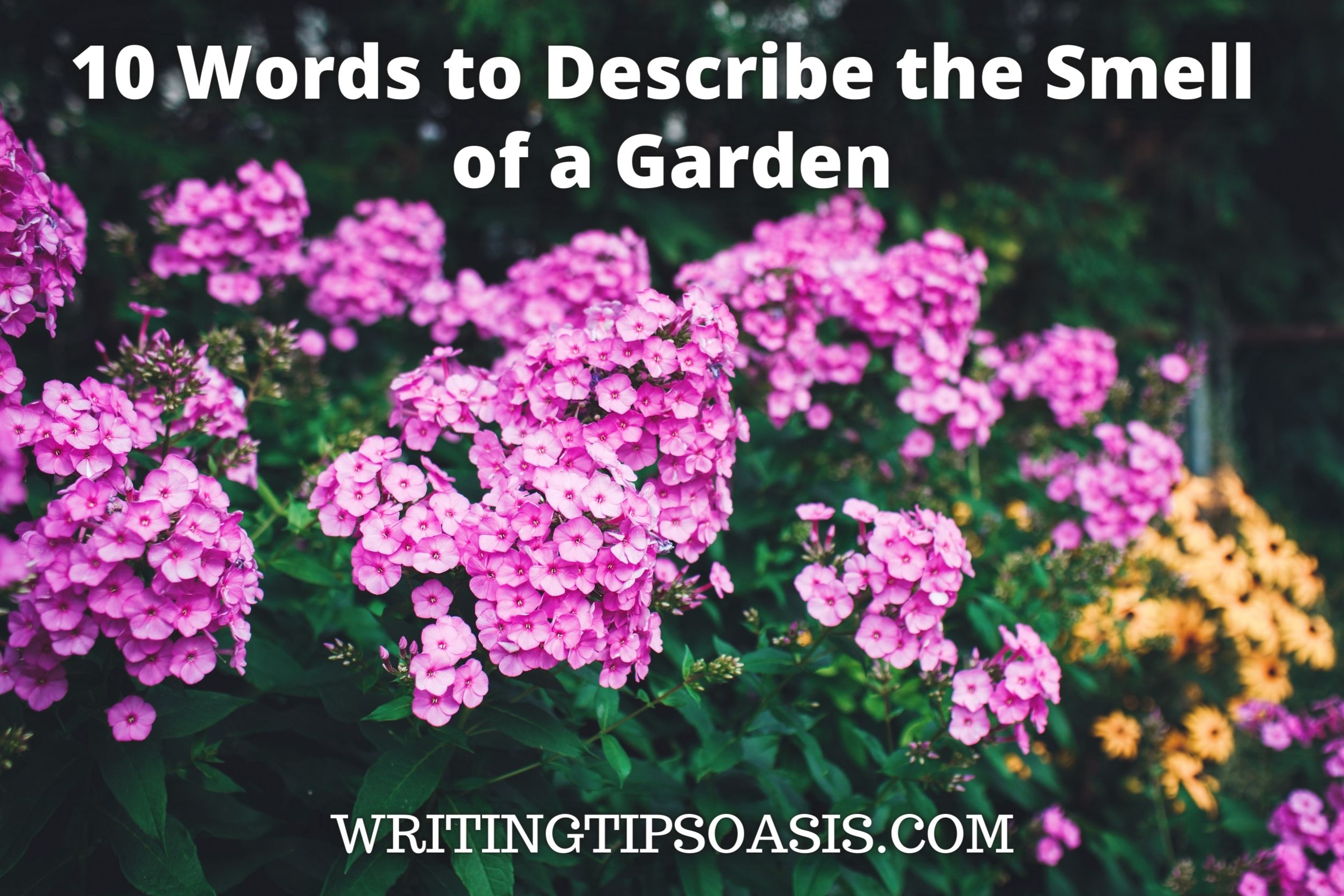
Are you writing a scene in your novel that is set in a garden? Let us give you some tips! Below, we’ve included 10 words to describe the smell of a garden.
A smell so bitter or unpleasant that it causes irritation to the eyes or nose.
“The acrid smell of the dying flowers in the garden was so overpowering that it actually brought tears to visitors’ eyes.”
“I don’t know what kind of flowers she planted but the smell was so acrid that I couldn’t stop coughing.”
How it Adds Description
Not all flowers give off a lovely smell. Some of the more beautiful flowers can actually give off a tangy, sour smell when blossoming. If you have a garden full of these flowers, describing the smell as acrid shows how overpowering it is and the physical effect it has on anyone who visits.
Characteristic of woodlands or areas covered in trees and wood.
“As soon as I entered the garden, I could smell the woodsy scent of the apple trees and mulberry bushes.”
“Pruning the branches of the lime trees and shrubs filled the garden with that woodsy scent of a forest in springtime.”
If you are describing a garden during fall or winter, then you want to highlight the lack of flowers by focusing on the fallen leaves and exposed branches and stems. Using woodsy evokes for the reader not just the smell of broken and bare branches and dried-out crunchy leaves but how they sound and look, as well.
Containing characteristics associated with earth , such as dirt, flowers, insects, etc.
“She loved the earthy smells of gardening: the upturned dirt, the newborn worms, the broken-down compost.”
“He always knew when the gardener was around as the earthy smells of mown grass and pruned flowers filled the house.”
Earthy calls to mind images of freshly plowed dirt and new flowers. Using earthy to describe the smell of a garden shows that the garden is in transition or being tended to. There are new flowers and smells to be found soon, but right now, the garden is mostly just moist dirt and compost.
So sweet that it’s almost sickening.
“The cloying smell of the sweet flowers overpowered their visual beauty.”
“The garden, when in full bloom, was cloyingly sweet; I couldn’t bear to visit until the flowers began to drop.”
Too much sweetness makes us feel sick. This goes for sweet smells, as well. If you have a small or enclosed garden with lots of sweet flowers blossoming, use cloying to show the reader how unpleasant the sickly-sweet smell can be.
- Without corruption or impurities.
- New or recently renewed.
“She took a deep breath and inhaled the fresh air of the garden.”
“You knew it was spring when the freshness of newly grown flowers filled the air.”
Springtime often brings new plants and flowers. Describing the smell as fresh shows how new these plants are and emphasizes that the flowers haven’t started blossoming yet; they’re still growing but should have their own aromas soon.
6. Perfumed
Filled with a sweet, pleasant smell.
“The perfumed aroma of the roses and lilacs in the garden lulled her into her happy place.”
“The garden smelled of perfume and rose petals.”
Perfumes often use flowers such as lilac, lavender, and roses to create their signature smells. Use perfumed to describe the smell of a garden shows that these flowers are likely planted there and creating a similar aroma, like walking through the perfume section of a department store.
Thin , almost nonexistent.
“The wispy smell of the few blossoming flowers greeted her at her back door.”
“We knew it was nearly spring time when we could detect the wispy aromas of lavender and mint in the garden.”
Sometimes, gardens don’t have an overpowering smell to them. Wispy suggests that there is only a hint of something in the air. Use wispy to show that the garden has only a few flowers or that the flowers it has don’t have a lot of smell.
Characteristics of fruit , particularly with regarding citrus or grapes.
“The fruity smells from the garden made my mouth water.”
“Whenever the garden smelled of ripening fruit , she remembered collecting fallen oranges from her grandmother’s backyard as a child.”
If the garden has more fruit trees or vines than they have flowers, then you might want to use fruity to describe its smell. Fruity is also a good word to describe a garden where the fruit has overripened and been left to rot in the dirt.
Having the freshness and sweetness of mint .
“The minty smell of the herb garden brought a freshness and lightness to the balcony.”
“I knew it was almost Christmas time when my herb garden smelled more of mint than anything else.”
Herb gardens are known for their smells as herbs can often have quite powerful aromas. Mint is probably the most powerful smelling of the herbs and is connected to certain types of foods and drinks. Describing the garden has minty taps into both the sense of smell and taste, as the reader can almost immediately recognize what the herb garden smells like while also imagining what the mint will be used to create.
Having a moldy smell as if from decay or degradation.
“The years of decaying leaves and flowers gave a musty smell to the abandoned garden.”
“We dug into the musty garden, ripping out dried out vines and piling dead leaves for burning.”
If you are describing a garden that has been neglected or abandoned, then you want to emphasize not only how many plants there are but also how dead or rotting they are. Use musty to describe the smell of these overgrown plants to help the reader see how degraded the garden has gotten over the years.

How To Describe A Garden?
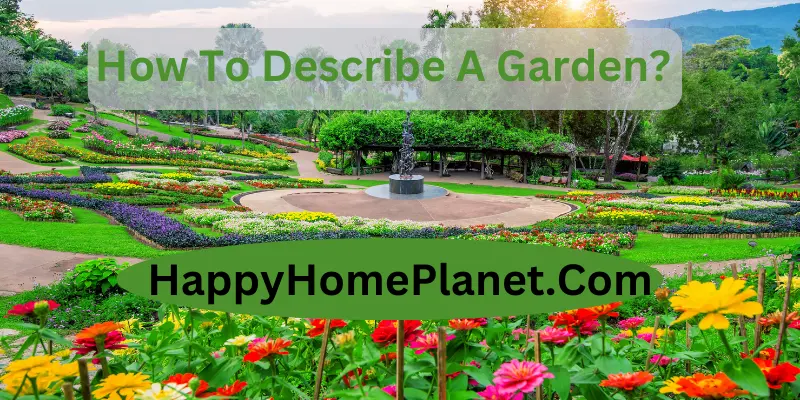
Describing a garden is an excellent way to paint a colorful picture of wonders of the nature. It allows to expression of scents, colors, emotions, and textures of the garden in the description. But how to describe a garden and engage the readers?
To make an intense and comprehensive garden description, observe your garden’s key aspects, use deep language, and structure the description. You can also include information about the garden’s visual beauty, sounds, scents, emotions, and texture to attract the reader.
Table of Contents
1. Visual Description
2. sensory description, 3. seasonal description, 4. cultural or historical description, 5. emotional description, 6. ecological description, 7. functional description, 8. personal description, observe the garden and take notes, engage the senses, use descriptive language, structure the description, share personal emotions and experiences, what are the key features to focus on when describing about garden, is there any example of a garden description, how to make the garden description more engaging, final words, some effective methods to describe a garden .
You can describe a garden in plenty of ways depending on your preferred aspects. Below are some simple ways to describe your garden:

This method focuses on the garden’s beauty and highlights its visual aspects. In this method, you can describe your garden’s shapes, colors, flowers, plants, and other architectural aspects. For example, you can describe you have lovely blooming flowers or a well-shaped topiary garden
In this method, you’ll need to engage the sense of your audience. It means you have to describe the scents coming from flowers. For example, roses produce a sweet scent and herbs make stimulating aromas. You can also mention the feel of the elements. For example, petal feels soft. Babbling brooks feel cool and tree bark has texture. Sensory method also allows us to discuss the Garden’s soundscape. It means you can discuss the rustling of wind’s leaves, chirping of birds, and a trickle of fountains.
The appearances of garden changes along with seasons and garden show a unique look in every season. For example, tulips and cherry blossoms come in spring, vibrant and lush greenery flowers come in summer and fiery colors show in autumn. Winter gardens get covered in frost and feel quiet beauty. So you can describe how garden changes in every season and show unique appearances.
If your garden has cultural or historical importance, you can highlight it. You can discuss your garden’s origins, famous figures, or occasions related to it. You can also mention any traditions, cultural practices, or ceremonies connected to your garden. This information will increase your garden’s cultural importance.
You can describe the feeling about your garden if it gives you joy, peace, or wonder. Then mention the specific elements that make you emotional. For example, the babbling brook’s calming effect, exciting colors, or yearning scent.
If your garden has ecological aspects that impact on environment, you can mention it and describe your garden. For example, you can discuss the plants that attract butterflies and bees or the presence of bird feeders. If your garden has a birdhouse that improves wildlife, you can highlight it. You can also mention your rainwater harvesting or composting if you do so.
If you use your garden for any specific purpose, you can also highlight it to describe your garden. For example, there are community gardens that allow about to get together, raise social communication, and improve food security. If your garden is used as a peaceful space for restoration and relaxation you can also mention it. Even if your garden provides shelter and food for local fauna, you can use this information to describe your garden.
This method will allow you to share personal memories, experiences, and connections with the garden. So you can describe the moments you spend in your garden. For example, if you spend a joyful time with your loved ones in this garden, you can highlight it. You can also share your relationship with this garden while describing it.
Tips To Make Garden Describing More Appealing
You can also show your colorful picture of your garden that you make capturing its unique beauty. Follow these tips to release your personal and creative viewpoint and mix memorable and emotional experiences to make a charming vegetable garden description:
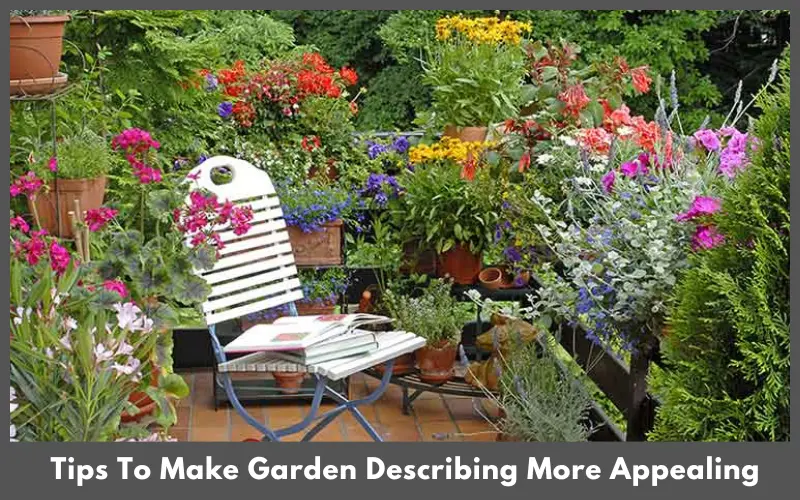
Spend some time in your garden to engage yourself and take the details about your garden. Carefully check the texture, shapes, colors, and arrangement of plants in the garden. Then note every unique feature of your garden. You can also record the specific sounds, scents, and atmosphere you find in the garden.
Describe the shapes, colors, and overall appearances of your garden. If your garden has luxurious greenery, vibrant flowers, and other design elements, you can highlight them. Carefully check the scents of your garden if it has smells of herbs, flowers, or other perfumed elements.
You can also note various elements in your garden including the petal’s softness, texture of leaves, or coolness of water. If your garden has rustling of leaves, chirping of birds, or other soundscape, listen and capture them. You can also describe any fruits growing in your garden and mention their culinary use and taste.
When describing your garden, use descriptive adjectives to make the description more attractive. Use symbols, images, and colorful imagery to make a brilliant of your garden. You can also include emotional feelings about your garden in the description. Provide more specific and detailed information in your description of the garden.
Write an engaging introduction and overview of the garden to set the tone. Divide the description into small paragraphs and focus on various features of the garden including trees, flowers, focal points, or pathways. Guide your reader smoothly from one area to another using transitions. Maintain the flow of description, start with a comprehensive view, and zoom in on the specific details gradually.
You can include your memories or experiences related to your garden in the garden. Describe your feelings about the garden and mention if it provides you inspiration or joy. If you have any unique stories connected with your garden, add them to the description. Engage your reader emotionally to make the description more impactful and relatable.
FAQs on How To Describe A Garden
When talking about your garden, target the key aspects that bring spirit to life. In this case, you can target the visual appeal of flowers, plants, and design features. Then mention sensory experiences like sounds, scents, and textures. The other features you should focus on are seasonal changes and characteristics, cultural or historical importance, and emotions about the garden. You can make an engaging and comprehensive description of your garden by focusing on these elements.
A garden is a lively place of scents and colors. It contains delicate roses and joyful sunflowers. It also has a lavender carpet and a scent of jasmine in the air. Its majestic trees make flower-shaped shadows in the ground to make a pleasant balance between structure and wildness. The bird’s sound and the fountain’s tricks in the garden make a calming soundtrack. A Garden is a mind-blowing place where time slows down and you can enjoy the beauty of nature.
Use descriptive language to make the garden description more engaging. You can also describe the energetic colors, soothing sounds, and delicate fragrances to engage the reader’s senses. Highlight the leave’s texture and use suggestive words to express the atmosphere. Mention your emotions and experiences in the description to make a better connection with the reader. Use specific details, and add personal perspective and feeling to make your garden description more attractive.
Knowing how to describe a garden is an excellent way to show its beauty to attract readers. In this case, you can use descriptive and intense language, and engage the senses. You can also focus on key features like sensory experience, visual appeal, cultural or historical importance, or seasonal characteristics to make a deep garden description. Highlight your personal and creative perspective in the description and paint a colorful picture to attract the reader to the charming world of the garden.
Subrata Nath
Subrata Nath here. I’m the founder of Happy Home Planet and a proficient blogger on this website. I enjoy creating content and posting how-to, tactics, and tips articles.
Leave a Reply Cancel reply
Your email address will not be published. Required fields are marked *
Save my name and email in this browser for the next time I comment.
Recent Posts
How To Take Pizza Out Of Oven?
With lots of cheese and a variety of toppings, pizza is not only appealing to eat but also sensitive to handle. However, the most dangerous step is to remove the pizza from the extremely hot...
Can I Eat Pizza With Braces?
Braces are handy appliances for plenty of reasons and correcting crooked teeth is the key to them. It helps align the upper and lower teeth properly. However, it’s a fairly slow process and the...

12 Nature-Inspired Creative Writing Prompts
by Melissa Donovan | Feb 20, 2018 | Creative Writing Prompts | 14 comments

Nature inspires, and so do these creative writing prompts.
Today’s post includes a selection of prompts from my book, 1200 Creative Writing Prompts . Enjoy!
Creative writing prompts are excellent tools for writers who are feeling uninspired or who simply want to tackle a new writing challenge. Today’s creative writing prompts focus on nature.
For centuries, writers have been composing poems that celebrate nature, stories that explore it, and essays that analyze it.
Nature is a huge source of inspiration for all creative people. You can find it heavily featured in film, television, art, and music.
Creative Writing Prompts
You can use these creative writing prompts in any way you choose. Sketch a scene, write a poem, draft a story, or compose an essay. The purpose of these prompts is to inspire you, so take the images they bring to your mind and run with them. And have fun!
- A young girl and her mother walk to the edge of a field, kneel down in the grass, and plant a tree.
- The protagonist wakes up in a seemingly endless field of wildflowers in full bloom with no idea how he or she got there.
- Write a piece using the following image: a smashed flower on the sidewalk.
- A family of five from a large, urban city decides to spend their one-week vacation camping.
- An elderly couple traveling through the desert spend an evening stargazing and sharing memories of their lives.
- A woman is working in her garden when she discovers an unusual egg.
- Write a piece using the following image: a clearing deep in the woods where sunlight filters through the overhead lattice of tree leaves.
- Some people are hiking in the woods when they are suddenly surrounded by hundreds of butterflies.
- A person who lives in a metropolitan apartment connects with nature through the birds that come to the window.
- Write a piece using the following image: an owl soaring through the night sky.
- A well-to-do family from the city that has lost all their wealth except an old, run-down farmhouse in the country. They are forced to move into it and learn to live humbly.
- Two adolescents, a sister and brother, are visiting their relatives’ farm and witness a sow giving birth.
Again, you can use these creative writing prompts to write anything at — poems, stories, songs, essays, blog posts, or just sit down and start freewriting.
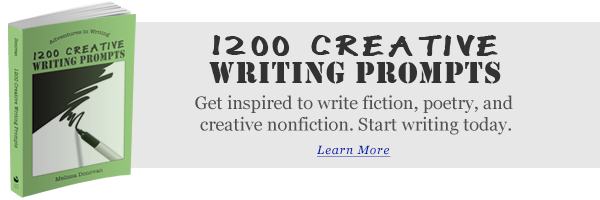
14 Comments
lovely prompts… really simple line or two that just strikes up imagery and let you freestyle all over it. Nice one
Thanks, Rory!
thanks for the good ideas good short story for someone in grade 8
Thanks. I just read through your list of prompts and got flashes of either beginnings or endings for stories from every one. I’ve not seen prmopts like these much on the web, so well done. Such a simple idea with so much power and potential. If only I had the day off to get cracking!
I love to create and use writing prompts, and I’m glad you found these to be useful. Thanks!
Hello. Supernatural or magic realism is pretty much all I write. I’ve got a prompt. ‘A young teenager is walking home during a storm and ends up getting struck by lightning. The next day they wake up to find that the accident turned them into an inhuman being.’ I’ve heard of this type of scenario before and I thought it would make for a great story. I love creating my own ideas of course but writing prompts are just fun challenge myself with and see what I can create out of already given ideas. I really like the prompts you give. As I said they are enjoyable to mess around with.
Thanks for sharing your prompt, Kristen. I agree that prompts are fun and can be challenging. I’m glad you like these. Keep writing!
#7 Woodland Clearing
Winter trees screen blue and sunny skies, Intense but icy light the heat belies. Spikey, naked, dormant maids and men Wait for the earth to turn around again.
And bring the warmth that touches every thread Of bark and twigs and all that acted dead Until the full-blown leaves create a wall Shortening the view until late fall
When sun and clouds break through the limbs again And show clear-cut those lacey maids and men Black for a time against the coldest air While waiting for the Spring to deck them fair
With leaves that seem to turn the world to green Creating hidden meadows only seen By animals and birds and mist and rains. For ages before calendars and trains.
Humanity intrudes in such a place And fools themselves that they have found a space Where they belong beneath the patchy light To rip and tear and exercise their might.
For meadow edges have no need to stand Between the woods and grassy, open land Where bugs and bears and buntings feel the sun. ‘Till people think they do what must be done.
April 27, 2019
Hi Jennifa. Thanks for sharing your lovely poem here.
That is a stunningly good poem, Jennifa. Far more worthy than just an obscure comment thread here. I hope you found a home for it where more eyes will see it. If you are published anywhere, I’d love to find out.
Wow. These are truly amazing prompts! Just a few lines of inspiration and now my mind is filled with creativity. Please come up with more! <3
You’ll find plenty more in the Writing Prompts Writing Prompts section of the Blog menu.
these are really helpful
Thanks, Flo! I’m glad you found them helpful.
Trackbacks/Pingbacks
- Readers & Writers United (wk 46 2010 overview) « Elsie Stills - [...] 12 Nature-Inspired Creative Writing Prompts (Stories – Tuesday 16 Nov.) [...]
- Writing Prompts: 37 Places to Find Them When You Need Inspiration - […] 12. 12 Nature-Inspired Creative Writing Prompts […]
- Here are three inspirational activities to elevate a writer's creativity - Judy Kundert - […] get an idea of how nature can inspire your creativity, try these Nature-Inspired Creative Writing Prompts from these 12…
Submit a Comment Cancel reply
Your email address will not be published. Required fields are marked *
This site uses Akismet to reduce spam. Learn how your comment data is processed .

Subscribe and get The Writer’s Creed graphic e-booklet, plus a weekly digest with the latest articles on writing, as well as special offers and exclusive content.

Recent Posts
- Writing Resources: No Plot? No Problem!
- Character-Driven Fiction Writing Prompts
- From 101 Creative Writing Exercises: Invention of Form
- How to Write Better Stories
- How to Start Writing Poetry
Write on, shine on!
Pin It on Pinterest
About Words – Cambridge Dictionary blog
Commenting on developments in the English language

Describing landscapes
by Kate Woodford

Have you ever wanted to describe an area of the countryside but found you didn’t have the right words? If so, we’ll fix that this week with a look at words and phrases that we use to describe different landscapes .
To start with the most basic description, an area of land that is mainly covered with grass or trees is often described as green : There are so few green spaces in the city. An area that is especially green, in a way that is attractive, may also be described as lush : lush green valleys . A more literary word for this is verdant : All around her were verdant meadows.
Meanwhile, a landscape that has few or no plants because there is so little rain may be described as arid : Few animals can survive in this arid desert landscape. (A technical description for an area that has little rain but is not completely dry is semi-arid : a semi-arid zone. )
Land that is extremely dry because rain has not fallen for a long time is often said to be parched : parched earth/fields. Sun-baked , meanwhile, describes land that is hard and dry because it has received so little rain for so long: The sun-baked earth was full of cracks.
Other words describe the shape of the land. A hilly area has lots of hills: The countryside round here is very hilly. The phrase rolling hills is often used in descriptions of attractive landscapes with many gentle hills: Everywhere you look, there are rolling hills. The rather literary word undulating is also used to describe this type of landscape: This picturesque village is surrounded by undulating hills.
Meanwhile, a landscape with bigger hills – mountains – is mountainous : a mountainous region . If those mountains have snow on the top, they are often referred to as snow-capped : a snow-capped mountain range.
Still with the shape of the land, craggy describes an area with lots of rocks sticking out: a craggy coastline. Rugged is very similar, describing an area of land that is wild and not flat: These photographs really capture the rugged landscape of the region.
Of course, not all landscapes are green and hilly. An area may be flat . If there are no trees, hills or other interesting features, it may appear rather featureless : It was a grey, featureless landscape.
Two negative adjectives that are sometimes used to describe featureless landscapes are bleak and desolate . Both are used for areas of the countryside that seem empty and cold, with nothing pleasant to look at: The house stands on a bleak hilltop.
Another adjective sometimes used in this context is windswept . A windswept area of land has no trees or other high structures to protect it from the wind: The picture shows a desolate, windswept landscape.
When were you last out in the countryside? How would you describe the landscape?
Share this:
- Click to share on Facebook (Opens in new window)
- Click to share on Twitter (Opens in new window)
- Click to share on Reddit (Opens in new window)
- Click to email a link to a friend (Opens in new window)
- Click to print (Opens in new window)
- Click to share on LinkedIn (Opens in new window)
- Click to share on Pinterest (Opens in new window)
45 thoughts on “ Describing landscapes ”
I was born in the countryside so my village is surrounded by beautiful green landscapes. It’s situated near the delta of the river Volga which is the longest river in Europe. Though a little bit far from the river there are sun-baked steppes. Some people find them featureless but I think every place on the Earth has its own charm. You can even see barkhan dunes there. It’s an amazing view. Last month I spent my holidays in Phuket, Thailand. It has so wonderful hilly landscape. There are so many jaw-dropping views there. It’s worth to be seen. Thank you for your posts! They all are very helpful!
That’s a very nice descriptive piece, Ekaterina. Thank you for that!
I agree with you, Ekaterina there is no place on the earth without a special way of charming.
Lush green vegetation from the Isle of Spice, is what I am looking at when I look out the window.
Lucky you! Sounds fabulous.
You got a point there
Pingback: Describing landscapes – Cambridge Dictionary About words blog (Nov 16, 2016) | Editorial Words
My live in Cauquenes a little town in Chile , this place is surrounded by trees and lush green areas, rather verdant meadows, my country also has the most arid desert in the world “Atacama Desert” amazing place to visit; for the most part of the center of the country we can find a semi-arid zone, mind-blowing beaches, rivers and rolling hills all converging in the central zone (which I live) quite mountainous by the way.
Thank you for the help with my vocabulary. regards.
You’re very welcome, Felipe! Thank you for the lovely description.
Pingback: Describing landscapes | Editorials Today
When I go to Tarhona, my countryside, the green spaces (the farms) in front of my eyes, the blue spaces (the sky) above my head and the golden spaces (the sand dune) behind my back is the poem that makes me dance with the pleasure of colours.
I live in a small town and like most of our inhabitants I also live in a block of flats. It doesn’t sound interesting at all but when I look out of the window I can see Black Sea coastline, I can sea its “mood” changing, its melting sunset and from the other window I can see mountains and today they are snow-capped they seem to exhale frosty air on our town. When I see these views I feel the eternity of life and nothing can trouble me.
I live in the main part of the city in Chennai, Tamil Nadu, India. I hardly find green spaces in the city. But God’s grace there is a park nearby where one can find some trees.
I used to live in a mountainous city, Amman – Jordan. Around 3 millions people is living on a 7 mountains. Transportation is not that easy in the city, in which lots of people still using long concrete stairs to move.
I am from Ipele in Nigeria, a beautiful small town surrounded by hills. Everywhere you turn your eyes, you see rolling hills so green and full of life. Should you move towards the eastern part of the town, you will encounter different species of trees hanging on the hills in a way that one will find it difficult to explain the friendship between nature and creation. Running slowing is a stream that runs from up one of the hills to form a pool at the lower valley. The pool is known as Ashiyan. At the other side and near the pool is another hill from under which a small spring do come out to form a small pool called Lala. The two pools are together but their water do not mix. Lala’s water is so crystal clear that people mostly take it for drinking while that of Ashiyan is brownish. It was rumored that if the two waters are put in the same glass bottle, the bottle will break. A remarkable observation is that the butterflies playing on the two pools are equally different as well. Colourful butterflies can be seen on Ashiyan while only white butterflies are seen on Lala. The breeze in the area is always lovingly cool no matter how hot the heat of the sunshine. Adding to the scene of the place are the melodious and beautiful sounds coming from the birds on the surrounding trees. The place possesses its own remarkable and special way of charming that is so striking.
lovely description
I live in Noida, India and it has very few green spaces left due to rapid urbanisation and industrialization. However, we can get to see lush in few parks but that is not sufficient for a healthy environment.
I live in hilly area, which could be described as countryside. The town is surrounded by trees and wood. There is many rolling hill and lush green landscapes.
please write about describing wind movement ( like windy day …) and also for rivers. Thankyou for this post . It is very helpful
Hi Meetu. Thanks for your nice comment. This blog might be of interest? https://dictionaryblog.cambridge.org/2017/04/26/sweltering-torrential-and-gusty-interesting-words-for-talking-about-weather/
Thank you very much for your reply. It is very helpful for us.
It is a very profitable blog post for me. I’ve enjoyed reading this. It is very informative and useful post.
Region where i live is featureless. i would love to reside near hilly or mountainous areas.however,in my country there is a huge lack of green spaces.
Hey i want to learn how to describe a landscape(which ever it is) in the most catching way. Can you help me out?
Reblogged this on NaN .
I was trying to do Geography homework and this didnt help at all.
Thank you very much, that was interesting !
Could you make an article about words describing the beauty of landscapes, like bucolic (or pastoral), and with adjectives or adverbs who help to imagine this beauty, like “as far as the eye can see”, please ? Thank you ! 😉
My hometown is a small village located in southeast of China where hilly spaces are everywhere covered with lush green forest. Far away from bustling city, inhabitants are living a slow-paced life-style here. Geographically, there is no mountain, no particularly worth-mentioning landscape. It would be a generally a flat and featureless land if it were without green spaces. Characterizing by a multitude of elderly people as the young are seeking prosperous in big city, my hometown has became a place without vitality.
Very helpful.
Dear Kate, Thank you for sharing the knowledge which is of great help for me.
Pingback: Describing landscapes – About Words – Cambridge Dictionaries Online blog | Qaawyrd-english
Thanks for your good explaination of landscapes
You’re very welcome!
Thanks for the lesson how I can express my emotions when I see different landscapes.
One of the most charming and picturesque places I’ve ever visited is by far the legendary Peles Castle, located nearby Sinaia, a mountainous Romania’s region. Well-known for being the first castle in Europe on having electricity, central heating, an elevator and even a mobile glass ceiling, among other innovative things, it’s surrounded by glamorous and lush gardens full of fantastic statues and vantage points with breathtaking views. If you want to escape the daily pressures of life, enjoying fascinatingly verdant and unspoilt places, Peles Castle and its undulating hills is definitely the one I’d recommend visiting. Exceeds all visitor’s expectations.
Well, Mihaela, you’ve made me really want to visit it! It sounds fantastic. Best wishes from Cambridge.
This is the way to learn English writing! This article is gem! Are there more articles like this? Thank you Kate!
Hi! Thank you so much! We haven’t written any more specifically on this theme, but we publish one every week (on a Wednesday) so do keep checking in. Also, you can search for posts containing specific words using the search facility on the right. Best wishes from Cambridge!
What an informative article never knew there were so many different ways to say landscaping. thanks again
Thanks, Hector! I’m so glad you found it interesting.
I live in a extraordinary place and wow. The hills are hilly and greens are greeny.
Thank you! It’s very useful!
Thanks you so much
Leave a Reply Cancel reply
Discover more from about words - cambridge dictionary blog.
Subscribe now to keep reading and get access to the full archive.
Type your email…
Continue reading
On writing about flowers and gardens

Last month, I joined the Fleurvana Virtual Summit as an instructor, sharing a 30-minute course with hundreds of attendees.
“ A Bouquet of Words : Develop Your Creative Vocabulary to Enhance Your Personal Storytelling and Brand Message ” introduced several important writing tools that help floral professionals with their marketing toolboxes. We walked through prompts to help creatives — florists, farmer-florists and flower farmers, and others — elevate their writing game and transcend commonly-used language to enhance their floral storytelling.
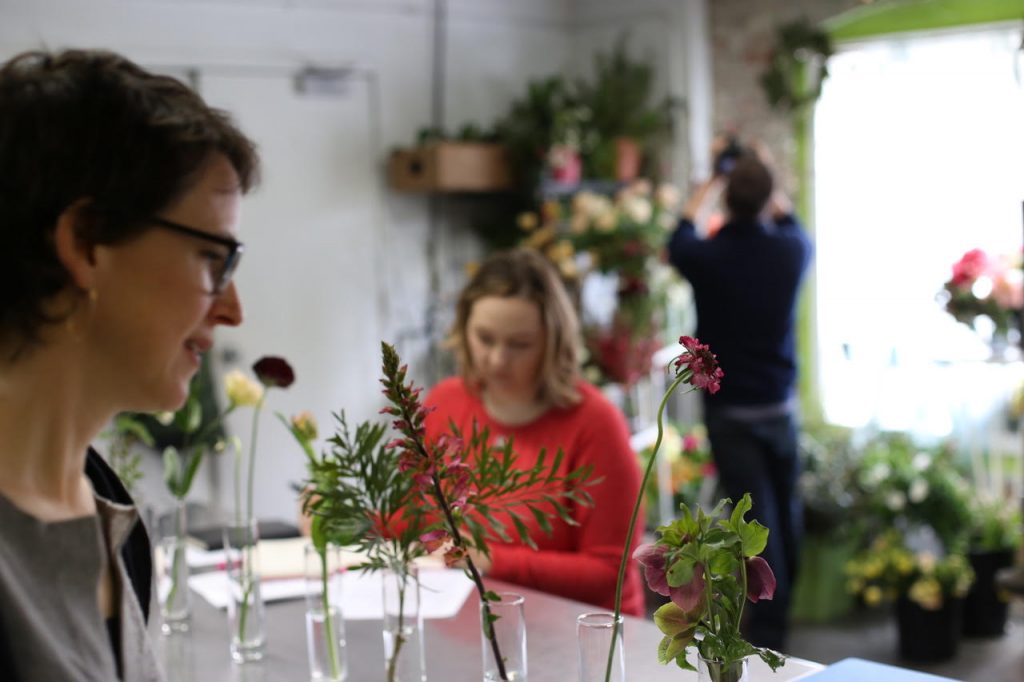
After the course posted on August 24th, several attendees reached out to share what they wrote in response to the exercises. I have permission to share from two of them here. And I’m inspired to tell you that the course was the most-watched Fleurvana offering. The act of writing or fear of writing can be a roadblock for all of us. But as I told the attendees, writing is a skill that takes repetition and habitual use.
Like anything worth achieving, frequent, daily use of your floral language and confident floral storytelling techniques will keep your writer-muscles strong.
Thank you to Denisa Anderson of Merrily Along Floral Design , and Maureen Christmas , AIFD, CFD, EMC, of Floral Notes Acton , for sharing their writing samples.
Floral narratives
Here’s what Denisa shared:
Thank you for the summit. What a constant source of ingenuity you are! I loved your creative writing tutorial. My mother was a creative writing teacher and is a published poet. I majored in language arts along with my education degree – later Library Science. All word-based loves, so very much in my wheelhouse. I used to write songs and play guitar but those days are in the past, for now ~ and my creative energy has waned this year. However, for fun I’m attempting a few short similes and metaphors to charge up the brain again! Thanks for a fun project.
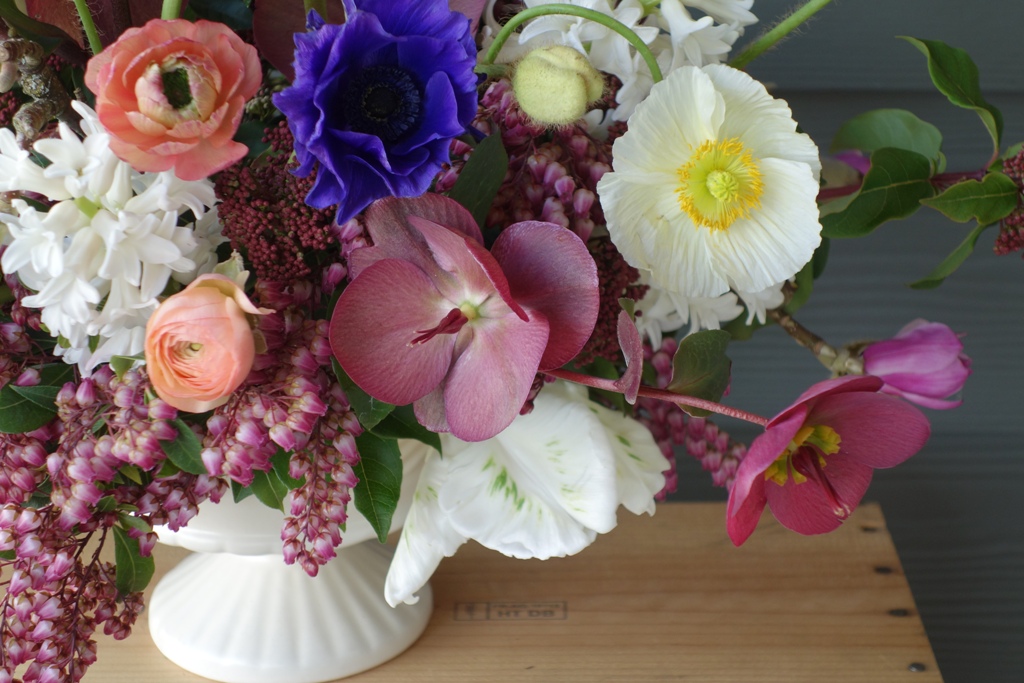
Describing plants and flowers
Here’s a message from Maureen:
I am inspired by your thought-provoking presentation this morning. (I even rewrote that sentence three times!)
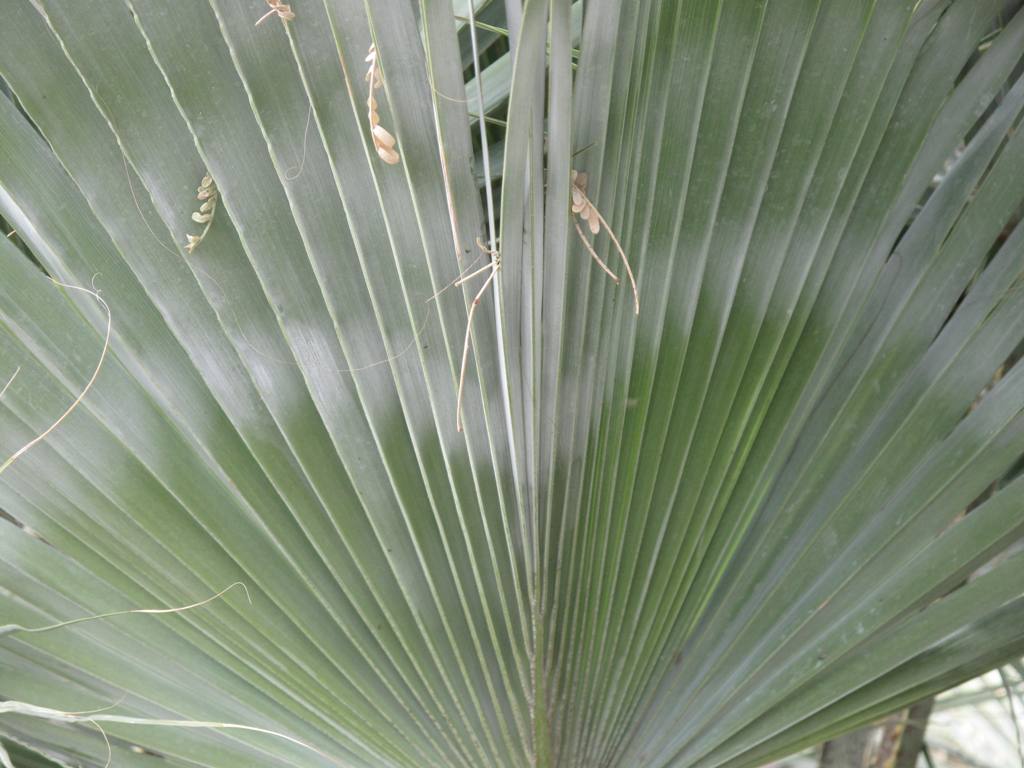
Language can be as personal and distinct as your aesthetic. In writing vernacular, it’s called “voice.” As you find your voice, you can use it as a tool to better communicate your brand, your unique perspective as an artist and the value it delivers to your clients.
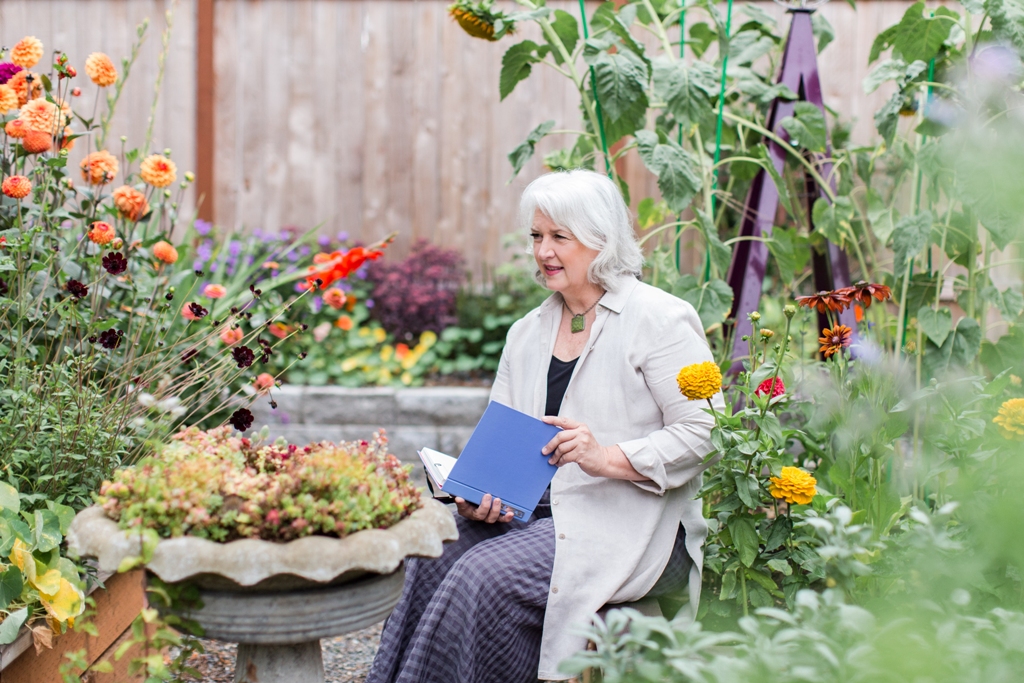
Coming up: You’re invited to sign up for my introductory Slow Flowers Creative Workshop , an online course, in which you will develop and write your juicy “about” description and use storytelling techniques to write at least one article or blog post for publication, not to mention work through expanded modules on floral adjectives, color descriptions and simile/metaphor modules.
The online Slow Flowers Creative Workshop launches November 1st Registration will open on October 15th, so click on this signup link to receive more details when we announce on October 1st.
And there’s more! The Fleurvana Holiday Workshop is coming up in late October — and I’ve been invited to join the instructor lineup again. Click here to be notified when that workshop is announced.
Debra Prinzing
Debra Prinzing is a Seattle-based writer, speaker and leading advocate for American-grown flowers. Through her many Slow Flowers-branded projects, she has convened a national conversation that encourages consumers and professionals alike to make conscious choices about their floral purchases. Debra is the producer of SlowFlowers.com, the weekly "Slow Flowers Podcast" and the American Flowers Week (June 28-July 4) campaign. Debra is author of 11 books, including Slow Flowers (2013), The 50 Mile Bouquet (2012) and Slow Flowers Journal (2020). She is the co-founder of BLOOM Imprint, the boutique publishing arm of Slow Flowers.
Giant Botanical Labryinth Sculpture by Australian artist Lara Rose Bos
Fall bulb planting in ag troughs, leave a reply cancel reply.
Your email address will not be published.
Save my name, email, and website in this browser for the next time I comment.
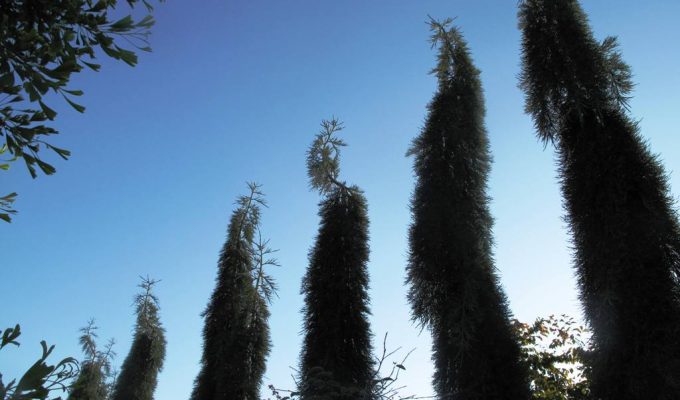
If these trees were human . . .
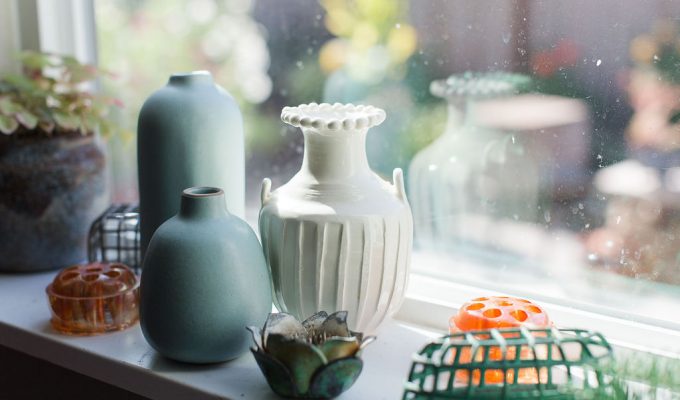
What’s on your windowsill?
Essay on My Garden for Students and Children
500+ words essay on my garden.
Essay on My Garden – A Garden is the best place in the house according to me. As it is the only place where a person can get relief from a busy life. Moreover having a garden in the house welcomes many health benefits. For instance, a garden has many plants that give oxygen.

Furthermore, the smell of the flowers can refresh a person’s mind in the morning. However, in this era, people are not able to build a garden, because of the lack of space. And also some think that it is a waste of space. So the gardens are no more present in the house. On the other hand gardens in the houses are necessary. In order to lead a peaceful life, a garden plays a major role.
My garden contains different types of plants. For instance, it has different flowers such as roses, sunflowers, Lilies, daisies. These flowers are the easiest to grow and flourish the environment with their beautiful smells. Moreover, the colors of these flowers make a garden look beautiful.
Further, my garden has different vegetables growing in them. For example vegetables like tomato, carrots, sweet potato, cauliflower, bell pepper, etc. These are the easiest to grow. Apart from this, they have various health benefits. Furthermore, this ensures that the vegetables are fresh and free from any chemicals.
The garden has grass all over the area. As a result, this makes it the best place for any exercise. Furthermore, it has a soft ground where children can play different sports.
This ensures that they do not get hurt even if they fall down while playing. Further, my garden has a swing too which is my favorite. Because I can spend hours swinging on it and do not get bored. Sometimes I spend my entire day in the garden completing all my tasks there. But this is only possible whenever I have a holiday.
Get the huge list of more than 500 Essay Topics and Ideas
The Gardener
As he loves taking care of the garden. Moreover, he is the only person who has set up the entire. My father is a nature lover. Therefore he takes out time from his busy schedule and takes care of the garden. He always tries new things in the garden. For instance last week he brought some new varieties of flowers. Some of them were climbers, bulbs, and perennials.

As a result, my garden is now full of flowers and is the brightest of all. Apart from my father, there is another person whom my father has appointed to take care of the garden. Because he has to stay away from the house so the gardener comes at that time. Furthermore, the work of grooming and cutting the plants is the duty of the gardener.
Birds in My Garden
Every day in the morning I can hear the chirping of many birds. Birds like sparrow, pigeon and Indian myna come to wake us up in the morning. Moreover, the peacock also comes occasionally in the garden. At that time the whole family gathers together to have a look at the beautiful feathers. In conclusion, the time spent in my garden is the most beautiful garden in the entire day.
{ “@context”: “https://schema.org”, “@type”: “FAQPage”, “mainEntity”: [{ “@type”: “Question”, “name”: “Name any two flowers that grow in a garden.”, “acceptedAnswer”: { “@type”: “Answer”, “text”: “The two flowers that grow in a garden are roses and sunflowers. Moreover, these flowers are the easiest to grow. Therefore they are found mostly in gardens.”} }, { “@type”: “Question”, “name”: “What are the benefits of having a garden in the house?”, “acceptedAnswer”: { “@type”: “Answer”, “text”:”The benefits of having a garden in the house are- the person gets fresh air in the environment of the benefits. Moreover, it enhances the look of the house and makes it beautiful.”} }] }
Customize your course in 30 seconds
Which class are you in.

- Travelling Essay
- Picnic Essay
- Our Country Essay
- My Parents Essay
- Essay on Favourite Personality
- Essay on Memorable Day of My Life
- Essay on Knowledge is Power
- Essay on Gurpurab
- Essay on My Favourite Season
- Essay on Types of Sports
Leave a Reply Cancel reply
Your email address will not be published. Required fields are marked *
Download the App

- Get gardening
An introduction to nature writing

On this page:
^ back to the top, 1. benefits for you, 2. why nature writing is good for your health, 3. finding sources of inspiration, 4. ekphrastic writing activity, 5. nature writing activity inspired by the soil, 6. roshni beeharry biography, benefits for you.
- Spending time in nature can make us feel refreshed and reduce stress
- As you gather inspiration, you can enjoy gardens and nature at a sensory level, no matter your knowledge of gardening
- Nature writing provides the opportunity for unrestricted creativity. You could write a poem, a short story or plan a longer piece of work
Why nature writing is good for your health

A person doing nature based writing in a notebook
By roshni beeharry.
The health benefits of being in nature and interacting with it are manifold. In the UK and further afield, gardening and forest therapy is sometimes recommended by healthcare professionals via social prescribing.
Being in nature is a well-established and powerful way to improve our wellbeing. This is partly through the much-needed chance to stop, take some time to rest and restore our energy from the demands of life and work.
Being outdoors, whether it is in your garden, local park or in a forest or in another landscape, is a great way to engage your senses. You can explore through sight, smell, texture, including the feel of the ground, grass or soil underfoot, plus what you can feel in your hands.
Nature writing, or writing inspired by the natural world, also allows us to engage all our senses. It offers the chance to hone our observation skills by engaging in the mindful practice of observing, smelling, feeling and sensing what is around us.
Many poets such as John Keats or Emily Dickinson, use nature as a basis of their writing. It is one of my favourite modes of writing inspiration.
It is also possible to write about nature by taking inspiration from representations of nature in art, such as visual arts, poetry, prose (fiction and nonfiction) as well as music and film.
My relationship with nature
I am passionate about nature. When I am under stress my go-to place is to get outdoors- as long as it has trees and greenery! Not only is this essential and highly therapeutic for my wellbeing, but it also inspires much of my writing, both poetry and prose (fiction and creative non-fiction).
I am very lucky to have grown up with a garden and even luckier to live back in the house I grew up in. Although with a seemingly endlessly long garden come the challenges of maintenance (not least the chores of weeding and grass cutting!), there is always something new popping up, even if it is a clump of weeds or some wildflowers. I often joke that the only surprises I like are those that nature offers. Seeing what pops up in the garden or my local park as time passes is really pleasurable.
Here is a poem I wrote with my garden at the heart of it:
This Garden
This garden
Holds many memories,
Of children’s parties
And laughter;
Of cricket games
With my brother;
Of fruit trees blossoming
And bearing fruit,
Year after year.
The wishing well
Sits majestically.
Once it was filled with seashells,
Souvenirs of holidays on the beach. Now it is empty,
The conifers line the fence,
Give shade against
The blazing sun.
The sweetpeas
Butterflies and bees
Cross paths in flight
But never collide. The poppies behind me
Are tightly shirt now,
Clasping their secrets. I will have to wait until
Next summer
To gaze upon their
Pretty pink faces.
Poem copyright of Roshni Beeharry, Highly Commended in Enfield Music and Drama Festival, 2000 and published in The Enfield Writers Workshop anthology 2001.
Nature is beautiful to look at and to immerse oneself in. It has been shown to have many health benefits. The ancient Japanese practice of shinrin-yoku or forest bathing, is based on the healing aspects of immersing oneself in nature (not limited to forests).
Finding sources of inspiration

A window box can be a source of nature writing inspiration
All sorts of types of nature can provide inspiration for nature writing. Parks and local green areas, an allotment, even a window box.
If you do not have easy access to an outdoor space for any reason, there is a wealth of online sources of nature inspiration. For example:
- The Natural History Museum, London website. Thoroughly recommended! This gives free access to some of the exhibitions and access to international nature landscapes
- National Geographic
- YouTube videos of bird song and sounds of nature, These can be very therapeutic as well as offering inspiration
You could also use photos you may have taken of landscapes on holiday or on travels as a stimulus.
Ekphrastic writing activity
One type of creative writing is ekphrastic writing . This is a vivid, often dramatic, description of a visual work of art, including painting, sculpture and music. The word ekphrasis comes from the Greek for the written description of a work of art produced as a rhetorical or literary exercise.
Here are two photos I have taken of my local country park, where I love to spend time, especially when life is frenetic!
Have a go at using one or both of these to write, using the suggested prompts.

Image of sunrise over a field with a variety of clouds, image by author
Writing prompts:
- What emotions do you feel when you look at this sky?
- Where are you in this picture? Are you sitting or standing? Are you alone or with someone?
- What does the temperature of the air feel like on your skin? What does the air smell like?
- What colours can you see?

Photo of sheep grazing in a field with trees, image by author
Use the same writing prompts as outlined above, but this time try writing from the viewpoint of one or more of the sheep!
- What is it thinking?
- What sort of conversation would the sheep be having together?
- Now imagine the farmer or landowner steps into the scene. What is he doing? What is he thinking? How do the sheep react?
Have fun with this piece of writing!
Once you have created one, or two, pieces of writing, congratulations! You have just written an ekphrastic piece of writing.
Nature writing activity inspired by the soil

Cupped hands full of soil
Here is a great way to get stuck in(to) the mud!
When you are gardening, be it weeding, planting bulbs, in the allotment harvesting or just potting a plant, think about and write afterwards how it feels to explore the soil with your senses.
You may normally wear gardening gloves, but if conditions and your health allows (some people may need to avoid the organisms in soil due to impaired immune systems), take your gloves off for this exercise.
You may wish to make notes on paper as you do each stage or use a Dictaphone or voice recording on your mobile or other device to capture your thoughts at each stage. Add in any illustrations to your notes if you wish and like to sketch.
At each stage, make notes/record your experiences. Do this where you are. Do not rush this experience. The notes do not have to be coherent. They can be a list of words, phrases, sentences, a poem, sketches - see what comes. I often find I doodle more when words don’t quite come, or as an accompaniment to poetry drafts or notes.
Some questions you may wish to ask yourself to stimulate your writing can include:
- What can you feel on your skin? What is the temperature?
- What is the texture of the earth-are there stones in it? Worms or other small creatures?
- Is the soil moist from rainfall or dry due to lack of rain?
- How does the soil smell?
- Are there any snails or worms or other creatures that you can see?
If you cannot use your hands easily, then use your forearm, elbow or an unsocked foot (this may be less easy to do). Do only what you feel comfortable to do and what feels safe to do so hygiene- wise. Be mindful to wash and dry hands / feet thoroughly afterwards.
Go through these stages:
- First, stroke your fingers (or toes) lightly in the soil as if you are swirling water in a bath to mix bath foam. Just do this on the top surface. Do this for as long as you wish, but for at least 3 minutes.
- Now, start to dig your fingers into the soil; just a few centimetres below the surface. Think about the emotions you are experiencing as you ‘dig deeper’. How does your body feel? Shift position if you need to.
- Now, scoop up some soil in your fingers. Raise your hand a few inches if you can, then let the soil drop from your fingers. Experiment with holding the soil in your palm and letting it fall from a clasped palm, an open hand tipped, your fingertips.
- Watch the soil fall. Does it fall in clumps, or is it dust-like? Are there stones? What can you hear? In your writing, you could introduce some poetic devices such as simile and metaphors, by considering what the falling soil reminds you of anything you can compare it to? Note down some similes and metaphors e.g the soil falls like dust from an ancient undisturbed box
- Hold the soil to your nose. What is the smell? Think of some words and jot them down e.g. earthy, light, heavy, pungent
Now close your eyes and repeat all of the above stages without the sensory input of vision. What impact does this have on the texture, temperature, smell, weight of the soil? What emotions do you feel when you cannot see what you are doing? How does your body feel? Shift position if you need to.
Digging for gold
Now, go over your notes again. Use phrases and words to create a piece of memoir, a short story or a poem.
List poems can be satisfying introductions to writing poems. For example, you may wish to fill in the gaps below using what you experienced above to create a list poem. This can encourage you to create some metaphors and similes and other imagery:
In my hands, I hold the earth and feel …
In my hands, I hold the earth and smell …..
In my hands, I hold the earth and sense ….
In my hands, I hold the earth and feel the weight of….
In my hands, I hold… it feels like…..it smells of/like
Play around with different ways of starting your list poem.
For inspiration, have a look at the link to the poem Digging by Irish poet, Seamus Heaney. He is writing about writing, but with the metaphors and language of the land and relating to memories of his father and boyhood.
Once you finished your work, read it back to yourself and be proud of what you have created. You may want to share it with others!
Inspiration is everywhere outside. It can encourage you to be mindful and look inwards, something we hardly have time to do in our fast paced lives. Welsh poet W.H. Davies (1871-1940) puts it well in his oft-quoted poem, Leisure .
Happy writing!
Roshni Beeharry biography

Roshni Beeharry
Dr Roshni Beeharry is a poet, short fiction writer, Medical Educator, former hospital doctor and Writing for Wellbeing Facilitator. In 2005, Roshni qualified on the seminal MA in Creative Writing & Personal Development, Sussex University, at the time the only degree of its kind in the UK, with the aim of using therapeutic writing with patients and the community. In October 2020, Roshni set up Storied Selves to provide writing for wellbeing and personal development workshops for those in healthcare and other care professionalism, as well as for the public, including an in person Nature writing workshop at Keats House museum and gardens in July 2019 and online since then.
Roshni has published internationally in print and online, in Litro, Writers’ Magazine, Atrium Press, Kind of a Hurricane Press, Wombwell Rainbow, Paragraph Planet, Tendon literary journal, These are the Hands: Poems from the Heart of the NHS anthology, Medical Woman and Writing in Practice journals. She was longlisted for the Aeon Prize 2012, highly commended in the Hippocrates Prize for Poetry & Medicine 2015, a finalist in Cuirt Literary Festival Spoken Word competition 2018 and longlisted for her young adult fiction in Northern Gravy in 2022.
Twitter: @roshni_beeharry
LinkedIn: Roshi Beeharry
Help us continue to make gardening accessible for all. Make a donation to Thrive today. Thank you.
Related content.

Why time in a garden can make you feel good
Spending time in nature can be good for our health and wellbeing. You don’t need a garden of your own to benefit. A simple planter or time in a park can still work wonders.
Gardening topic:
Health and wellbeing:.

Sign up to receive gardening inspiration and tips to get the most out of your own gardening space, and improve your health and wellbeing at the same time
Our use of cookies.
This website would like to set analytics cookies. These send information about how our site is used to a service called Google Analytics. We use this information to improve our site.
Read more about the cookies we use on our Cookies page .

Earthly Whispers: Describing Grass in Creative Writing
My name is Debbie, and I am passionate about developing a love for the written word and planting a seed that will grow into a powerful voice that can inspire many.

Earthly Whispers: Describing the Delicate Blades of Grass in Creative Writing
The textures:, the symphony of grass: capturing the gentle rustling and whistling sounds in words, a dance in the wind: depicting the graceful movement and swaying of grass, the aroma of nature: describing the earthy, fresh fragrance of verdant grass, enhancing your writing: tips and techniques for evocative grass descriptions, exploring techniques for evocative grass descriptions, bringing the outdoors to life: invigorating your prose with lively grass imagery, frequently asked questions, concluding remarks.
When it comes to creative writing, the world of nature serves as a boundless source of inspiration. Among the gentlest wonders that Earth has to offer are the delicate blades of grass that carpet our landscapes, silently adding a touch of tranquility to our lives. Describing the mesmerizing allure of these tiny plants can wonderfully enhance your writing, connecting readers to the beauty that lies beneath their feet. Allow your words to depict the lushness of grass, its hidden secrets waiting to be unveiled.
Start by imagining a sea of emerald green perfectly swaying in the wind, whispering sweet stories only decipherable by the curious observer. Picture the slender blades, sprouting effortlessly, inching their way upward towards the sun, each one a testament to resilience and tenacity. To capture its essence, consider evoking emotions that arise from its presence; it symbolizes renewal, refreshment, and the cycle of life. Employ vivid imagery to paint a vivid mental picture in the minds of your readers, allowing them to feel the gentle touch as they walk barefoot through a meadow, blades tickling the soles of their feet.

Unveiling the Subtle Beauty: Exploring the Intricate Shades and Textures of Grass
Grass, a seemingly ordinary part of our surroundings, often goes unnoticed and underappreciated. However, upon closer examination, one can unveil the hidden beauty that lies within this fascinating plant kingdom. With its diverse shades and textures, grass has so much more to offer than meets the eye.
Step into the enchanting world of grass and prepare to be mesmerized by its intricate shades. From vibrant emerald greens to subtle hints of olive, grass showcases a stunning palette of colors that evolve throughout the seasons. Whether it’s the fresh spring grass glistening with dewdrops or the rich, deep green of summer lawns, each hue has a unique story to tell as nature gracefully unfolds. This diverse array of colors brings harmony and life to our surroundings, creating a sense of tranquility and serenity.
Beyond its breathtaking shades, grass offers a world of intricate textures that effortlessly captivate our senses. Explore the velvety softness of a well-manicured lawn, where each blade of grass stands tall and equally pristine. Run your fingers over the fine, lush strands, delighting in their gentle caress against your skin.
But grass doesn’t limit itself to a single texture. Discover the playful variety as you encounter patches of rough and coarse grasses, adding a dynamic contrast to the landscape. Picture yourself walking barefoot on a dew-kissed meadow, feeling the ticklish sensation of sprawling, long blades gently brushing against your toes. The textures of grass serve as nature’s intricate tapestry, inviting us to connect with the Earth on a deeper level.
Just imagine strolling through a vast, green meadow, a gentle breeze brushing against your skin, and the orchestra of sounds that unveils as you step onto the lush carpet of grass. The symphony of this natural wonder is often overshadowed by the grandeur of other natural elements, but if one truly pays attention, the delicate rustling and whistling of grass blades can transport us to a tranquil and serene world. Let’s dive into the captivating nuances of this verdant orchestra and attempt to capture its essence through the artful arrangement of words.
The rustling sound of grass, like the soft whispers of secrets between friends, carries an air of delicate mystery. It is a symphony created by countless individual grass blades as they sway in the wind, effortlessly harmonizing their movements. The varying lengths, thicknesses, and textures of these blades contribute to the richness of the auditory experience. As each blade collides, brushing against its neighboring companions, a gentle chorus rises. It is a symphony that oscillates between a gentle hush and a playful whisper, reminiscent of the passage of time or even the circadian rhythm of nature herself.
- Subtle whistles: Amidst the rustles, the grass occasionally emits faint whistles, as if whispering secrets only audible to the keenest of listeners. These ethereal sounds, weaved into the fabric of the symphony, add an enchanting layer of detail to this performance of whispers.
- Seasonal variations: The symphony of grass is not static but is ever-changing, influenced by the seasons themselves. In the meadows of spring, the rustling may arise jubilantly, mimicking the delightful laughter of a flourishing ecosystem. However, in the serenades of winter, the grass may whisper more solemnly, as if sharing tales of stoicism and resilience.

Nature has always been an endless source of inspiration, captivating the human mind with its enchanting beauty. One such mesmerizing sight is that of grass gently swaying in the wind, gracefully dancing to the rhythm of nature’s symphony. The fluid motion and elegance portrayed by the blades of grass as they bend and twist create an ethereal spectacle, a true masterpiece of nature’s artistry.
The graceful movement and swaying of grass serves as a reminder of the delicate balance and harmony that exists within the natural world. Each blade, unique in its position and length, contributes to the overall choreography of this mystical dance in the wind. As the gentle breeze touches the surface, the blades respond, creating a mesmerizing visual display, too beautiful to be put into words.
The dance of the grass showcases the intricate connection between the elements of the environment. It symbolizes the delicate interplay of wind, sunlight, and soil, each playing a vital role in nurturing and sustaining this elegant spectacle. The wind acts as the conductor, leading the blades in a synchronized rhythm while allowing them to express their individuality. The warm embrace of sunlight provides the energy needed, propelling this dance forward, while the soil, the steadfast foundation, supports and anchors every movement.
It is in this harmonious movement of the grass that we witness the gentle power of nature and its ability to evoke a sense of peace and tranquility within us. Observing the dance in the wind, we are reminded of the interconnectedness of all living things and the beauty that comes from embracing diversity and allowing each unique element to contribute to the symphony of life. Just as the grass sways, we too should strive to move through life gracefully and adapt to the changing winds with resilience, always finding beauty in the dance.

The aroma of nature is a symphony for our olfactory senses, encompassing a myriad of captivating scents. Among them, the earthy, fresh fragrance of verdant grass stands out as a quintessential embodiment of the natural world. This distinct aroma transports us to idyllic landscapes, where blankets of lush green grass stretch out beneath open skies, beckoning us to indulge in its sensory allure.
Let’s embark on a sensory journey and explore the elements that contribute to the intoxicating scent of verdant grass:
- Chemical compounds: The distinct smell of grass is a result of several chemical compounds released by the plant. The most prominent one is geosmin , a microbial byproduct that lends earthy undertones to the aroma. Additionally, terpenes and pyrazines contribute to the fresh, green notes.
- Chlorophyll: The vibrant color of grass, derived from chlorophyll, is not only visually pleasing but also contributes to its fragrance. This essential pigment undergoes a process called volatile breakdown , releasing compounds that add to the sweet, hay-like scent of freshly mown grass.
- Nature’s breath: The verdant grasses of meadows and lawns interact with the surrounding environment, absorbing and releasing scents. These natural surroundings infuse the grass fragrance with hints of wildflowers , tree sap , and even the subtle muskiness of damp soil after a rainfall.
The aroma of verdant grass is nature’s poetry, a fragrant ode to the beauty of the Earth. Take a moment to immerse yourself in its earthy splendor and let the essence of the grass transport you to a tranquil place where the scent of the natural world revitalizes the spirit.
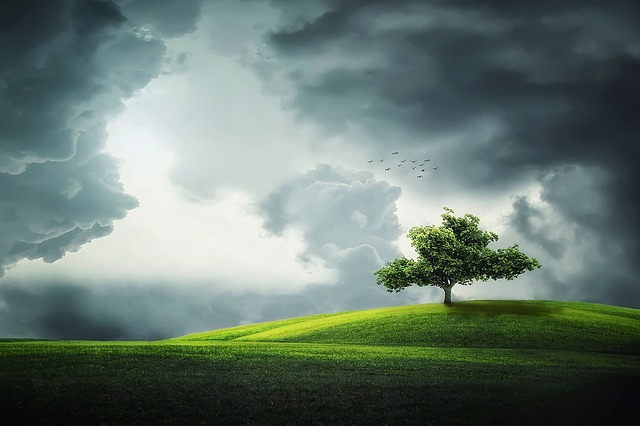
When it comes to capturing the essence of nature in your writing, the humble grass can be a powerful tool. Whether you’re a writer looking to add depth to your descriptions, or simply a nature enthusiast wanting to enhance your observations, these tips and techniques will help you create evocative grass descriptions that transport your readers to lush meadows and sun-kissed fields.
- Engage the senses: To make your grass descriptions truly come alive, evoke all five senses in your writing. Describe the soft touch of the blades against the skin, the earthy scent after a summer rain, the vibrant green hues dancing beneath the sunlight, the gentle rustling sound with each passing breeze — these details will immerse your readers in the natural world.
- Select powerful adjectives: Choose specific and vivid adjectives to breathe life into your grass descriptions. Instead of “green,” opt for “lush,” “emerald,” or “verdant.” Replace “ordinary” with “exquisite” or “enchanting.” Experiment with a variety of adjectives to find the ones that best convey the mood or atmosphere you are aiming for.
- Use metaphors and similes: Comparing grass to other objects or phenomena can add depth and interest to your descriptions. For example, you could liken the way grass bends in the wind to a graceful dancer, or compare its softness to a baby’s blanket. Metaphors and similes offer a fresh perspective and help readers visualize the grass in a unique and memorable way.
By incorporating these techniques into your writing, you’ll transform simple grass descriptions into vivid, sensory experiences that captivate your readers. So, grab your pen or open your word processor, and let your imagination wander through the sprawling fields of grass, ready to be beautifully depicted in your next piece of writing.
When it comes to writing vividly, incorporating the imagery of lush green grass can transport your readers to refreshing outdoor landscapes. By infusing your prose with lively grass imagery, you can invigorate your writing, adding depth and sensory appeal. Here are a few tips to help you bring this element to life in your writing:
- Powerful metaphors: Comparing the vibrancy of a character or a situation to a verdant field of grass creates a striking visual image that leaves a lasting impression on your readers. It can convey the idea of growth, vitality, and abundance, injecting energy into your narrative.
- Evoking sensations: Describing the feel of grass beneath one’s feet or the gentle rustle as the wind playfully caresses the blades can enhance the sensory experience for your readers. This tactile imagery allows them to connect on a deeper level, immersing themselves in your writing.
- Symbolic landscapes: Grass-covered landscapes can signify themes such as renewal, rebirth, or even hidden dangers lurking beneath a seemingly calm surface. Utilizing such imagery in a symbolic context can convey meanings beyond the literal, adding layers of complexity to your storytelling.
By incorporating lively grass imagery into your prose, you breathe life into your writing, adding an organic touch that engages your readers on a profound level. Whether you use it as a metaphor, to evoke sensations, or to convey deeper meanings, the grass becomes more than just green blades. It becomes a powerful tool to infuse your writing with energy, inviting your readers to walk barefoot on the lush landscapes of your imagination.
Q: What is the purpose of the article “Earthly Whispers: Describing Grass in Creative Writing”?
A: The purpose of this article is to provide writers with creative and effective ways to describe grass in their writing, helping them paint vivid images and engage readers on a deeper level.
Q: Why is it important to be able to describe grass effectively in creative writing?
A: Grass is a common element in outdoor settings and natural landscapes, making it a frequently mentioned subject in various pieces of writing. By developing the skill to describe grass with creativity and precision, writers can capture the essence of a scene and transport readers into the world they are creating.
Q: How can describing grass enhance the overall quality of creative writing?
A: By describing grass in compelling ways, writers can bring texture, color, and movement to their scenes. Such details help establish a sensory experience for readers, making it easier for them to visualize and immerse themselves in the story or setting.
Q: What are some techniques that can be used to describe grass effectively?
A: There are several techniques that writers can employ to describe grass creatively. These include using sensory language , employing metaphors or similes, exploring variations in color and texture, and highlighting the role of grass in specific environments or seasons.
Q: How can sensory language be utilized in describing grass?
A: Sensory language involves appealing to the reader’s senses, so when describing grass, a writer might capture the softness of the blades underfoot, the earthy aroma it emits, the sound of a gentle breeze rustling through it, or the sight of dew droplets glistening on its surface. Engaging multiple senses adds depth and richness to the imagery.
Q: Can you provide an example of a metaphor or simile that can be used to depict grass?
A: Certainly! For instance, one might describe grass as a “lush green carpet,” emphasizing its vibrant and uniform appearance. Another example is comparing grass to “nature’s paintbrush,” suggesting its ability to beautify landscapes and add splashes of color.
Q: How can variations in color and texture be used to describe grass?
A: Grass can have many shades of green, from emerald to olive or lime. By exploring these variations, writers can create a more nuanced and compelling description. Texture can also vary greatly, from coarse blades to soft, velvety patches. Describing these aspects can evoke different moods or feelings associated with grass.
Q: In what ways can grass be tied to specific environments or seasons?
A: Grass can serve as a representation of the environment it thrives in. For example, tall, wild grass gently swaying in the breeze may evoke images of meadows or countryside settings, while short and perfectly manicured grass may be associated with well-maintained city parks or gardens. By linking grass to its surroundings, writers can add depth to their descriptions.
Q: Any final tips for writers looking to excel in the art of describing grass?
A: Practice is key. Engage in observation exercises to familiarize yourself with the details of grass and experiment with different descriptive approaches. Additionally, reading and studying the works of seasoned writers who skillfully depict natural environments can offer inspiration and insights to further enhance your descriptive abilities. Remember, practice and exposure to different writing styles are essential in sharpening your craft.
In conclusion, “Earthly Whispers” highlights the importance of capturing the essence of grass in creative writing, allowing readers to connect with nature on a deeper level.
Middle School Inspiration: Writing Topics for 8th Graders
Coding Dilemmas: Can We Write Return Statement in Finally Block
Leave a Comment Cancel reply
Save my name, email, and website in this browser for the next time I comment.
Reach out to us for sponsorship opportunities.
Welcome to Creative Writing Prompts
At Creative Writing Prompts, we believe in the power of words to shape worlds. Our platform is a sanctuary for aspiring writers, seasoned wordsmiths, and everyone. Here, storytelling finds its home, and your creative journey begins its captivating voyage.
© 2024 Creativewriting-prompts.com
Quotes and Descriptions to Inspire Creative Writing Discover, Share, Connect
Search for creative inspiration
19,890 quotes, descriptions and writing prompts, 4,964 themes
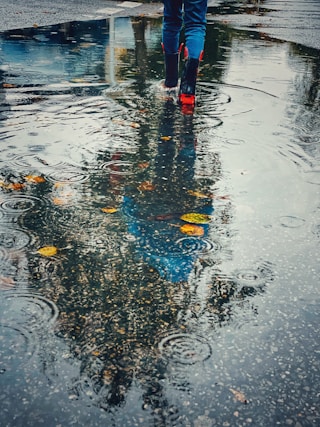
walking in the rain
I won't say I love the cold rain. I won't say I love being soaked to the skin. I won't say I'm alright with how long it takes for my boots to dry. But I will say it enlivens me and awakens a part of me that slumbers in the warm and sunny weather. I will say that jumping in puddles is fun and that I'm far too old to be enjoying such things. I will say that a part of me finds a beauty in wondering how many raindrops there are and listening for them in the meditative pitter patter.
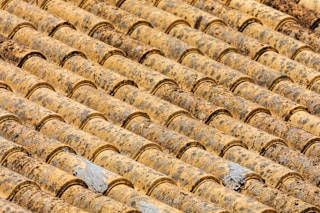
I wonder if the roof tiles miss the rain on these long summer days. I wonder if they miss making their together song. Or perhaps they await the tickle of bird feet and a hearth-warm breeze. Or maybe it is the variation that makes these seasons special.

It was a bonny path that chattered day and night, the free leaves upon it and their twig-attached brethren in seasonal conversation.

marvellous school of neurology
"It turns out, as obviousness would have it, that our brains (especially those of Stan Lee and Jack Kirby in this case) have been teaching us neurology through comic books and the movies that have come from them." Full article linked to from my profile, click "abraham" below, awesome!!

"When we make daily choices that are emotionally indifferent, the sort that the money-nexus makes faux-virtues of, we build our capacity for emotional indifference at the direct expense of our capacity for empathy, and thus the conflict between money and love is laid bare."

"Adjective and noun associations are worthy of our consideration because by careful linkage of words such as 'black' with strong emotionally positive words (such as in 'black heavens' and 'noble black night') we can start to program subconscious bias from the brain by creating a background neurochemistry that is more positive. This keeps the prefrontal cortex more fully operational and encourages more empathy in both thoughts and behaviours. Thus society develops better through their own choices and evolves. This is part of social evolution and this kind of awareness in writers is essential."

essential career advice for writers
"For writers in the next half century and beyond, a comprehension of how creative writing, neurology, biology and our environment interact will be essential for a successful career." - a link to the full article is in my bio and on the Descriptionari "About" page. Much love!!! Angela Abraham (Daisy)

blanket fort
In that artistry of wool, within a fabric that told of patient hours of tip-tapping knitting needles, we dwelled within a castle within our home.
Killing innocents kills innocence and all that remains is guilt; war is not a 'catch all' excuse.
Sign in or sign up for Descriptionar i
Sign up for descriptionar i, recover your descriptionar i password.
Keep track of your favorite writers on Descriptionari
We won't spam your account. Set your permissions during sign up or at any time afterward.

IMAGES
VIDEO
COMMENTS
Here is a quick summary of words to describe a flower garden: Words to describe a flower garden include colorful terms like "vibrant," "lush," and "fragrant," atmospheric words such as "tranquil" or "enchanting," and specific descriptors related to time, size, culture, and types of flora. Examples include "dawn-lit ...
Research: Do your research and find a masterclass or workshop that is focused on descriptive writing or creative writing in general. Instructor: ... In this guide, the writer has covered over 400 words to vividly describe a flower garden. Descriptive writing is an essential aspect of storytelling and essay writing. It helps the reader to ...
"He glanced around the serene flower garden, and everyone he saw was quiet and peaceful." "The serene flower garden was still despite the chaos outside its walls." How it Adds Description. Gardens, flowers, and natural spaces are usually quiet and calm areas, therefore the word "serene" is apt to describe their ambience.
When describing textures, it is important to use descriptive words that convey the feel of the object. For example, instead of saying "the leaves were bumpy," try using words like "wrinkled," "ridged," or "crinkled." Overall, taking note of the colors and textures in a garden is essential when describing it.
Marketing by. When it comes to describing a garden, it is possible to describe the taste of certain plants or even what they feel like. For example, the photo above is dill weed. Dill weed has a slightly tangy taste often associated with pickles and the plant itself is very soft to the touch sort of like a feather, but you will notice the ...
A description is a word or phrase that describes someone or something. An example of a description is the word "blue" which describes the color of the sky. When writing about a garden, it is important to choose descriptive words that will help paint a picture for the reader. Here are some tips for writing about your favorite outdoor space:
Creative Writing is a form of descriptive words Writing where creativity is at the forefront of its purpose. Here the writer must use his imagination, creativity, and innovation to tell a story through strong written visuals. Creative Writing is probably one of the most challenging sections of the 11+ exams for many students. The reason is that ...
Garden. - quotes and descriptions to inspire creative writing. In this garden we guard the den of nature, for here we bare our souls in such nurturing safety. By Angela Abraham, @daisydescriptionari, December 14, 2020 . The garden gave us sanctuary and so we made sure to plant the kind of flora that did the same for mother nature.
How it Adds Description. If the garden has more fruit trees or vines than they have flowers, then you might want to use fruity to describe its smell. Fruity is also a good word to describe a garden where the fruit has overripened and been left to rot in the dirt. 9. Minty Definition. Having the freshness and sweetness of mint. Examples
1. Visual Description. This method focuses on the garden's beauty and highlights its visual aspects. In this method, you can describe your garden's shapes, colors, flowers, plants, and other architectural aspects. For example, you can describe you have lovely blooming flowers or a well-shaped topiary garden. 2.
Nature inspires, and so do these creative writing prompts. Today's post includes a selection of prompts from my book, 1200 Creative Writing Prompts. Enjoy! Creative writing prompts are excellent tools for writers who are feeling uninspired or who simply want to tackle a new writing challenge. Today's creative writing prompts focus on nature.
To start with the most basic description, an area of land that is mainly covered with grass or trees is often described as green: There are so few green spaces in the city. An area that is especially green, in a way that is attractive, may also be described as lush: lush green valleys. A more literary word for this is verdant: All around her ...
September 23, 2020. On writing about flowers and gardens. by Debra Prinzing. 0. Deidre Morrison finds a quiet moment to write at the PepperHarrow Farm + Slow Flowers Creative Workshop in 2018 (c) Liz Brown @estorie. Last month, I joined the Fleurvana Virtual Summit as an instructor, sharing a 30-minute course with hundreds of attendees.
500+ Words Essay on My Garden. Essay on My Garden - A Garden is the best place in the house according to me. As it is the only place where a person can get relief from a busy life. Moreover having a garden in the house welcomes many health benefits. For instance, a garden has many plants that give oxygen. Furthermore, the smell of the flowers ...
flowers - quotes and descriptions to inspire creative writing. flowers. - quotes and descriptions to inspire creative writing. Flowers billowed gaily, sailing and anchored, so very buoyant in a nectar onshore wind. By Angela Abraham, @daisydescriptionari, September 12, 2023 . The grass was the green canvas of the floral flash-mob: a pop art ...
One type of creative writing is ekphrastic writing. This is a vivid, often dramatic, description of a visual work of art, including painting, sculpture and music. The word ekphrasis comes from the Greek for the written description of a work of art produced as a rhetorical or literary exercise.
Descriptive Essay About A Garden. Satisfactory Essays. 1150 Words. 5 Pages. Open Document. Garden Box The sun is shining bright over the rows of newly sprouted vegetables and fruits. Bright red strawberries peak out from under dark green leaves. The thin leaves of the corn plants rustle in the breeze. A wooden basket rests at my feet identical ...
In each garden is a cyclic narrative, containers of our vast memories and dreamscapes. Here are a few writing prompts inspired by botanical things. Agave. Write a revelation that happens in the time it takes the character to sew a tiny garment. Blue Hibiscus. Write about a quarreling household that is preparing for an unprecedented season of frost.
Grass, a ubiquitous yet extraordinary element of our natural landscape, has allured writers for centuries. Describing grass in creative writing encompasses a delicate art of capturing its essence. From its emerald shades to its gentle sway, let's explore the Earth's whispering carpet in our literary endeavors.
It is advice on how to break free of cliche approaches to painting, but it applies almost just as well to writing. The first step to vividly describing a place, person, or thing is to imagine it in your mind's eye. Alternately, if it actually exists you may prefer to look at it or a photograph directly. Either way, you'll start with some ...
Write a detailed description of your garden tour — where you stop, what features you point out, what you talk about. Think about a person who inspires you or whom you consider a hero. Make a list of their traits and, using these, match them to something in nature — a tree, mountain, desert, flower, insect, animal, etc. Write a short story ...
There are many ways to express ourselves, and writing is one of the main ones. The written word can convey ideas in countless formats, styles, and combinations. How do you get youth excited about writing? The garden, of course! Filled with colors, sounds, textures, and scents, a garden provides boundless opportunities to use language to describe observations, make comparisons, and convey the ...
love nexus. "When we make daily choices that are emotionally indifferent, the sort that the money-nexus makes faux-virtues of, we build our capacity for emotional indifference at the direct expense of our capacity for empathy, and thus the conflict between money and love is laid bare." Creative writing ideas by abraham.